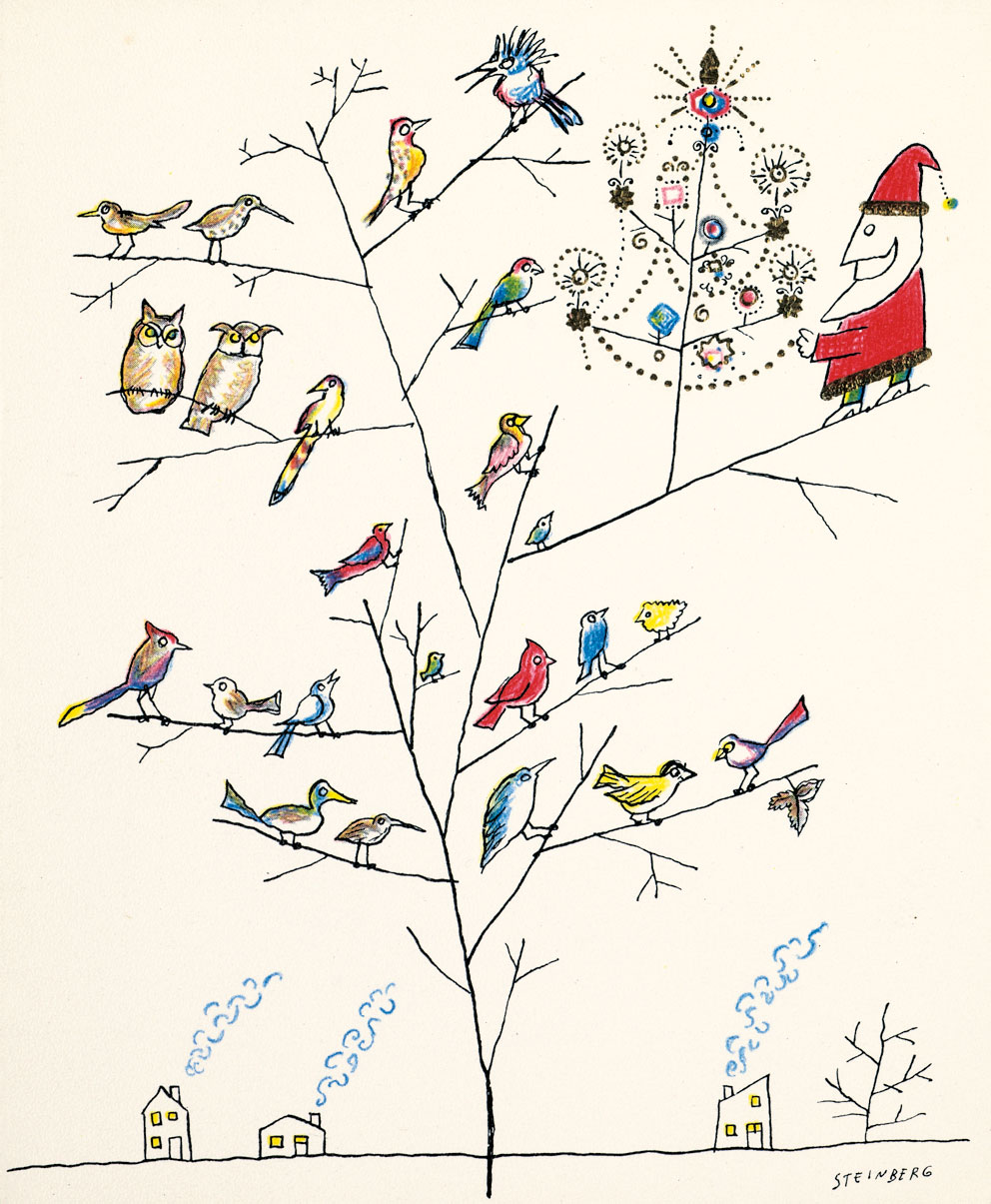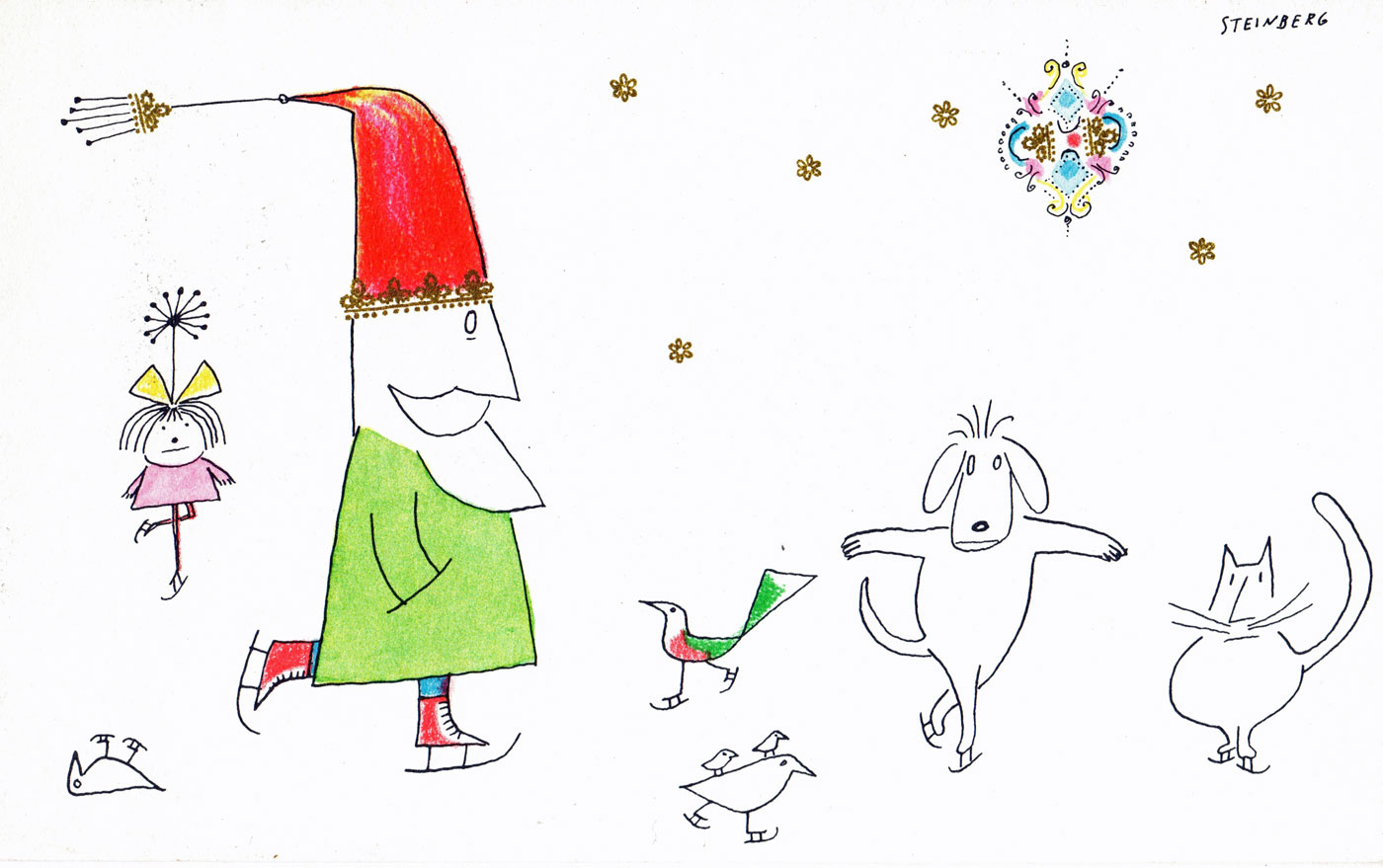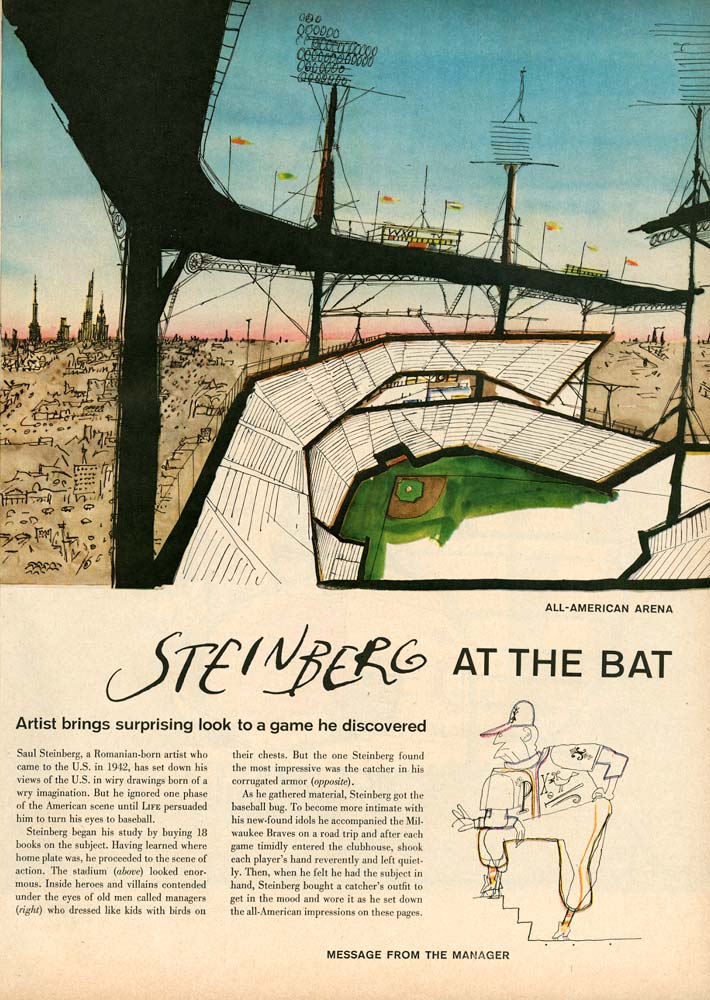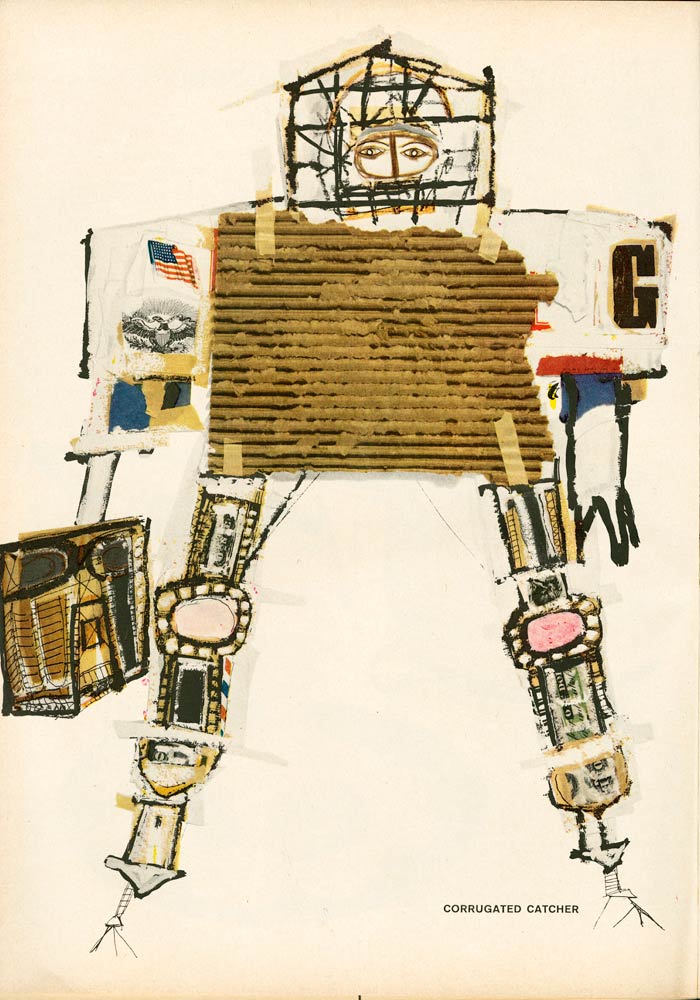Sections
1950
In the March and September issues of Flair, publishes influential inset booklets of “photoworks”—images that combine photography and drawing.
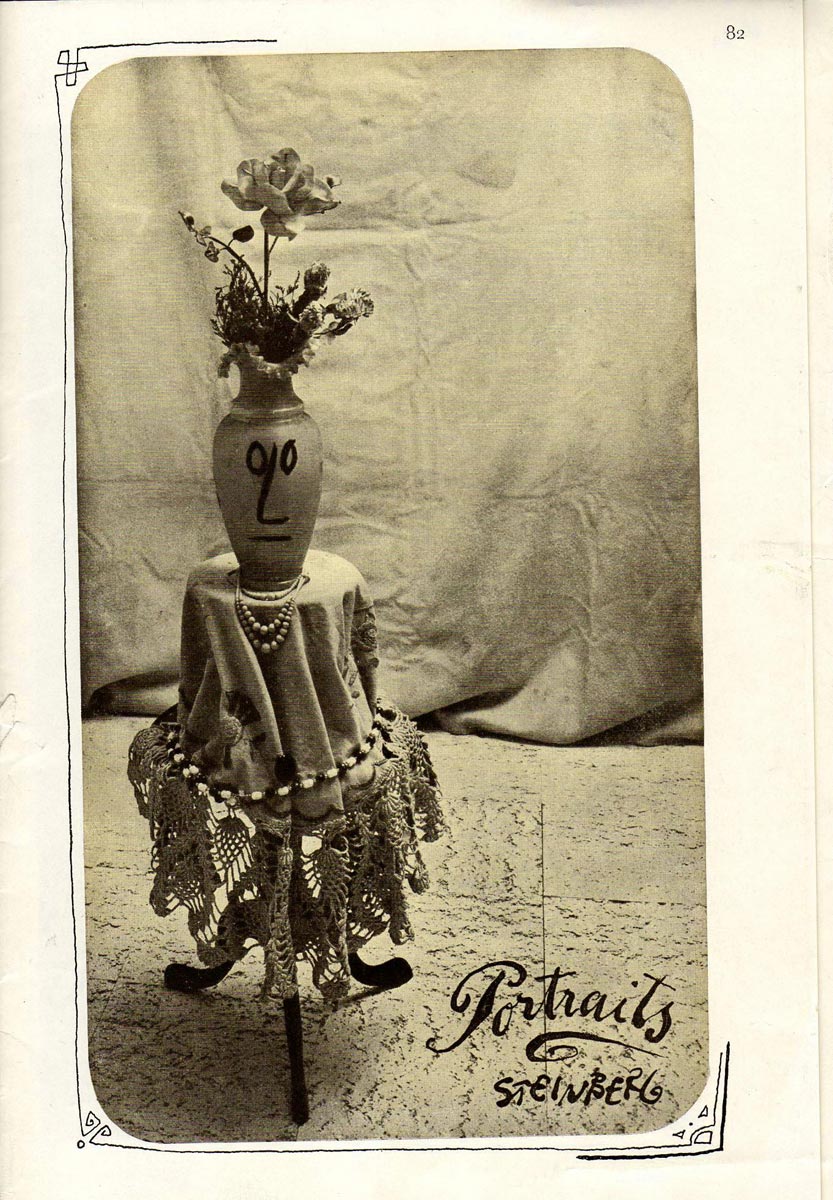

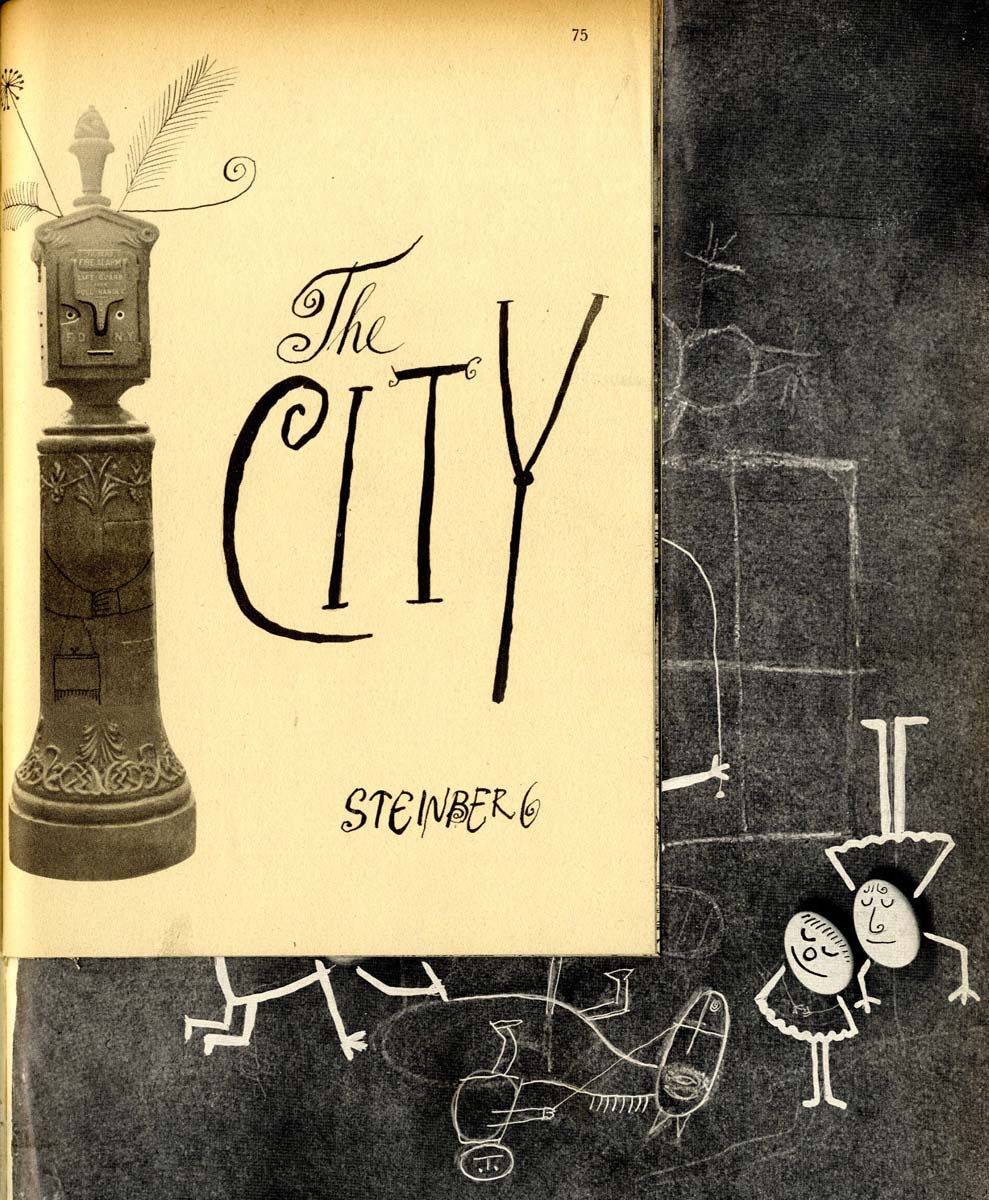
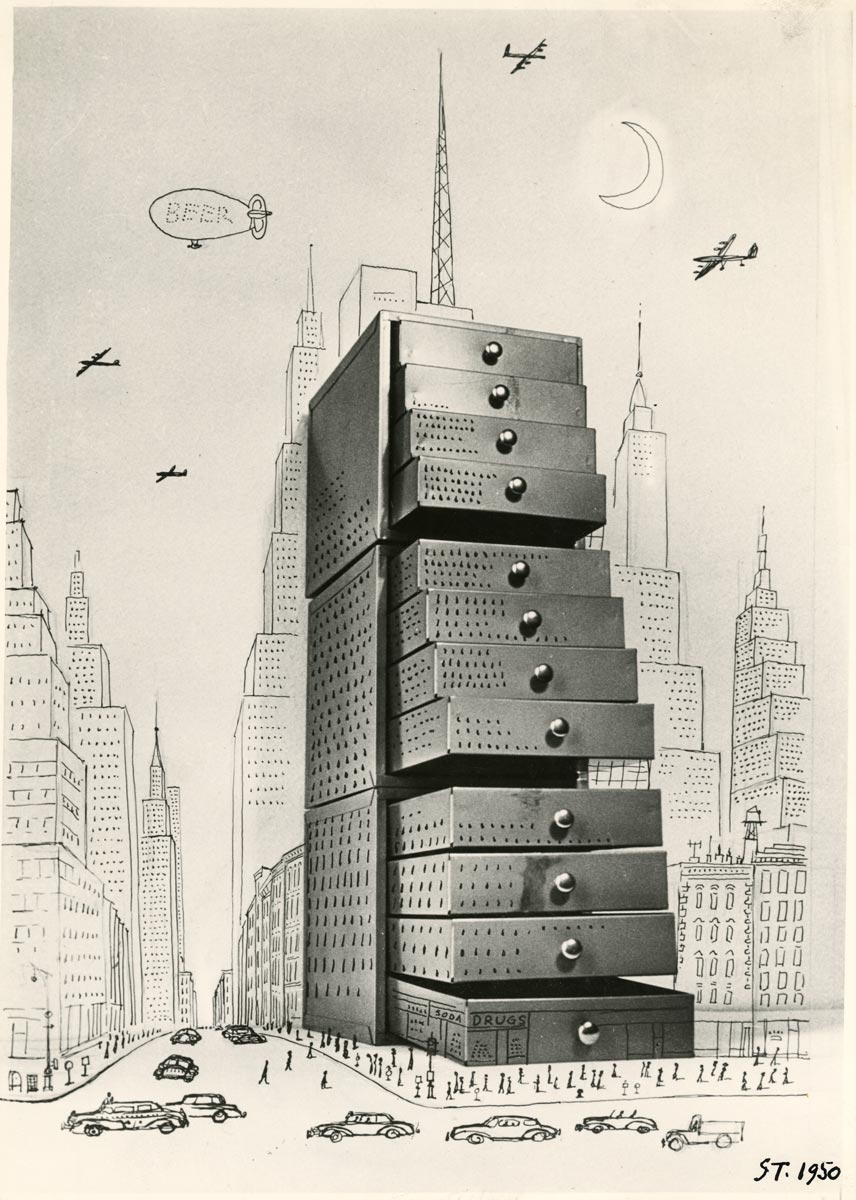
Summer, is hired to play Gene Kelly’s painting-hand in the film An American in Paris. Goes to Los Angeles with Hedda, rents a house in Brentwood, but walks off the film set on the first day. “They summoned me with great promises of ‘a free hand, do what you want,’ but they turned out to be the usual pricks who make Technicolor musicals, stupid stuff.”
ST and Hedda remain in Los Angeles for the summer, socializing with Kelly, Billy Wilder, Oscar Levant, Igor Stravinsky, Christopher Isherwood, and Charles and Ray Eames. ST makes sketches of the LA scene, which will be published in a New Yorker portfolio “The Coast” (January 27, 1951). “I’m doing a series of drawings on California,” he writes to Aldo Buzzi. “Quite difficult because the reality is too peculiar, as hard to draw as the circus, you must keep making an effort not to fall into clichés.”
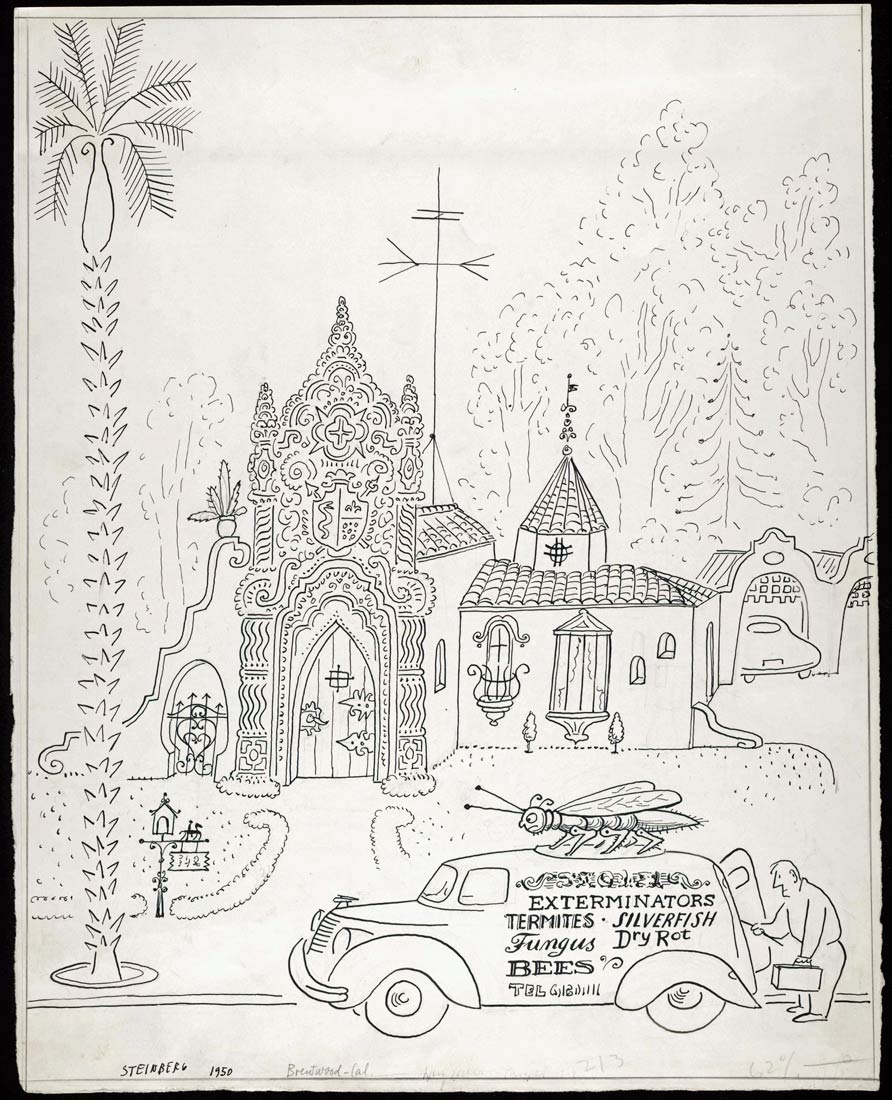
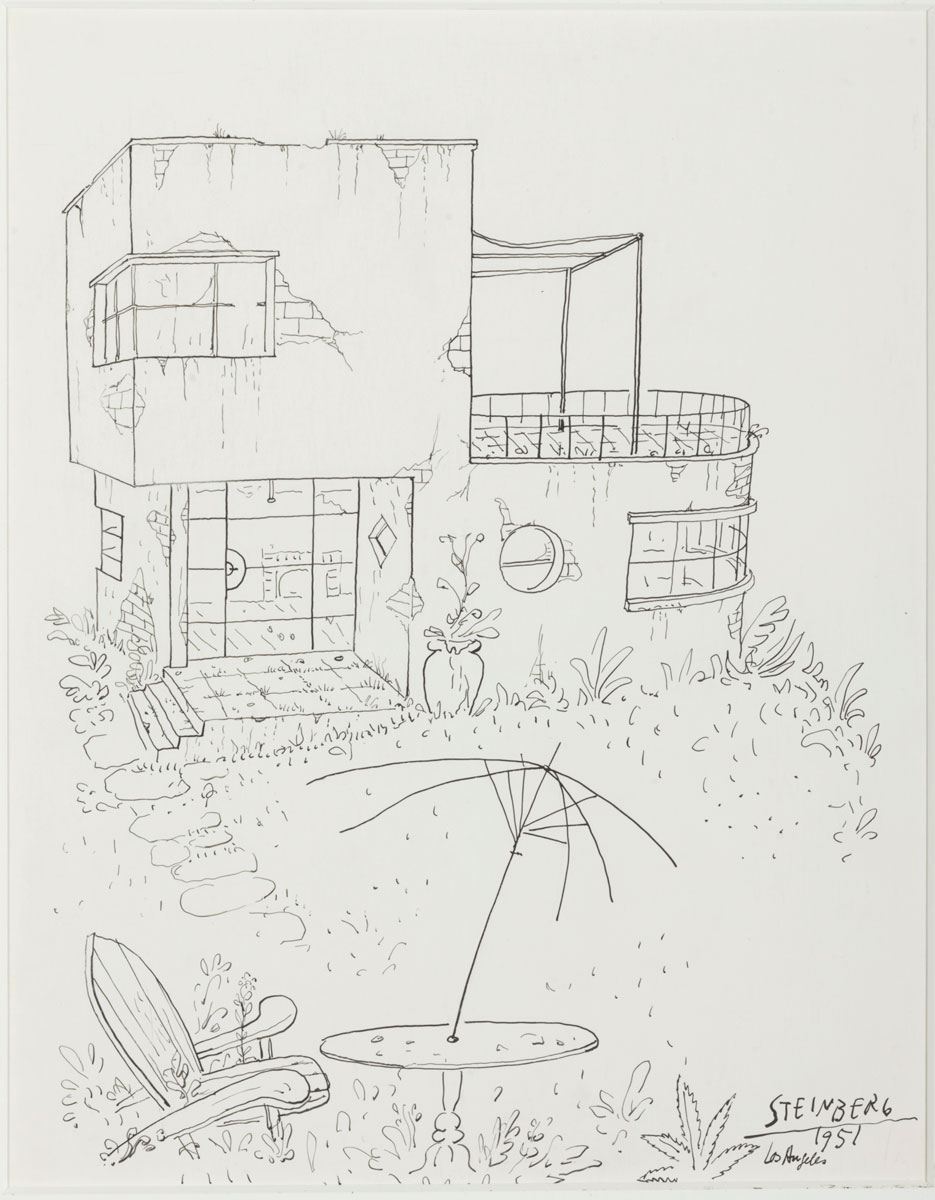
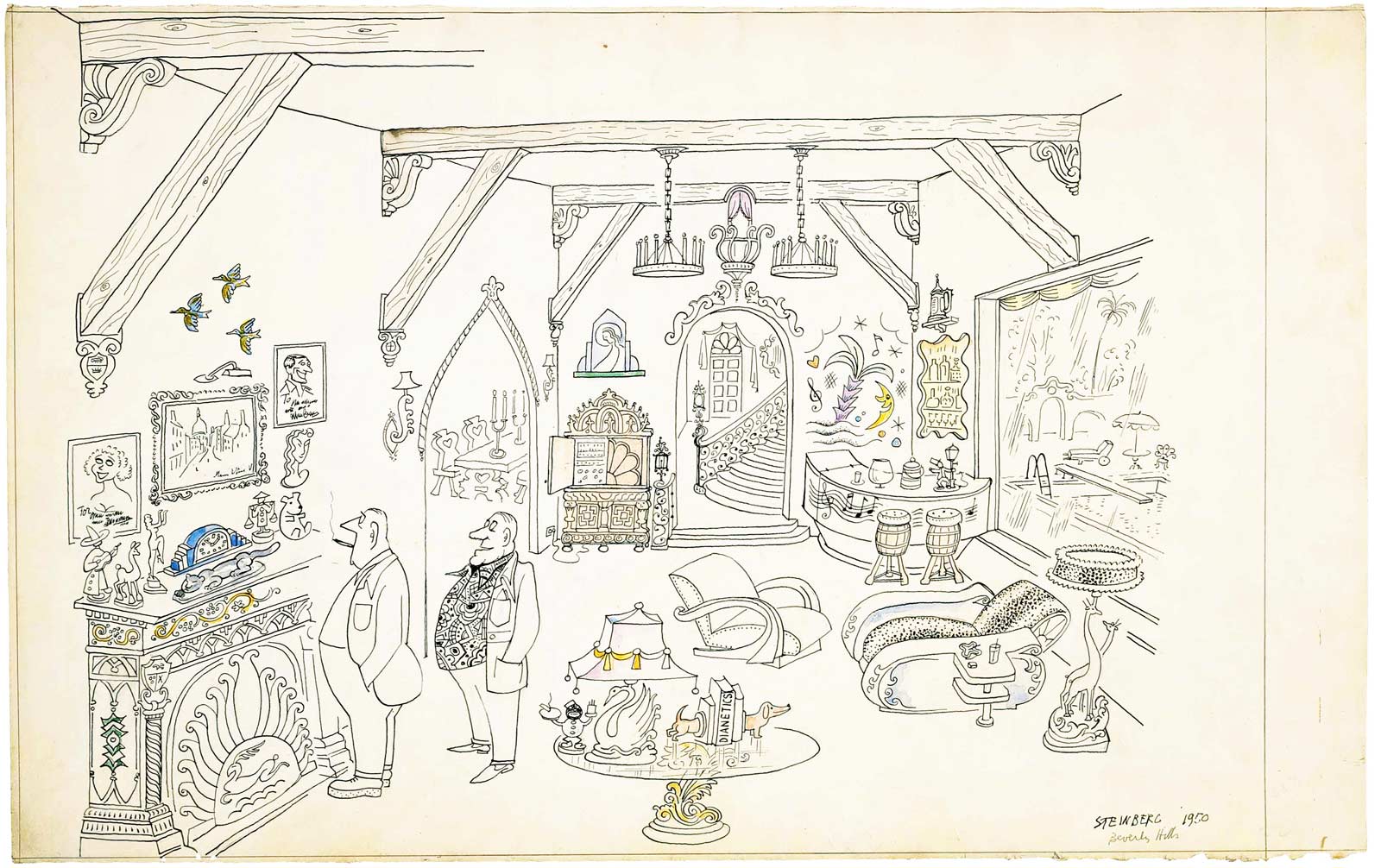
Eames proposes making a movie of an ST drawing (unrealized). ST visits the Eames Office in Venice, California, and adds drawn figures to Eames’s newly designed fiberglass armchairs and other chairs, the first in a series of such works.
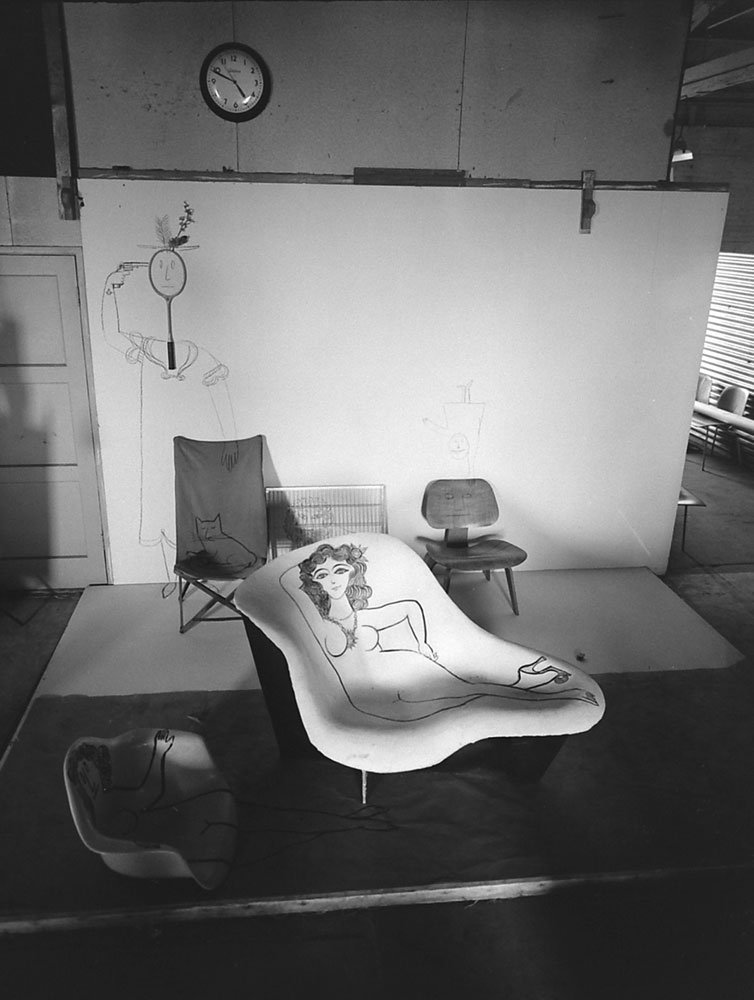

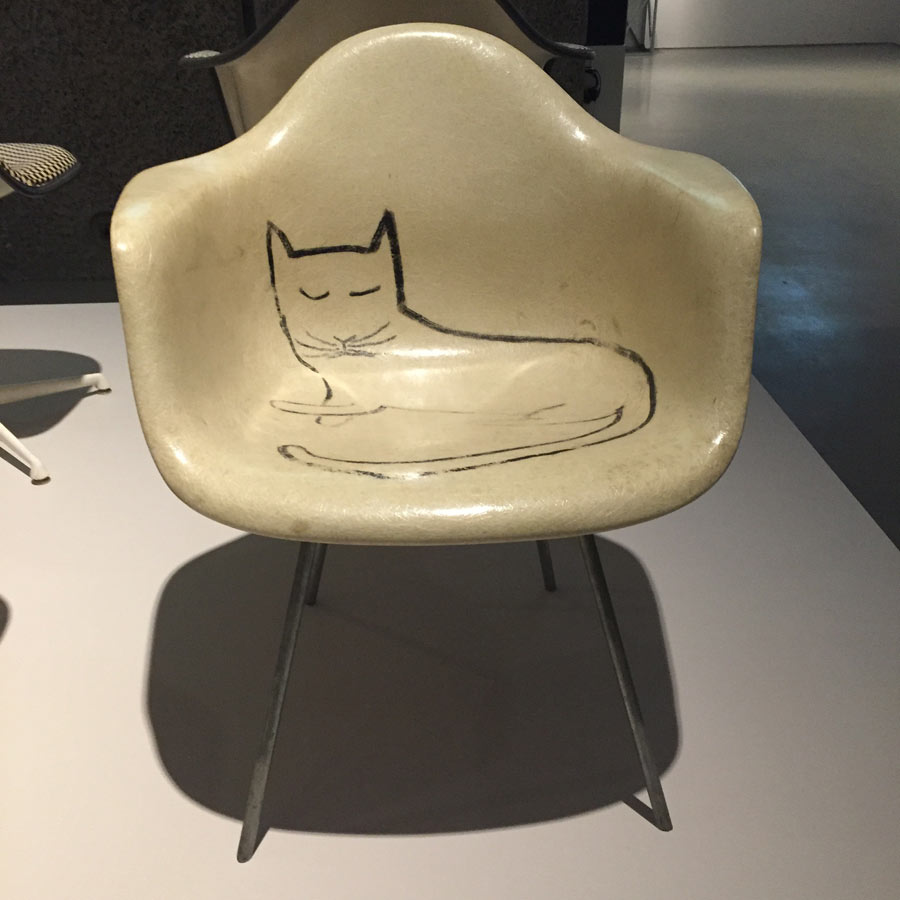
Returns to New York in early September, via bus to Denver and the Plains states; gambles in Las Vegas. He describes the trip to Aldo Buzzi: “In Las Vegas, in various gambling dens, I won two thousand dollars at the climax of 24 hours of continuous gambling (separately or simultaneously I played roulette, dice, chemin-de-fer, poker, and horse racing)….[Las Vegas] is the freest place in the world, I think. Every house is a casinò [gambling den] or a casino [brothel] or both.”
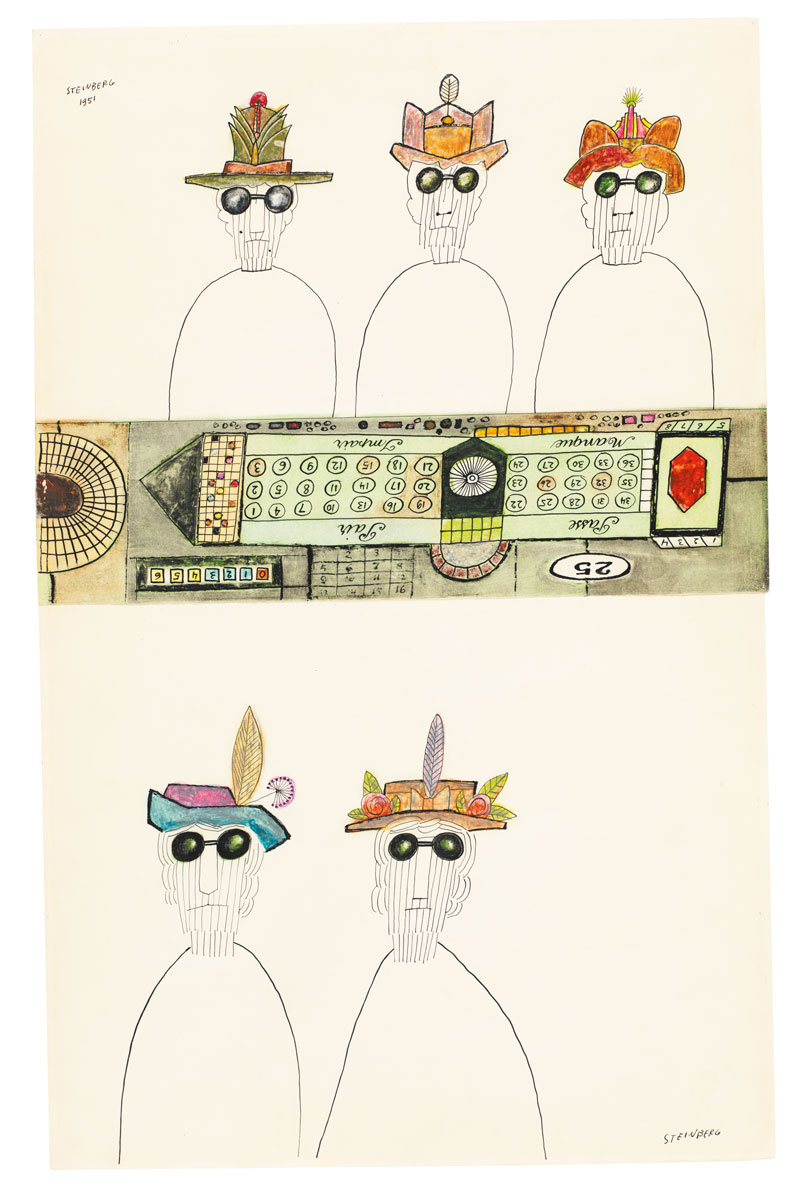
By December, still in the US Naval Reserve, fears being called up to serve in the Korean War.
1951
February, ST and Hedda leave for an extended trip to Europe. In late March, they are in Palermo and travel in southern Italy. Over the next three months, they travel extensively elsewhere in Italy and also frequent casinos in Monte Carlo and San Remo, among other places. By late June, ST is in Nice visiting his parents.
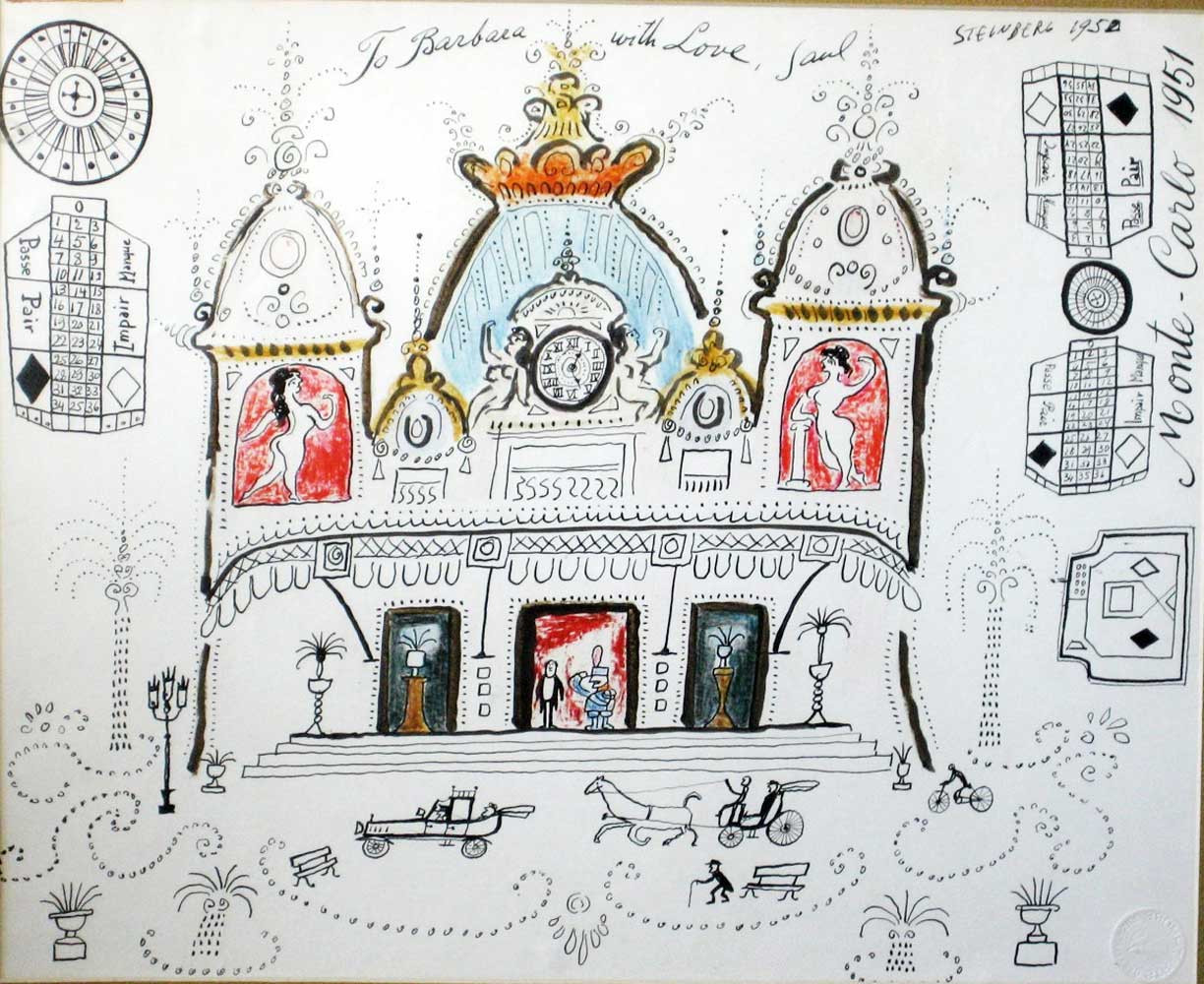
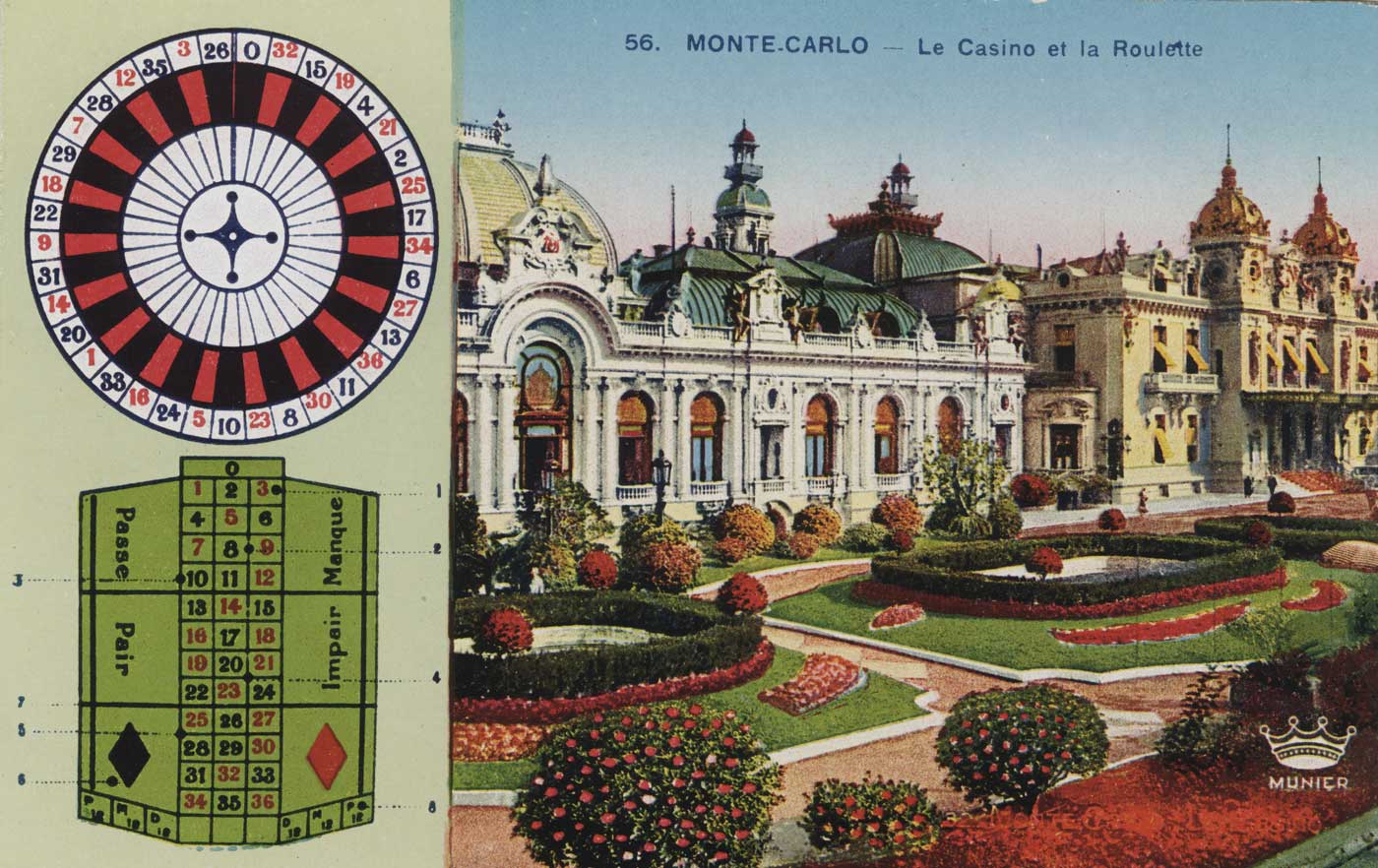
Date of one of his most oft-reproduced drawings on Italian subjects, the famous 19th-century Galleria Vittorio Emanuele II in Milan.
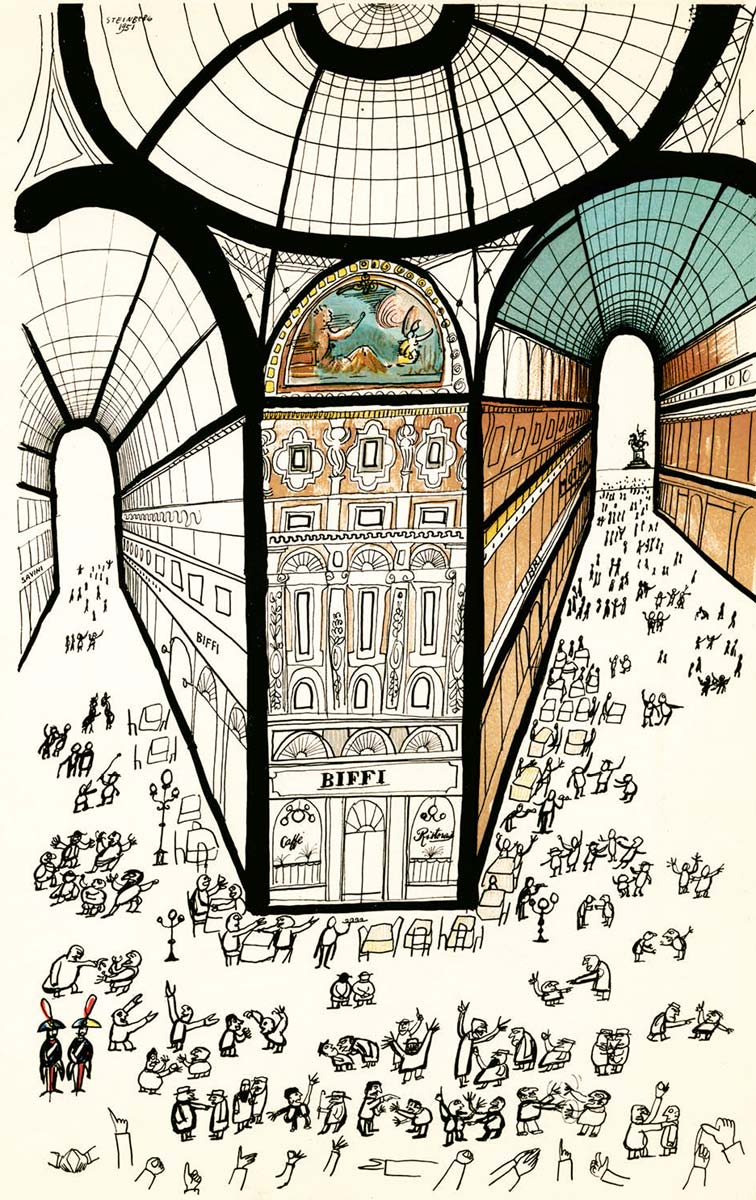

April-May, solo exhibition at the Galleria L’Obelisco, Rome.
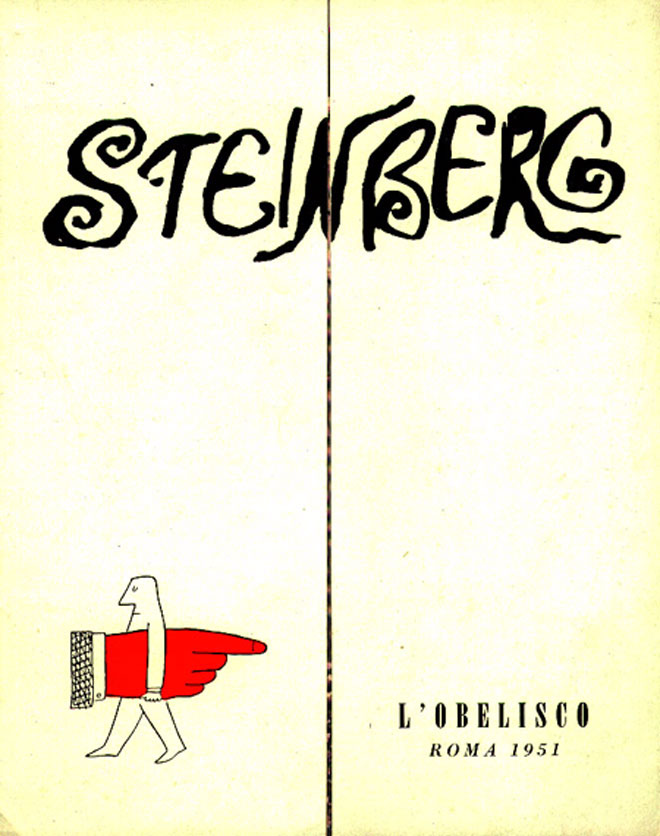
July, travels in England, Scotland, and Ireland; late August, returns to New York.
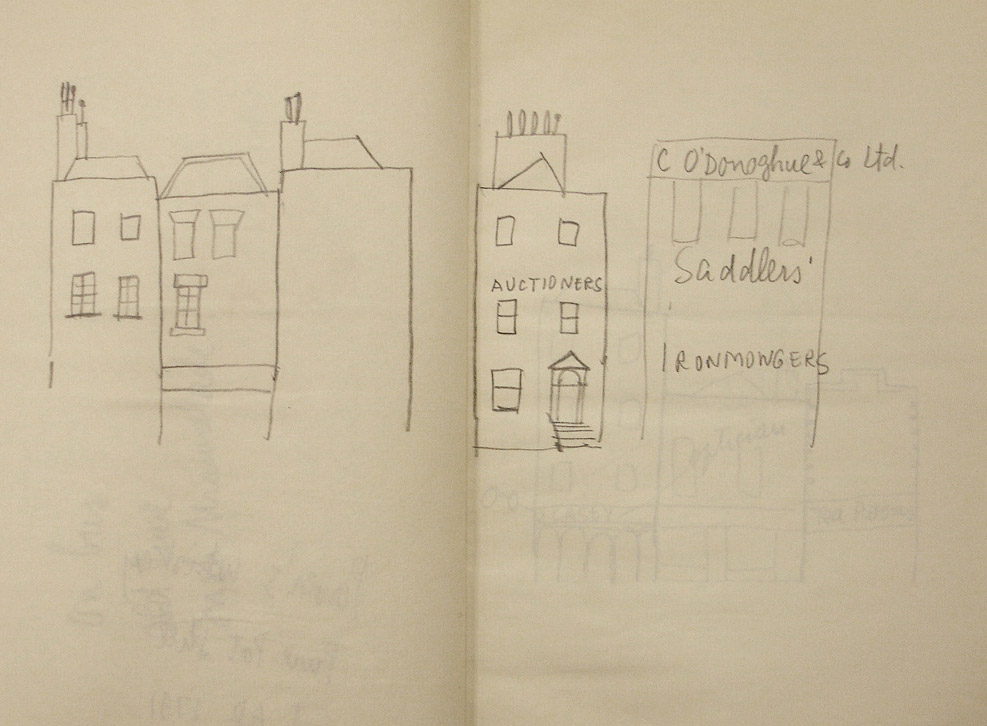
October 3, in Washington, DC, still trying to avoid call-up for the Korean War: “I fear—they want me back in uniform. But I’m putting up a fight.”
November-December, Peter Watson, founder of the Institute of Contemporary Arts, London, discusses the possibility of an ST exhibition with Roland Penrose and Herbert Read.
December 6, death of New Yorker editor Harold Ross. William Shawn succeeds him.
In Florida and the South doing general pictorial research for New Yorker drawings.
![Untitled [Florida Types], 1952. Ink and collage on paper, 30 x 24 in. The Art Institute of Chicago; Gift of The Saul Steinberg Foundation.](https://saulsteinbergfoundation.org/wp-content/uploads/2016/07/1951.-130.-SSF-1960-C-028-SM.-52.jpg)
1952
January 10, signs first contract with Hallmark for a series of annual Christmas and Valentine’s Day cards; is paid $10,000/year. Unlike the earlier Museum of Modern Art cards, Hallmark’s are in color.
Mid-January, in Palm Beach, Florida, for pictorial research for a LIFE magazine article on Palm Beach.

Late January, ST and Hedda move into two floors of a brownstone owned by Frederick Stafford (formerly Stern), Hedda’s first husband, at 179 East 71st. ST rents space above as a studio. Stafford eventually transfers title of the building to Hedda, who receives rental income from two other apartments for the rest of her life.
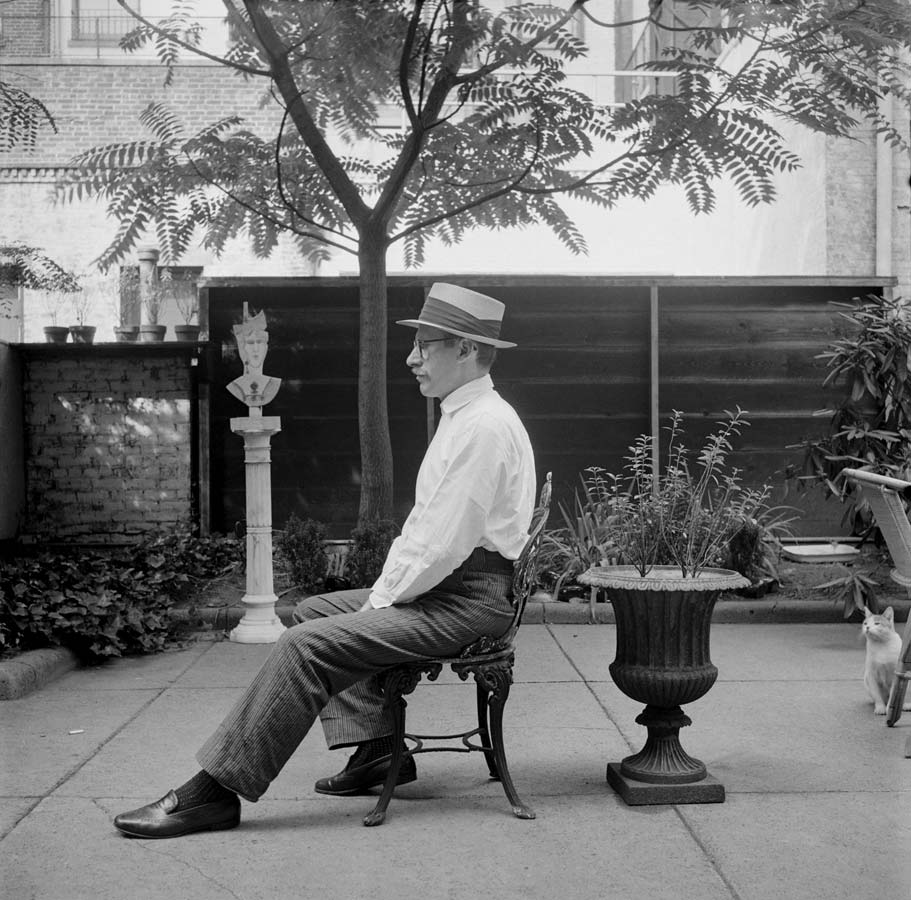
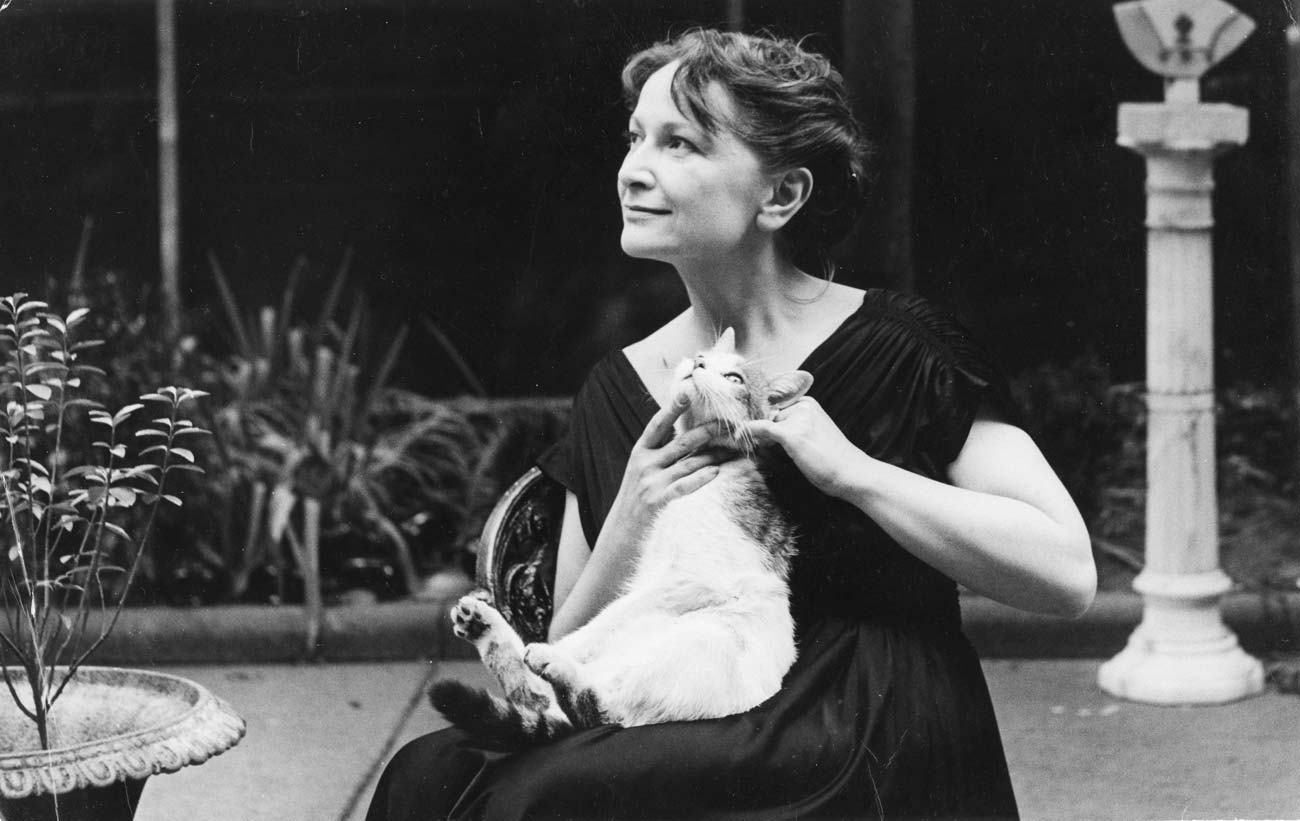
January-February, solo exhibition at the Betty Parsons Gallery and Sidney Janis Gallery, New York; the first of the joint exhibitions the two galleries will mount (through 1976). The Metropolitan Museum of Art pre-purchases the 11-part drawing Parade from the Parsons segment of the show.
The Parsons-Janis show initiates a four-and-a-half-year series of exhibitions in the US, South America, and Europe that will give ST wide national and international exposure. For a detailed chronology and list, click here.
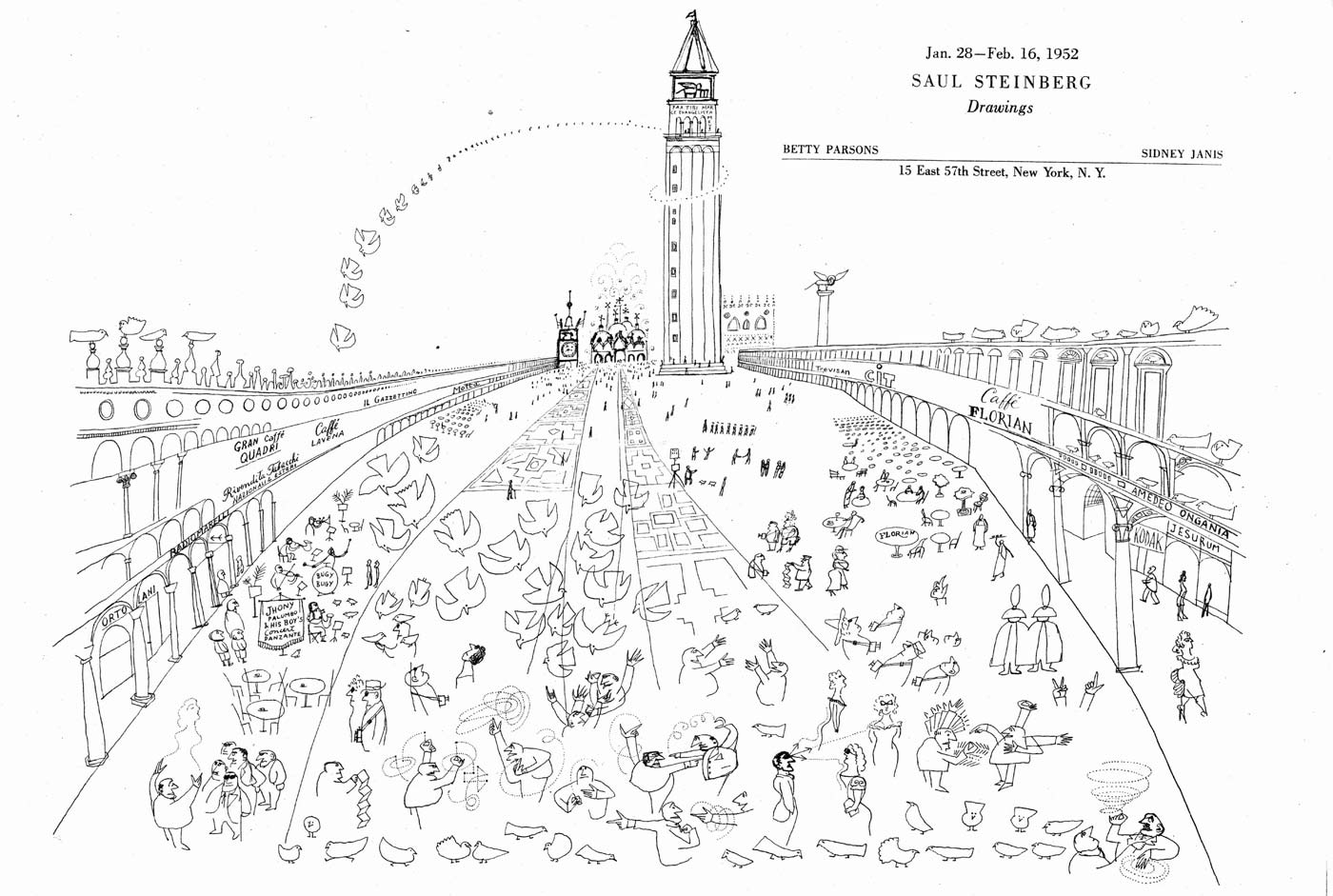
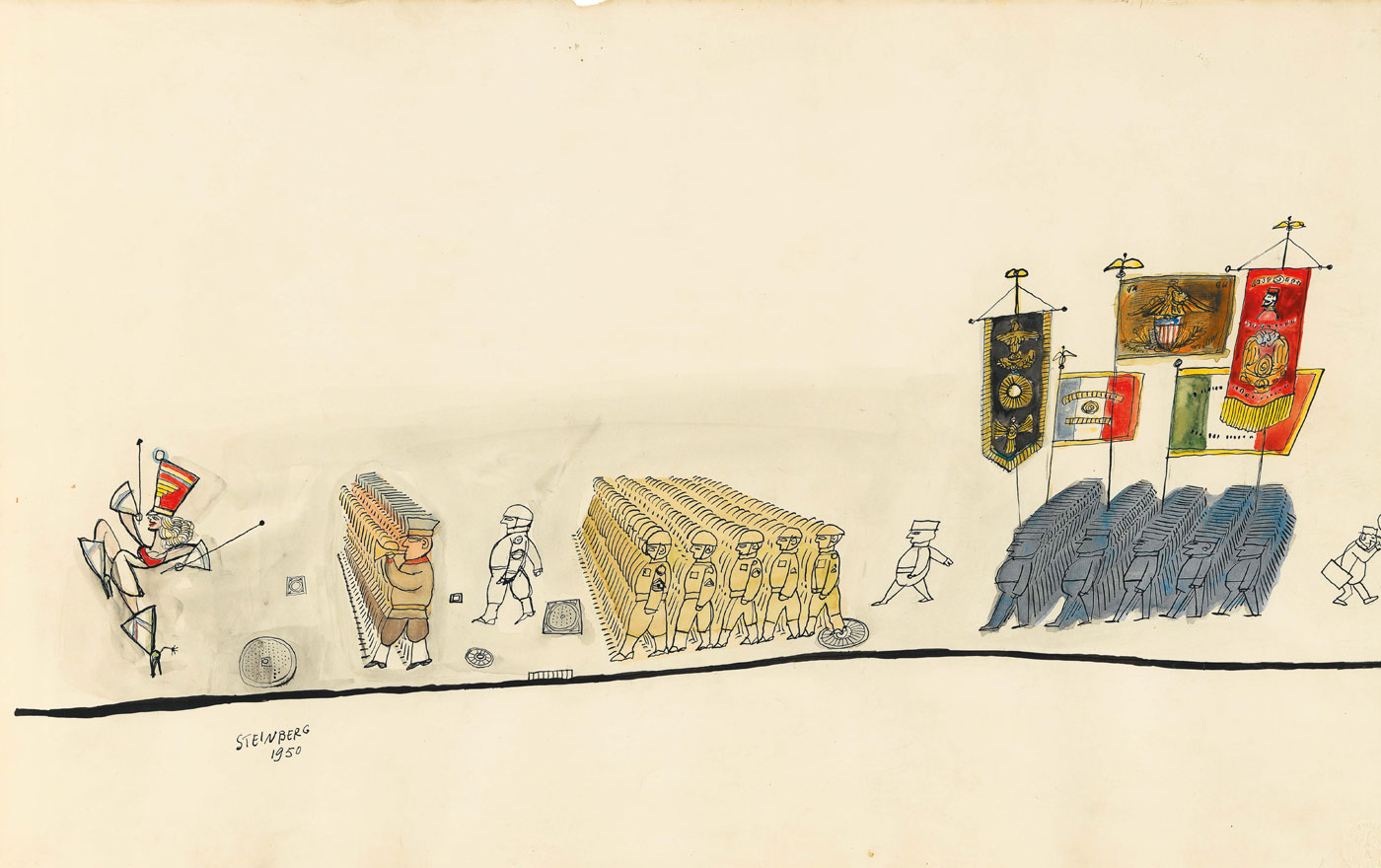


March, ST and Sterne have simultaneous solo exhibitions at Gump’s Gallery, San Francisco.
Late April, sails to London for the May 1 opening of his show at the Institute of Contemporary Arts. On the occasion of the exhibition, the BBC produces a film, “Coast to Coast,” with the camera moving across and closing in on a series of ST drawings, accompanied by American jazz, marching, and Western/cowboy music.
Travels by train through England sketching Victorian structures, railway stations, and pavilions.
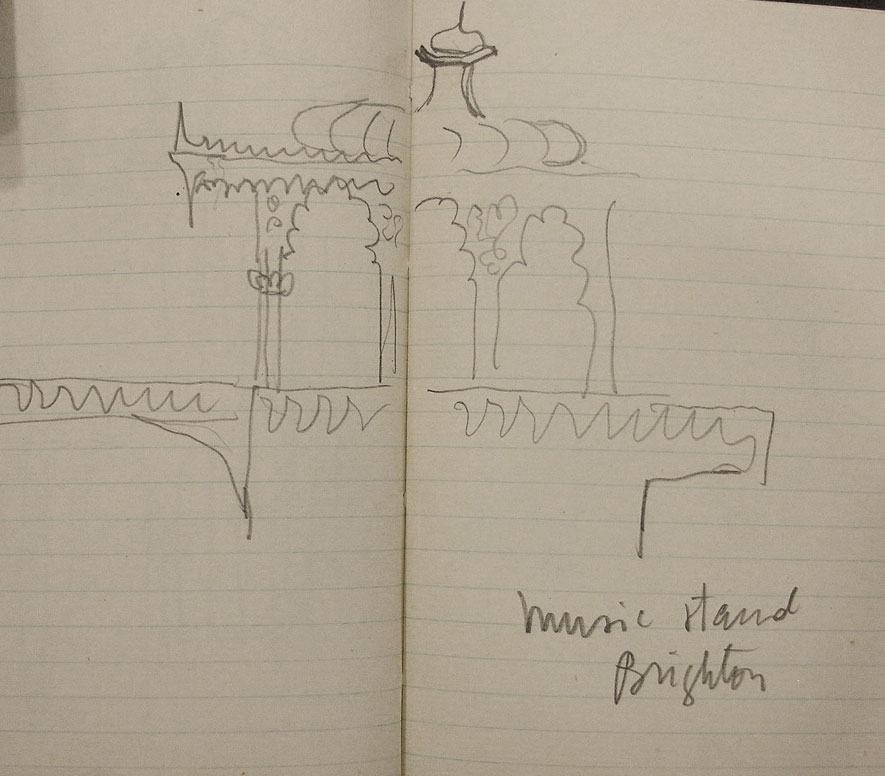
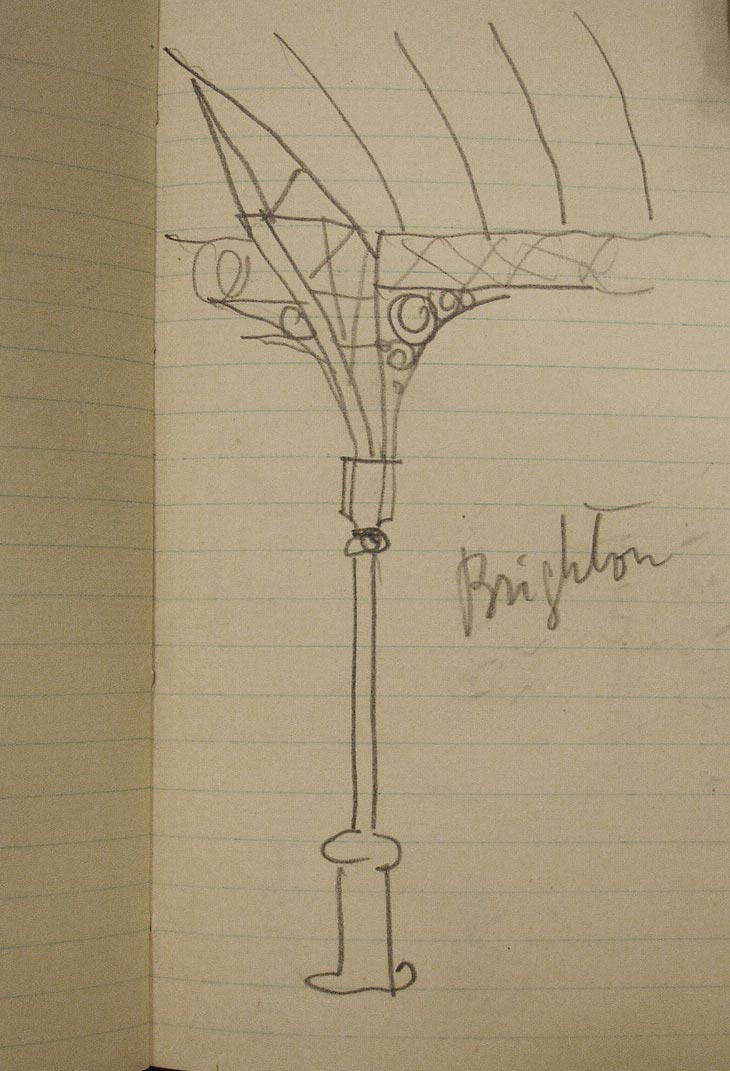
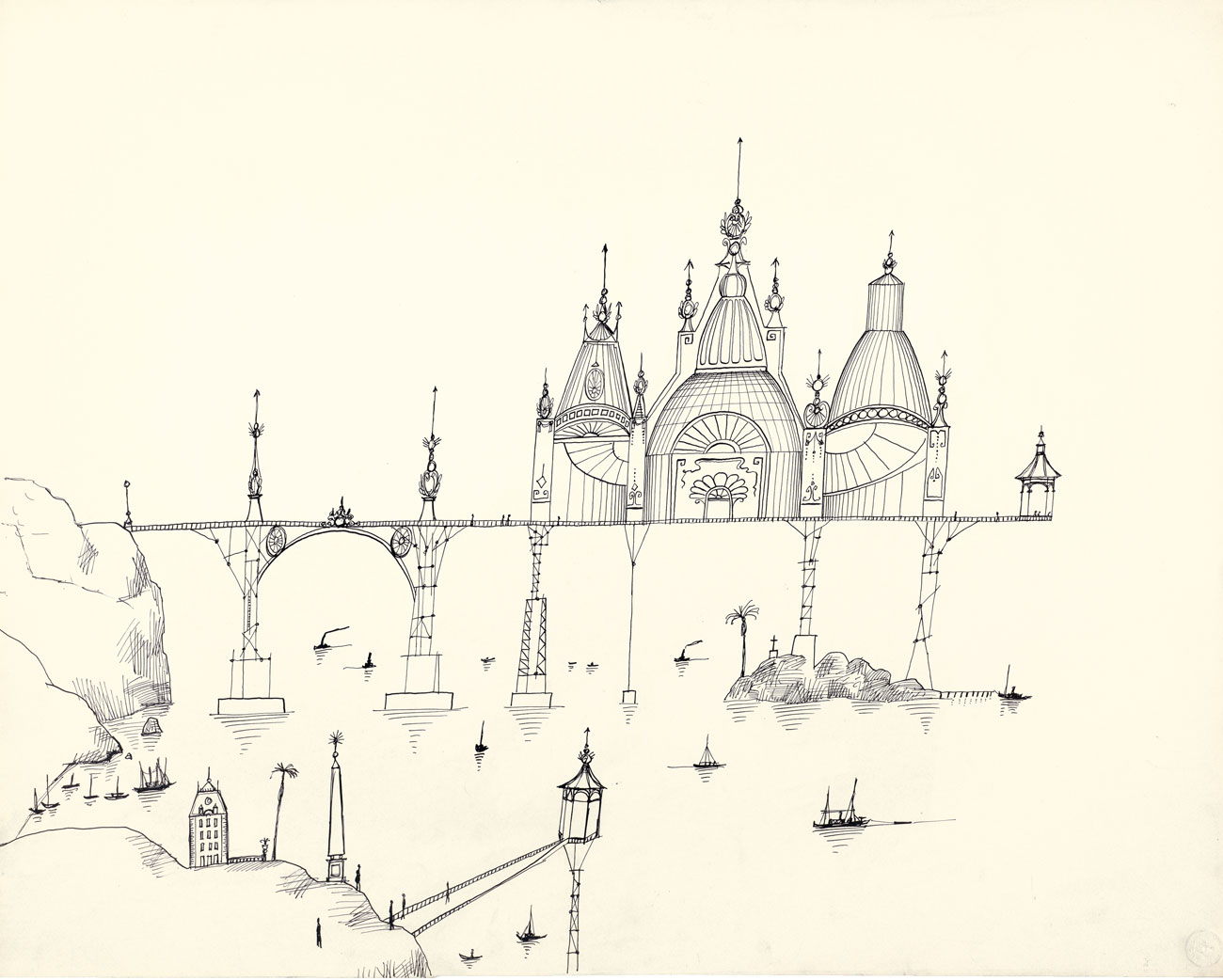
By May 3 is in Paris, then on to Nice for six-day stay, a brief trip to Rome, then back to Paris by the middle of the month. Returns to London on May 20; sets sail for New York on the 28th.
July, goes to Chicago to cover the Democratic and Republican presidential conventions for The New Yorker. Produces no drawings of the conventions, but fills a sketchbook with verbal and pictorial notations about Chicago domestic and commercial architecture.
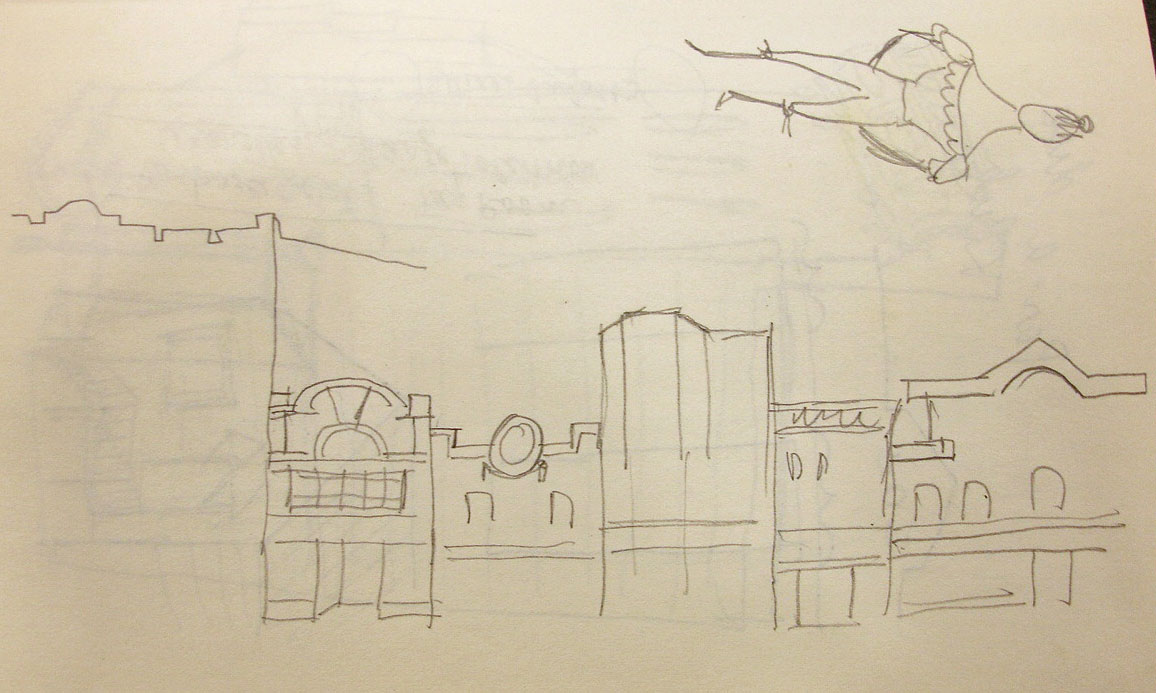

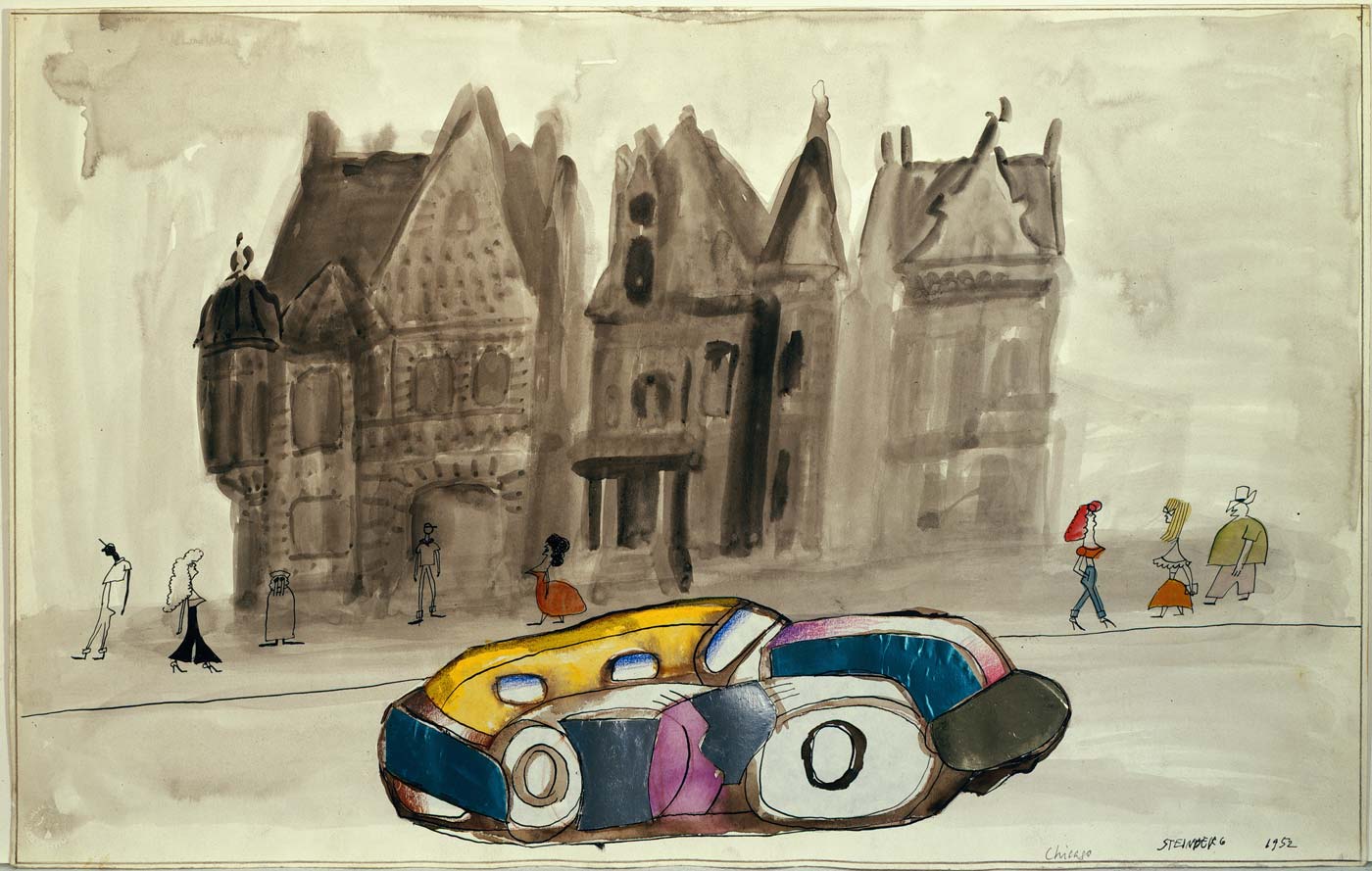
September 9, flies to Rio with Hedda; they spend time there and in Buenos Aires before going to São Paulo for the opening of their respective exhibitions at the Museu de Arte on September 18. They visit with museum director Pietro Maria Bardi and his wife, architect Lina Bo Bardi, whom ST had known in Milan.
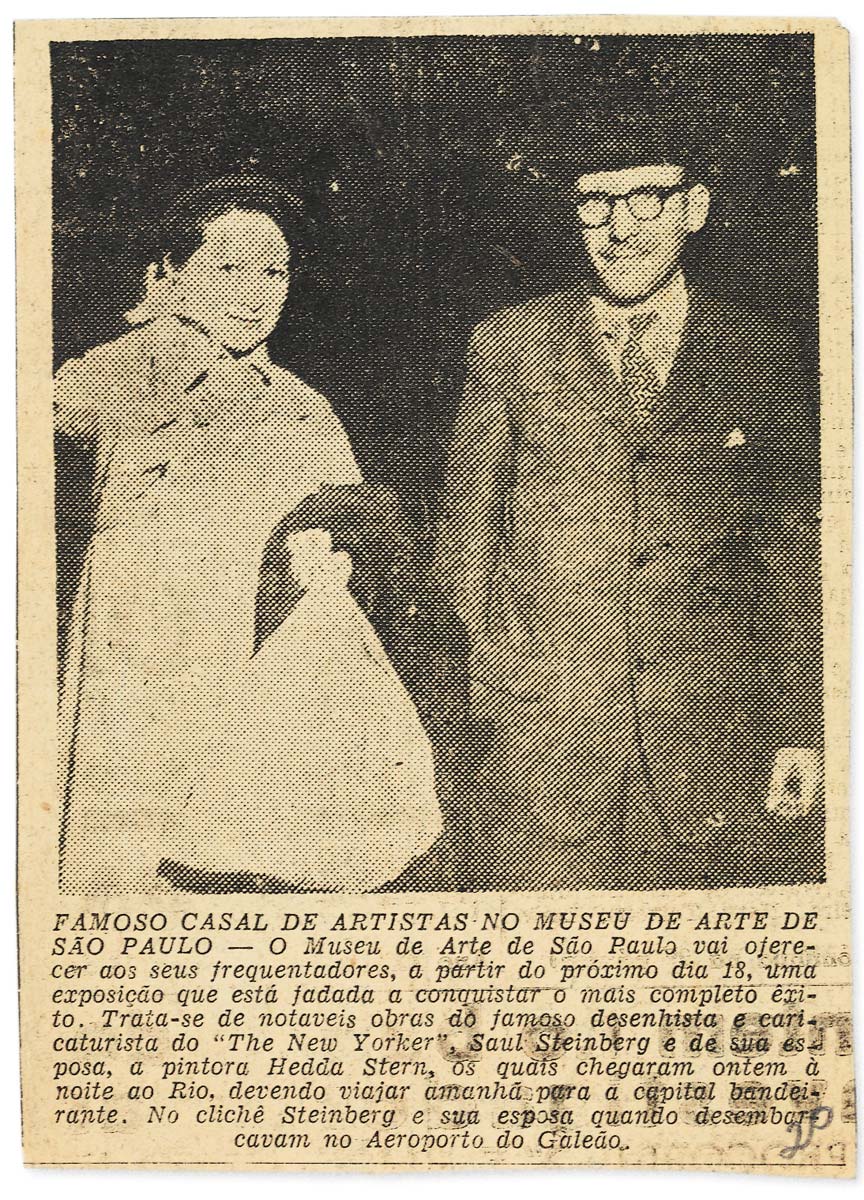
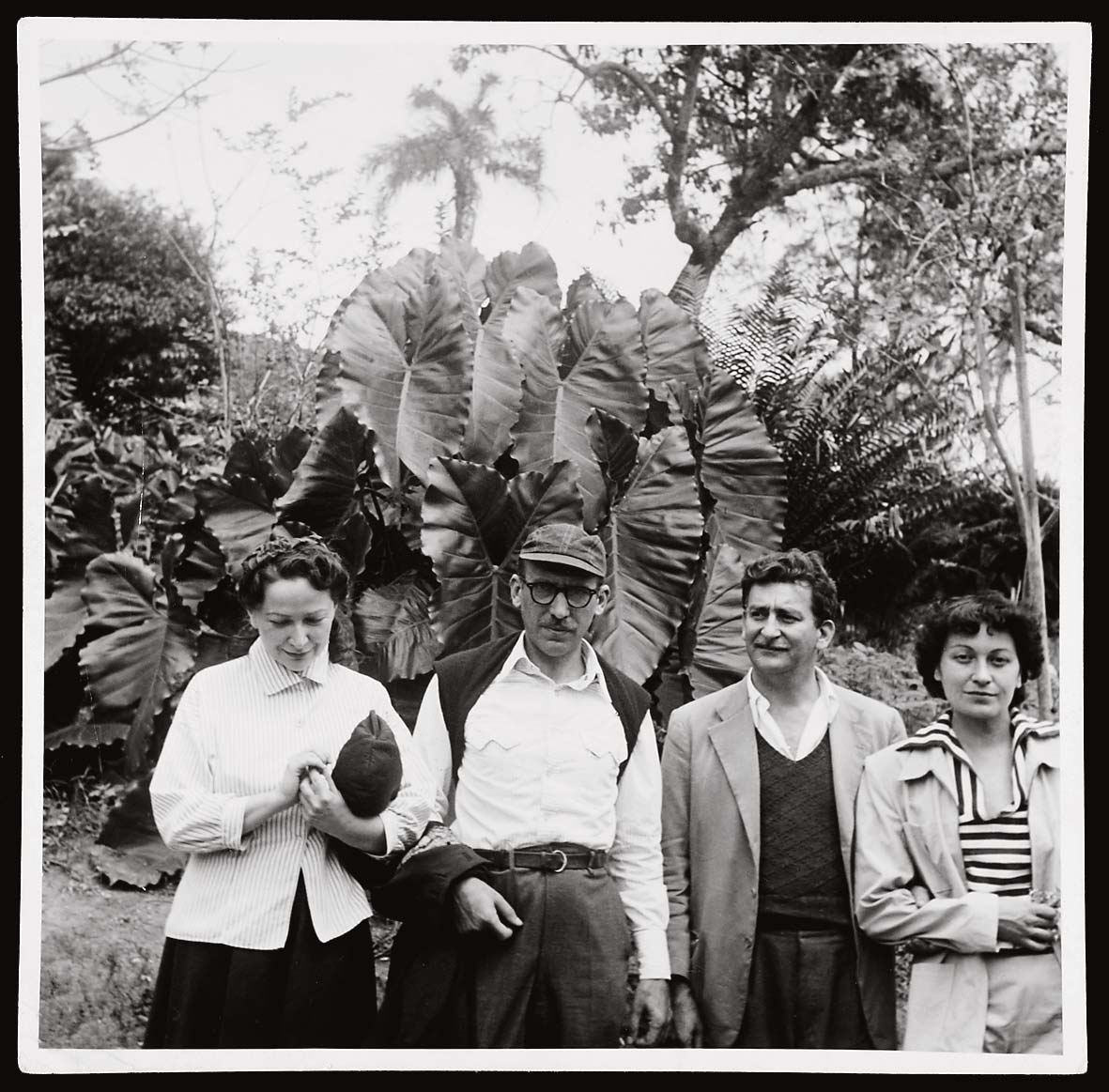
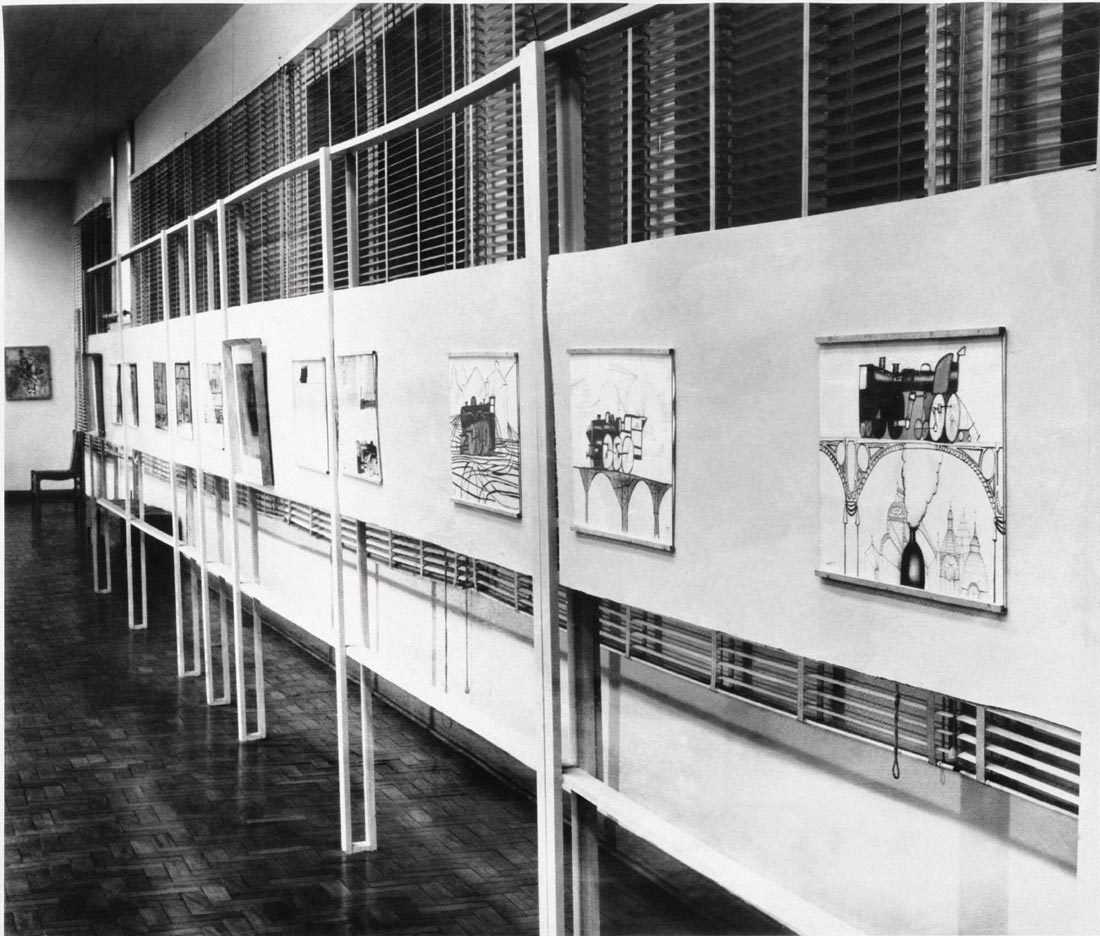
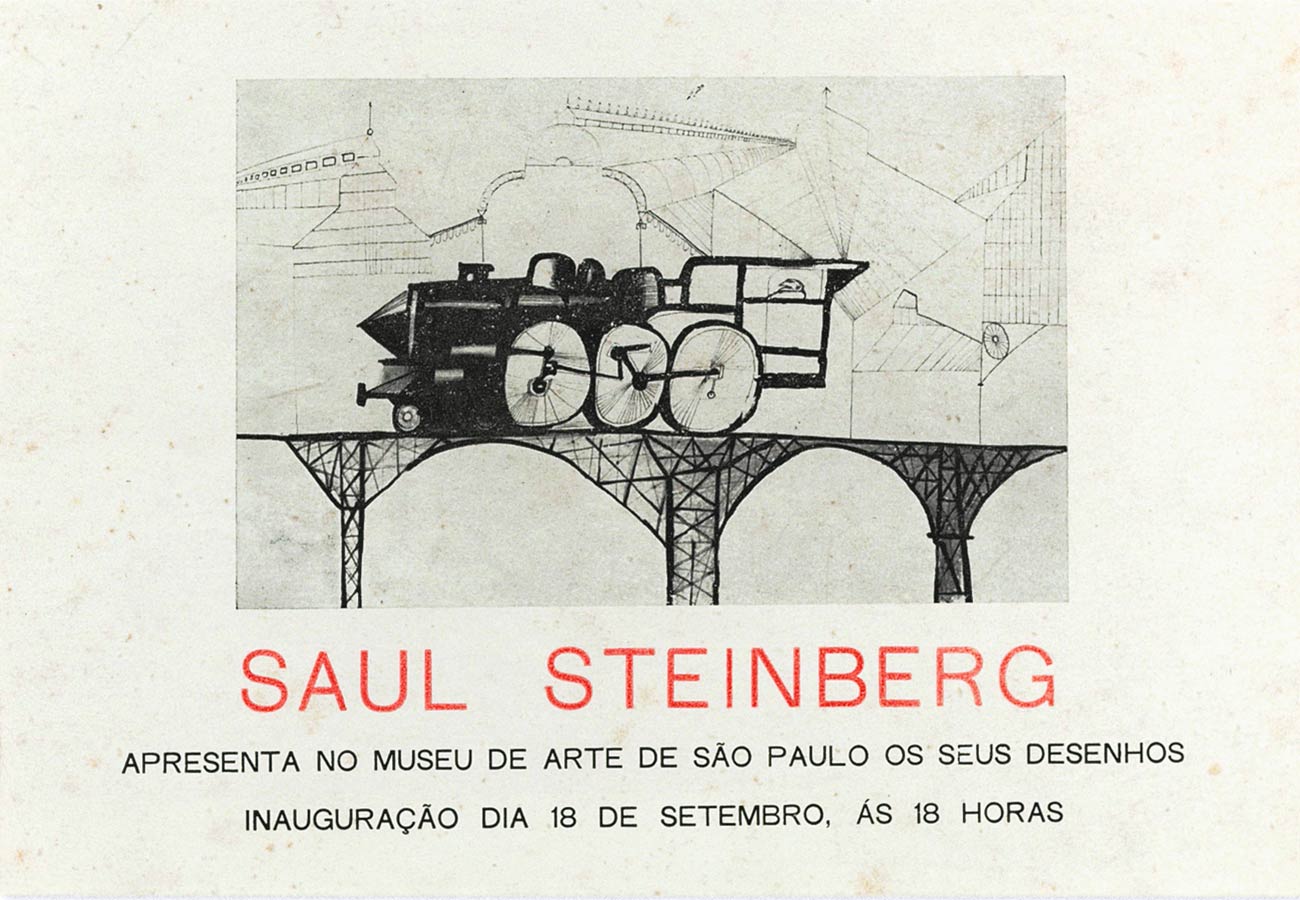
After three weeks in São Paulo as well as Rio and Buenos Aires, Hedda returns to New York. ST journeys in Brazil, visiting Recife, Belém, and Manaus, among other places. October 21, returns to New York.
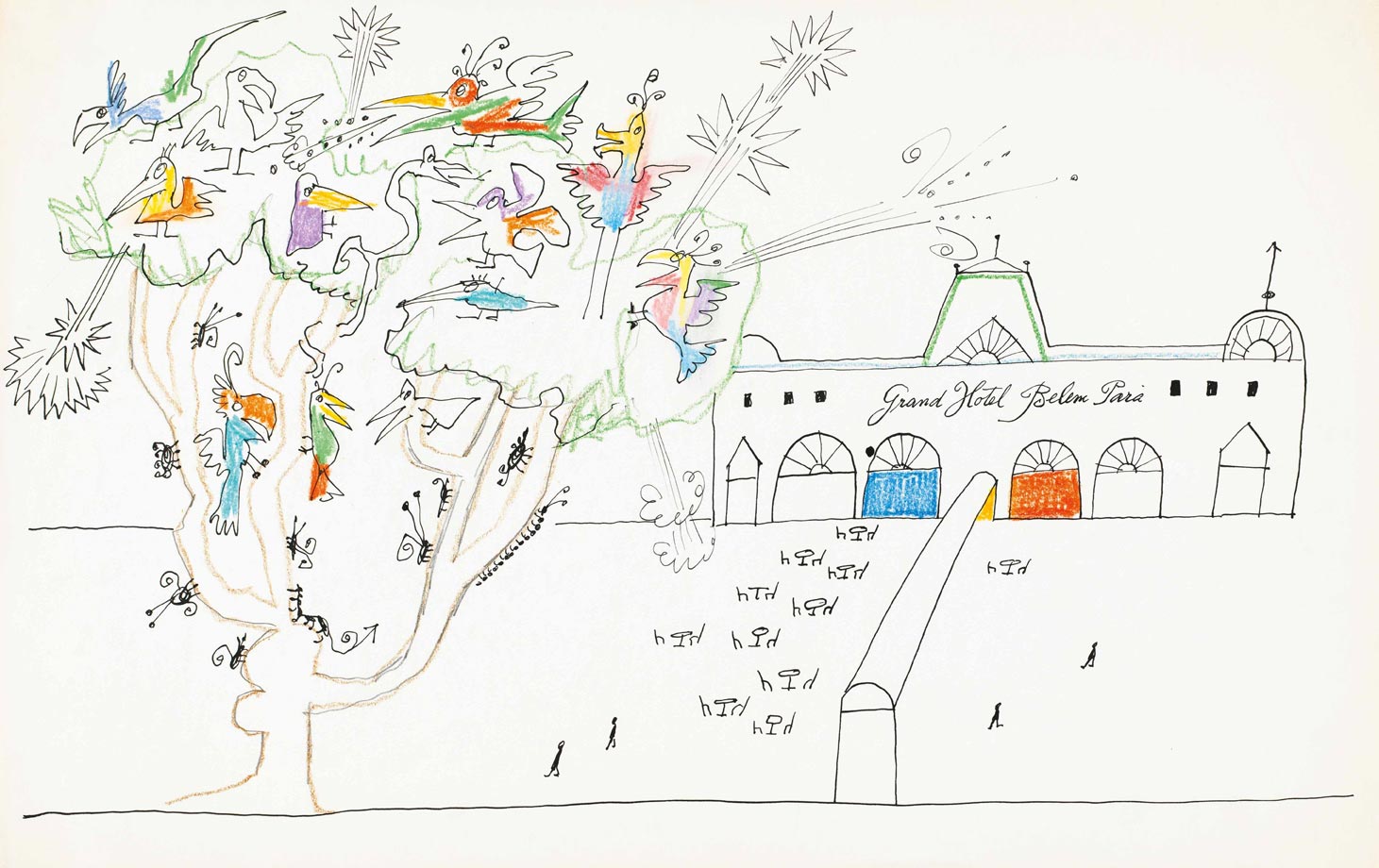
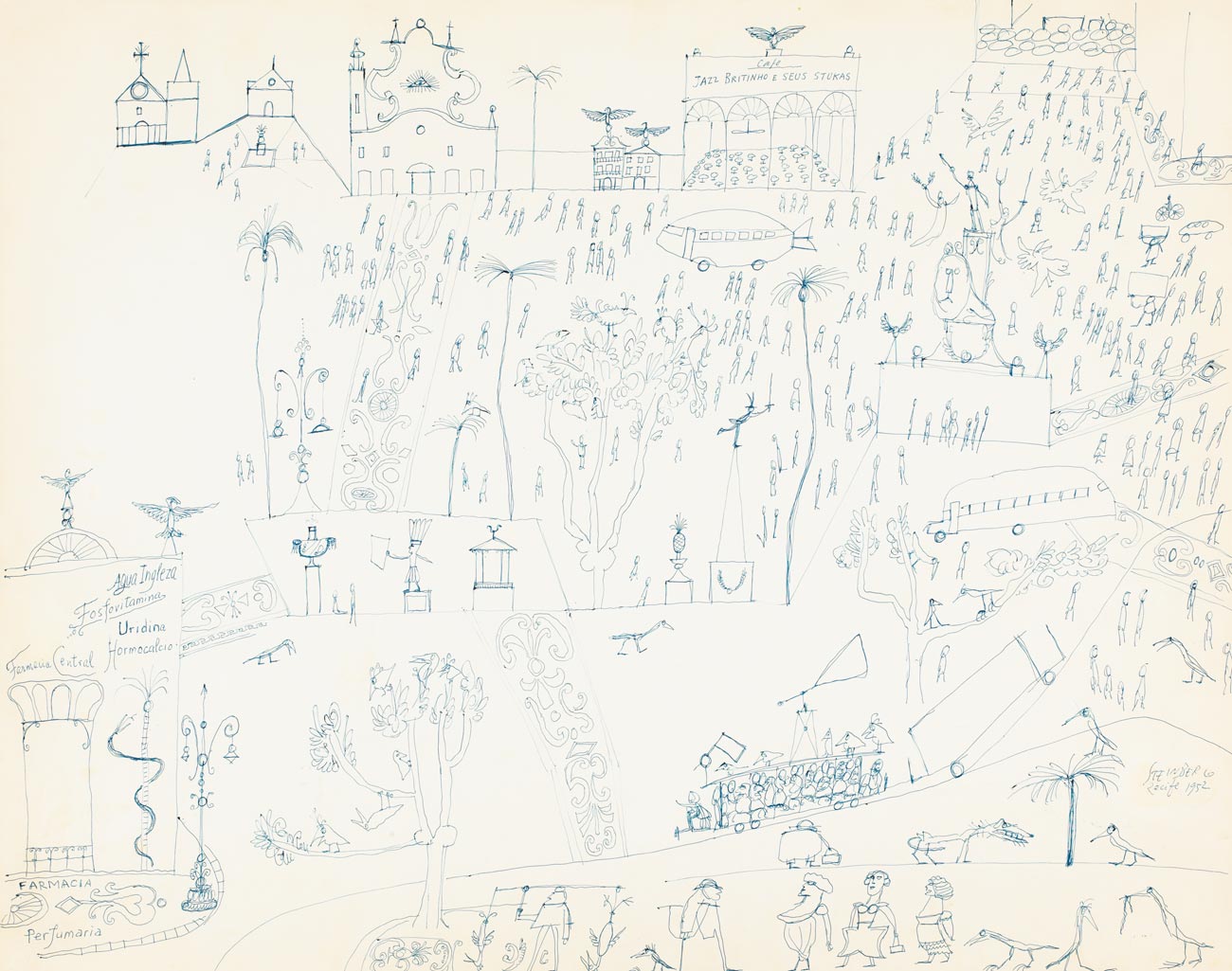
1953
January, trip to the southern US; January 27, returns to New York from Charleston, South Carolina.
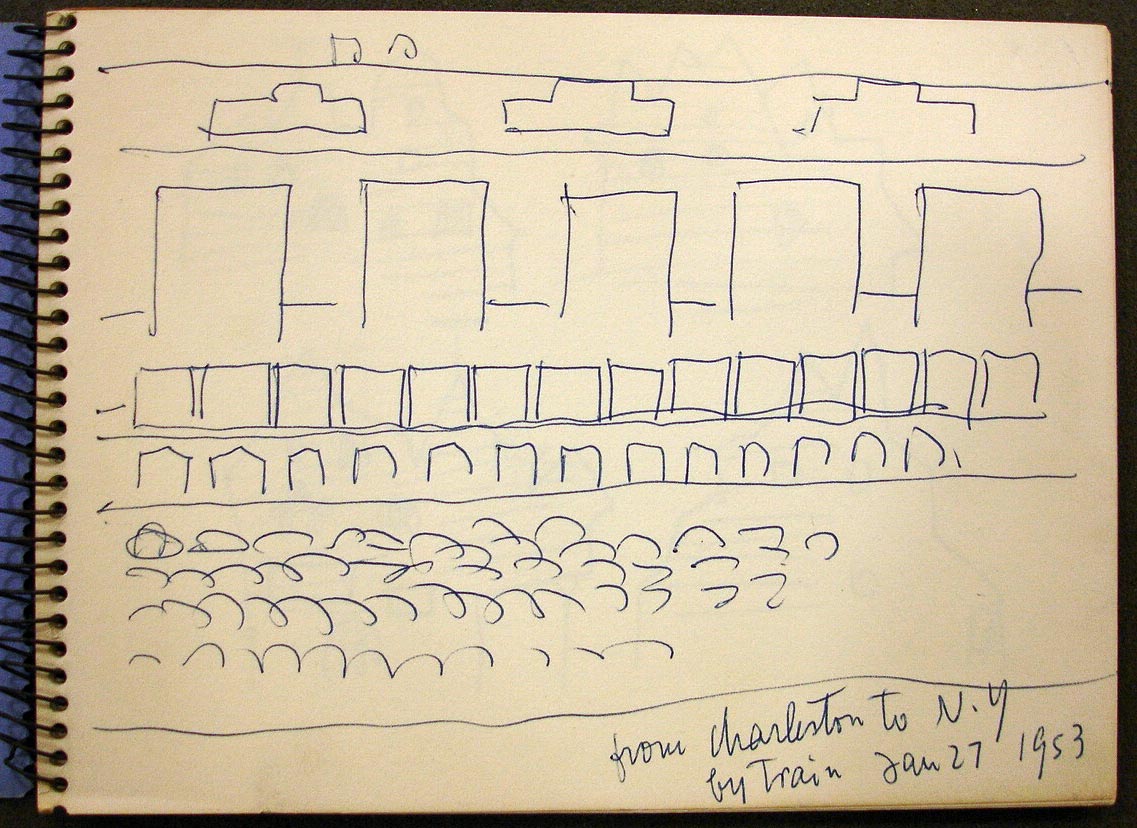
March 1, flies to Paris to work on his show at the Galerie Maeght, his first transatlantic flight. Goes first to Nice; by early April in Rome to meet with Hedda, who is preparing her show at the Galleria L’Obelisco; then back to Paris.
April 17, opening of his first exhibition at the Galerie Maeght, Paris; Maeght will continue to represent ST in France into the 1980s. The Maeght show, with substitutions for sold works, goes to the Stedelijk Museum, Amsterdam, later in the year and makes at least six stops in Germany and Switzerland in 1954-early 1955.
May, trips to Athens and Istanbul; early June, files to Rome and then Paris. June 14, flies back to New York.
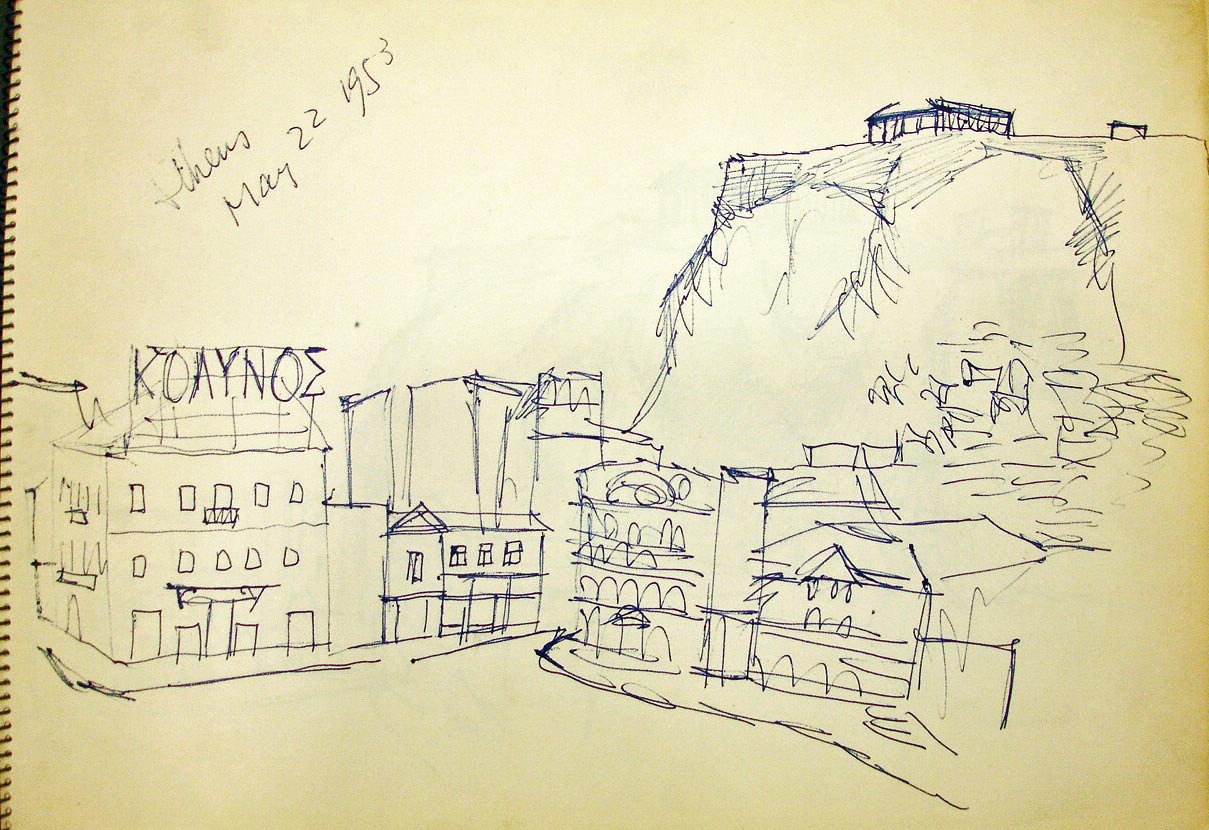
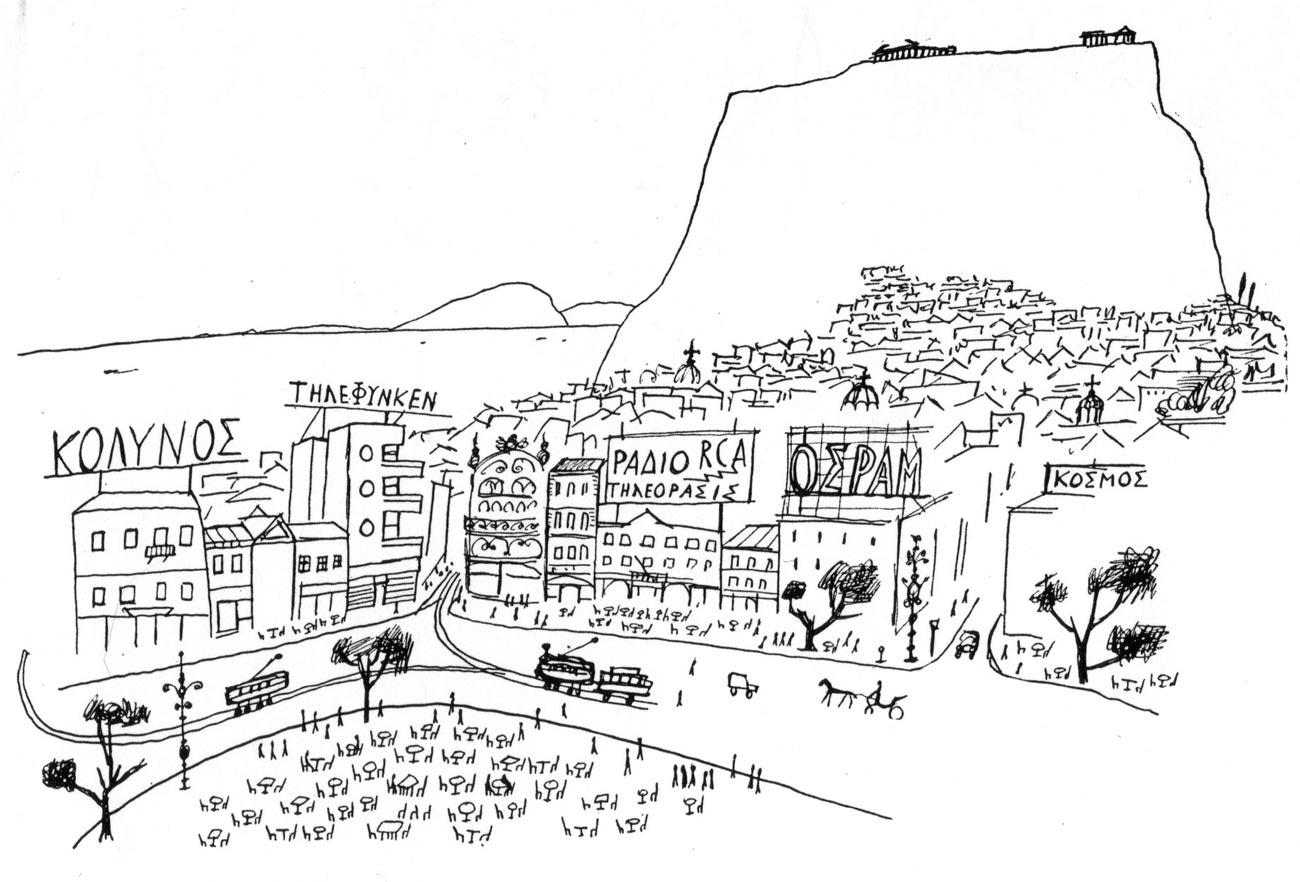
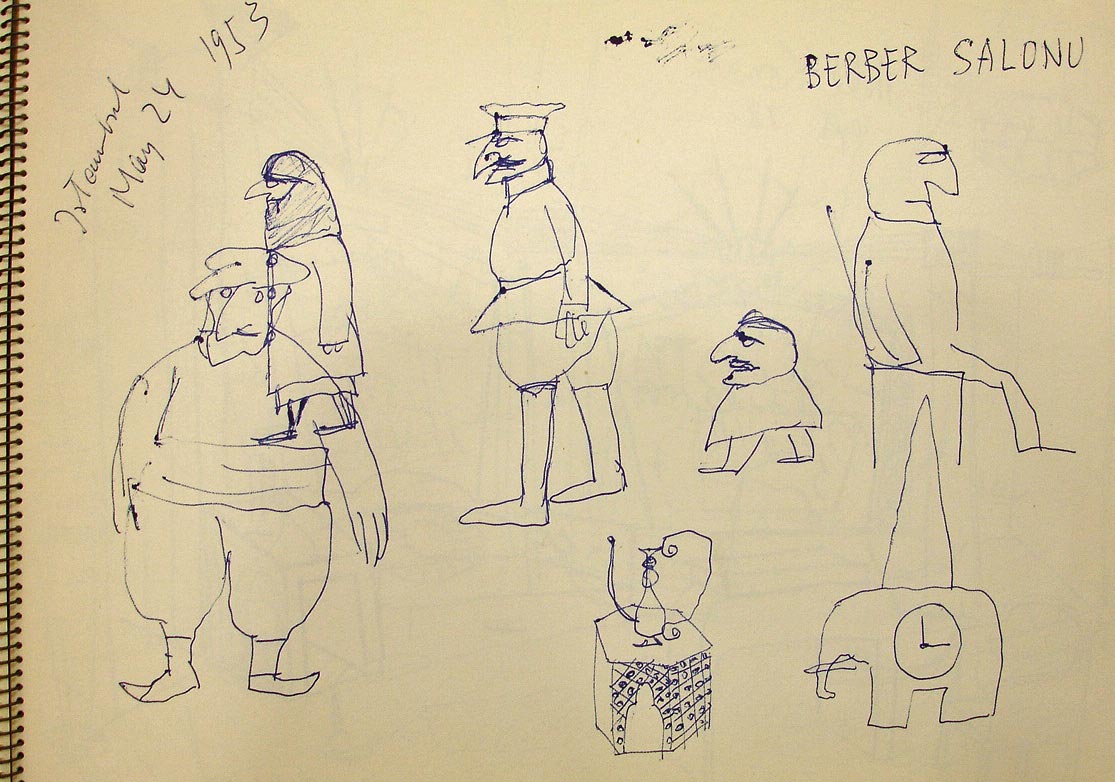
Provides drawings for a TV commercial for Jell-O Instant Pudding, commissioned by the Young & Rubicam advertising agency and directed by Gene Deitch.
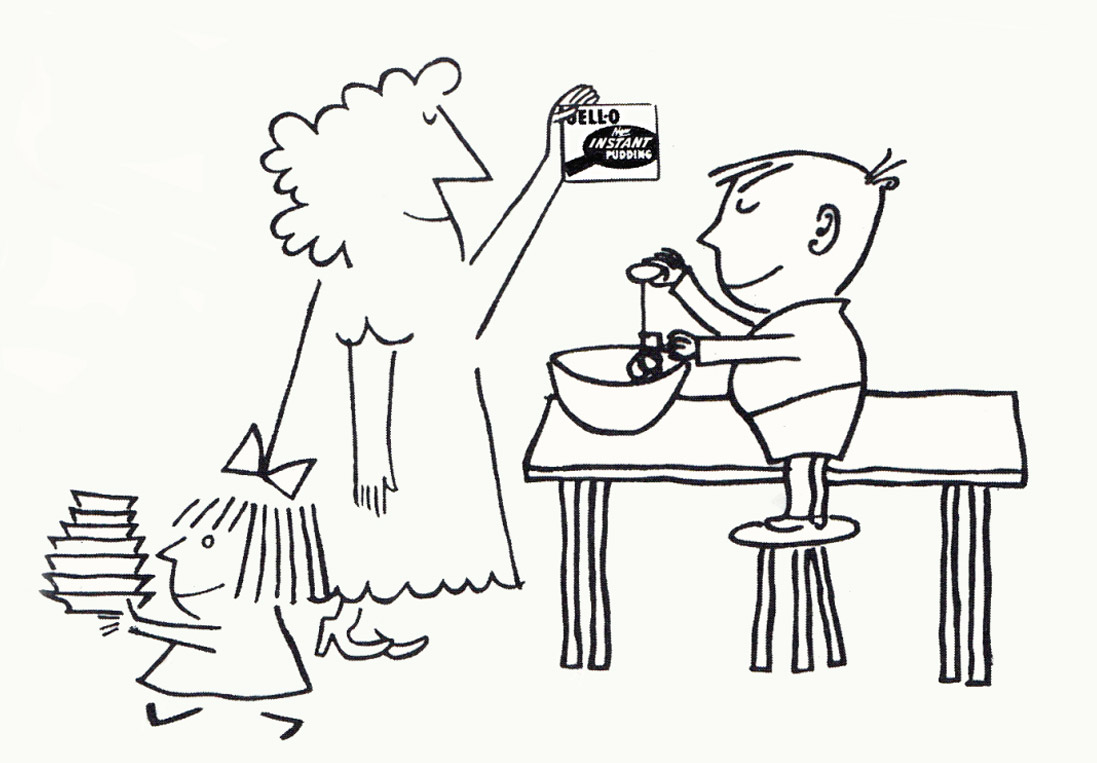
November 27, “Drawings by Steinberg” opens at the Virginia Museum of Fine Arts, Richmond. The show, with works from or similar to the 1952 Parsons-Janis exhibition, is then circulated to other museums in Virginia and, by the American Federation of Arts from July 1955 through May 1956, to nine venues throughout the US.
December 28, Aldo Buzzi arrives in New York for a three-month visit.
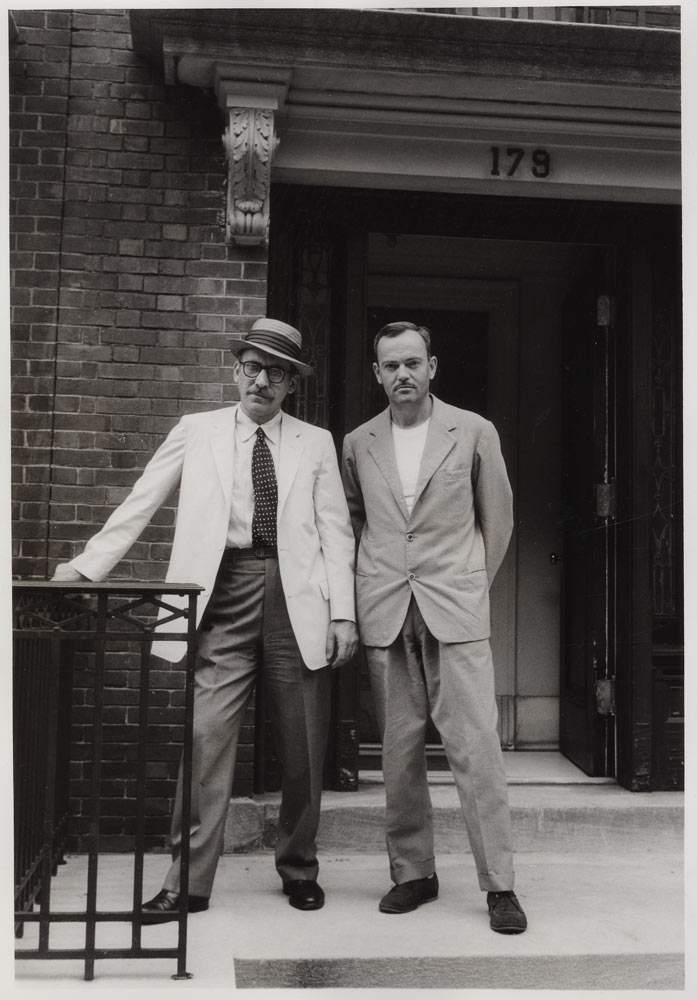
1954
February 8, ST and Buzzi begin a hectic two-week trip to the American South, stopping at 28 towns in Virginia and the Carolinas as well as the Civil War battlefield of Gettysburg. The sketches made on this and similar trips form the basis for finished drawings.
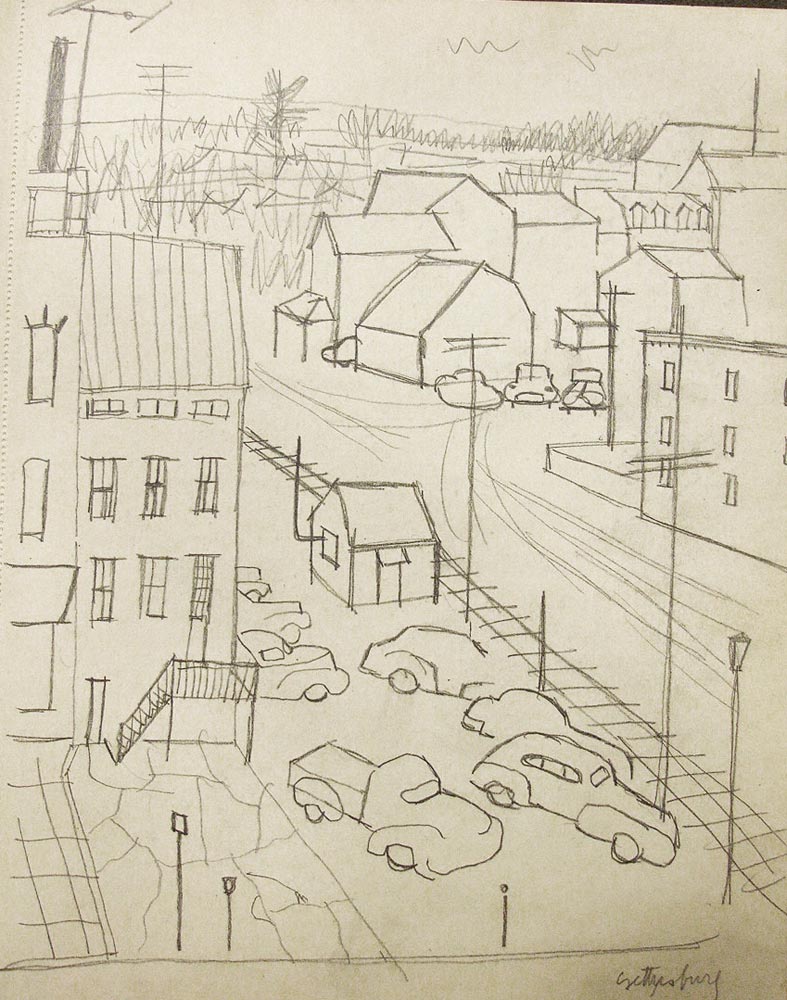
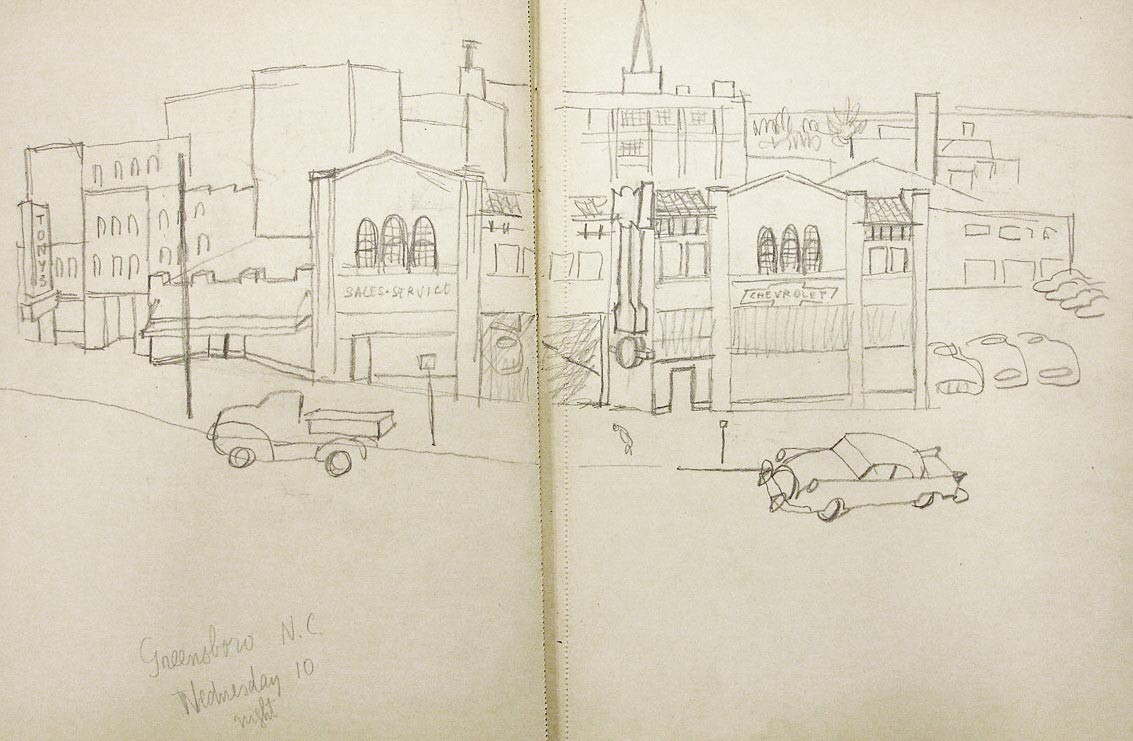
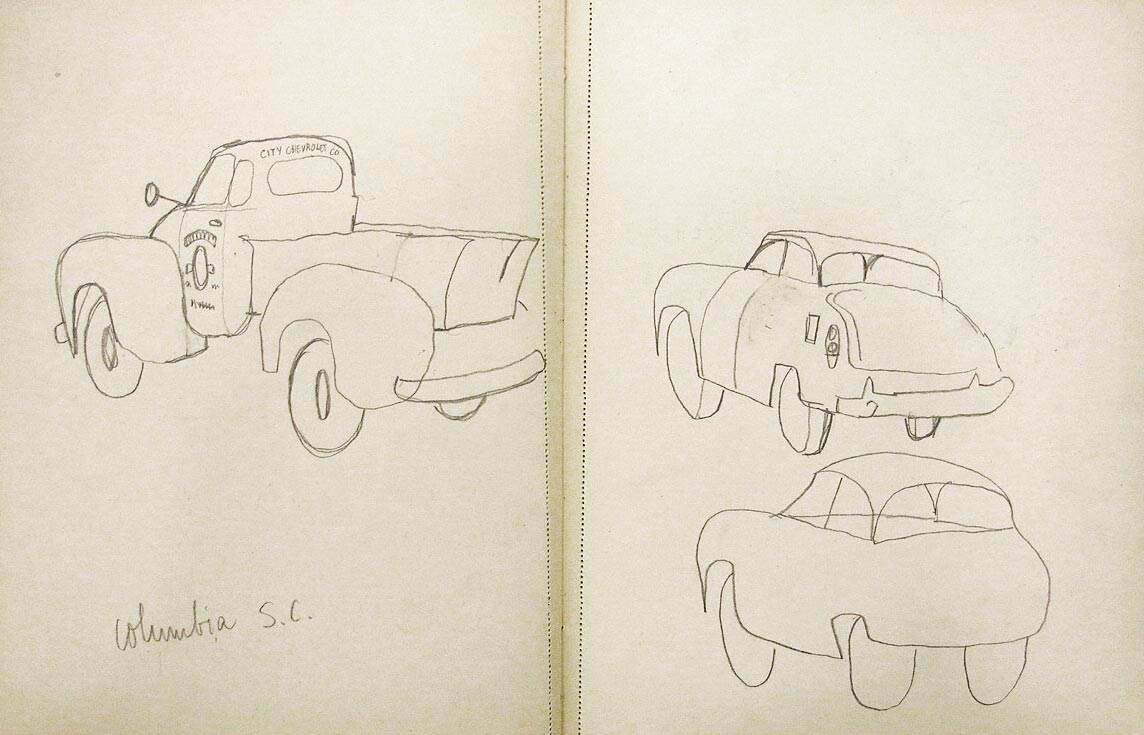

Buzzi will later publish his account of this trip as Piccolo diario americano (1974), with 15 drawings by ST.

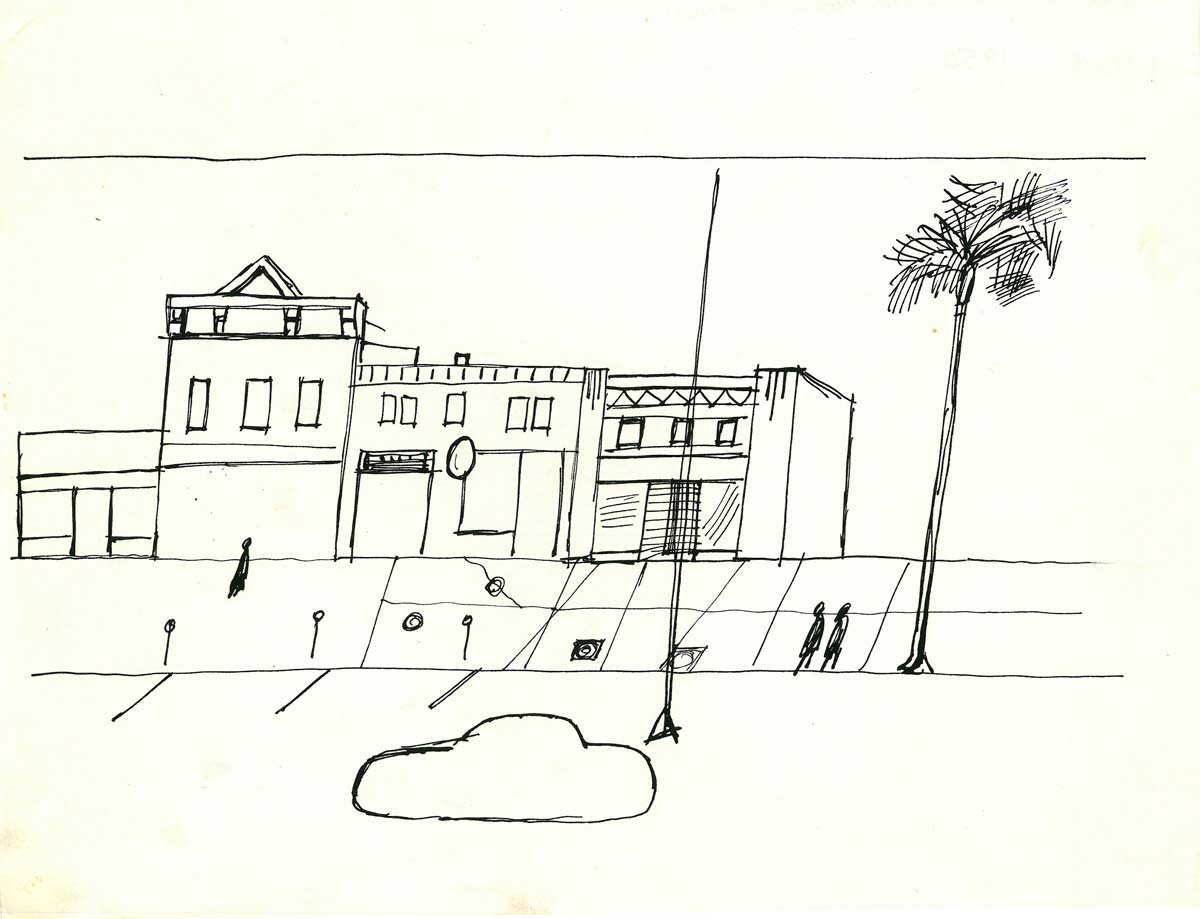
May 18, by train to Milwaukee to travel with the Milwaukee Braves baseball team on assignment for LIFE magazine. Stays in several Midwest cities and describes the assignment as “an excellent pretext for visiting unattractive parts of town.” The baseball drawings are published the following summer in a full-color feature in LIFE, “Steinberg at the Bat,” July 11, 1955. This is ST’s first exposure to baseball; he concludes that the game is “an allegorical play about America.”
July, stays with New York City Ballet choreographer Jerome Robbins in Stonington, Connecticut.
July 15, honorable discharge from the US Naval Reserve with the rank of lieutenant.
Invited by architect Ernesto Rogers of the firm BBPR to design the sgraffito murals for the “Children’s Labyrinth” at the 10th Triennial of Milan.
August, in Milan to oversee the production of his four drawings for the “Children’s Labyrinth”; using enlarged photographs of the drawings, a team of assistants incises the lines into the walls. ST adds a few new sections himself.
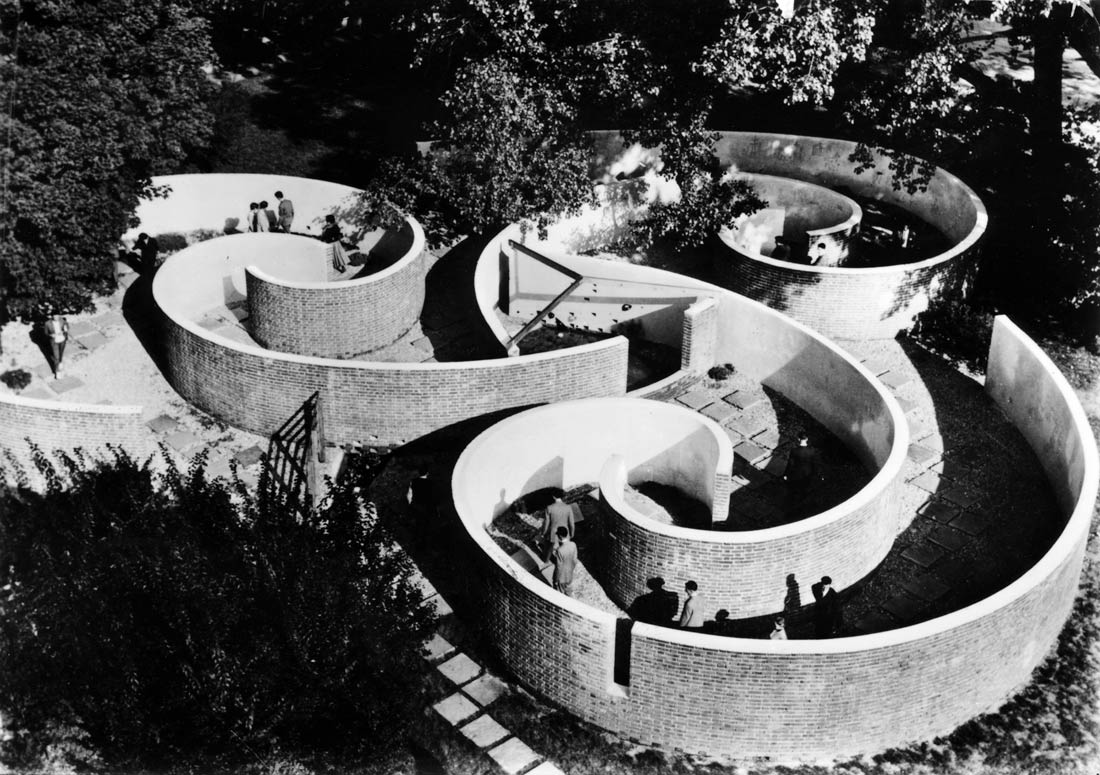
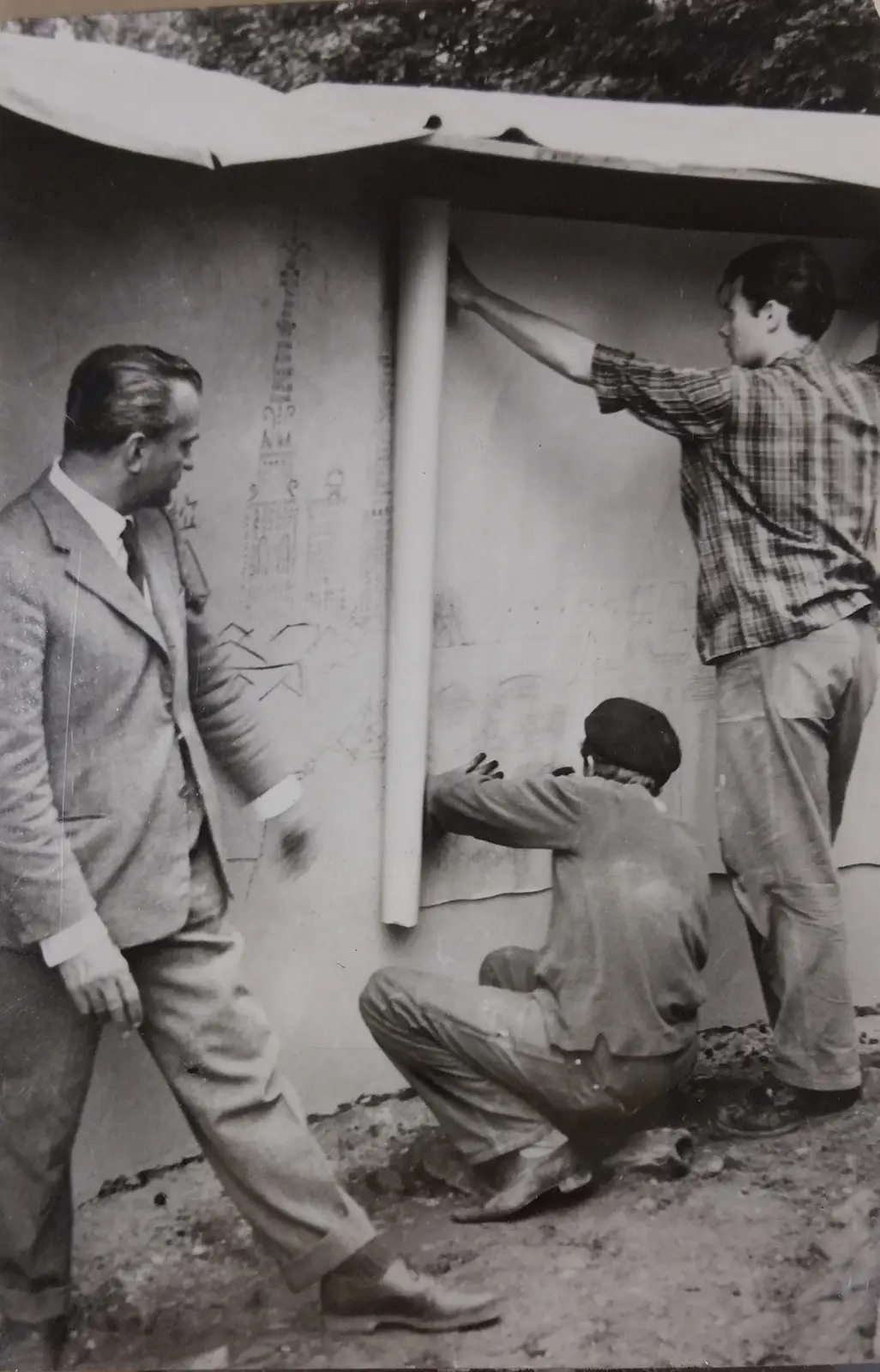
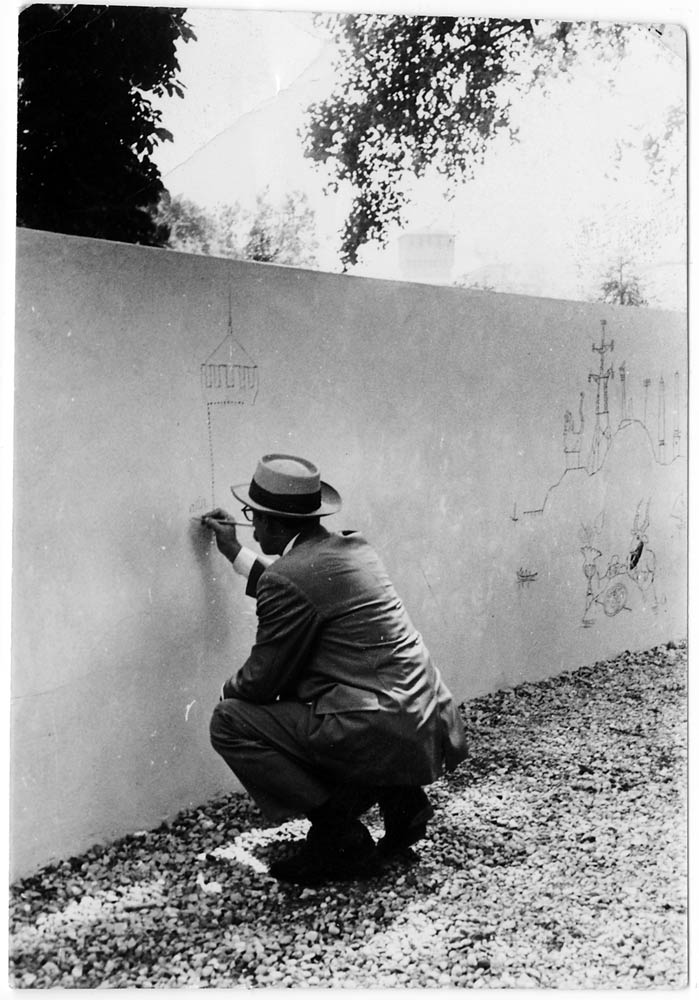
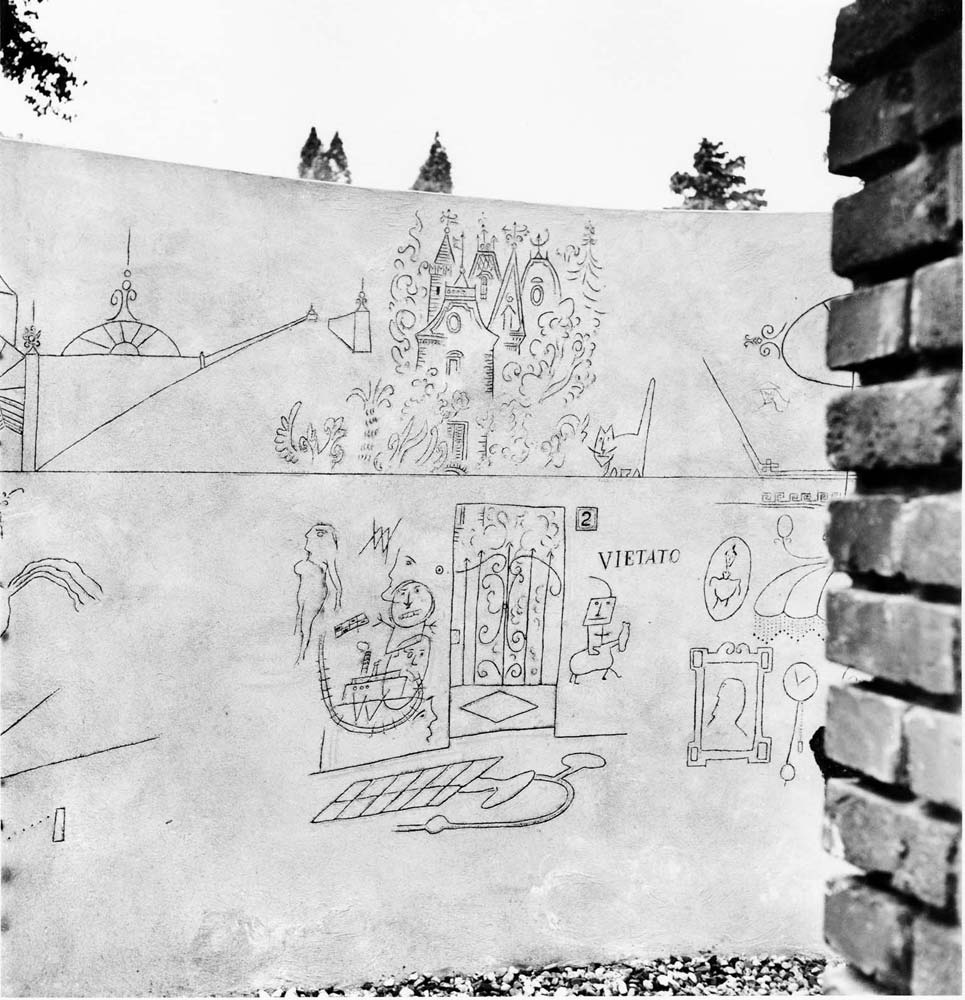
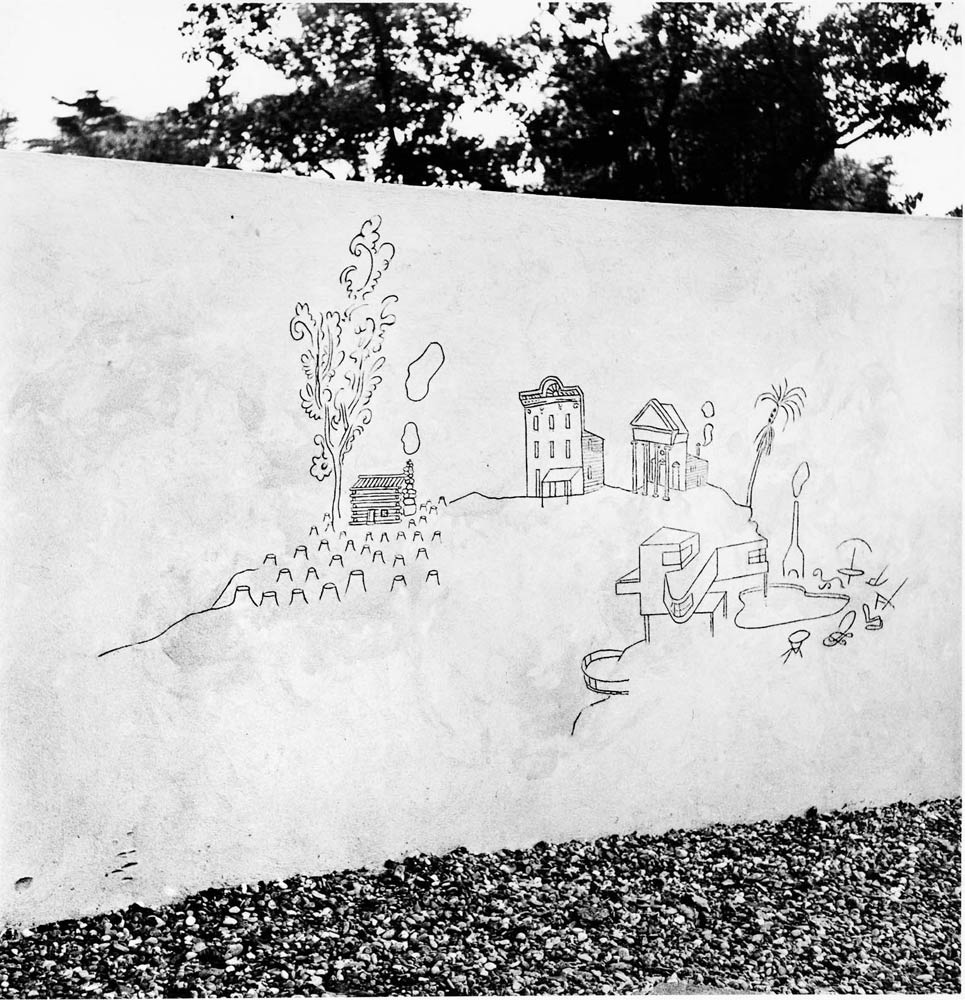
Director Alberto Lattuada enlists ST as an extra in a scene shot near the Galleria of Milan for his film Scuola elementare (Elementary School).
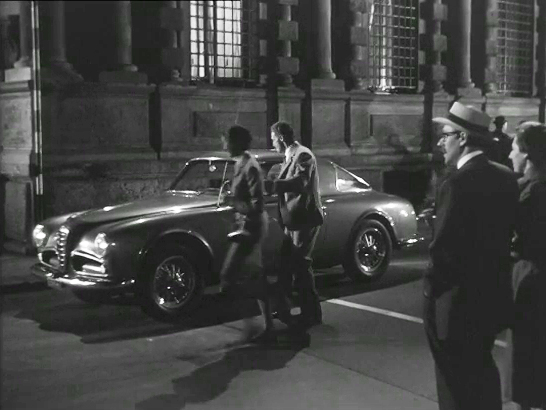
Goes to Nice and Paris, then spends about ten days in London. September 23, flies back to New York.
October, publication of The Passport, his third compilation of drawings. Also published this year, Steinberg’s Umgang mit Menschen, a German anthology of drawings from The Passport and his two earlier books.
Spends Christmas with Alexander Calder and his family in Roxbury, Connecticut. In a later drawing, recalls seeing Calder dancing with a Labrador.
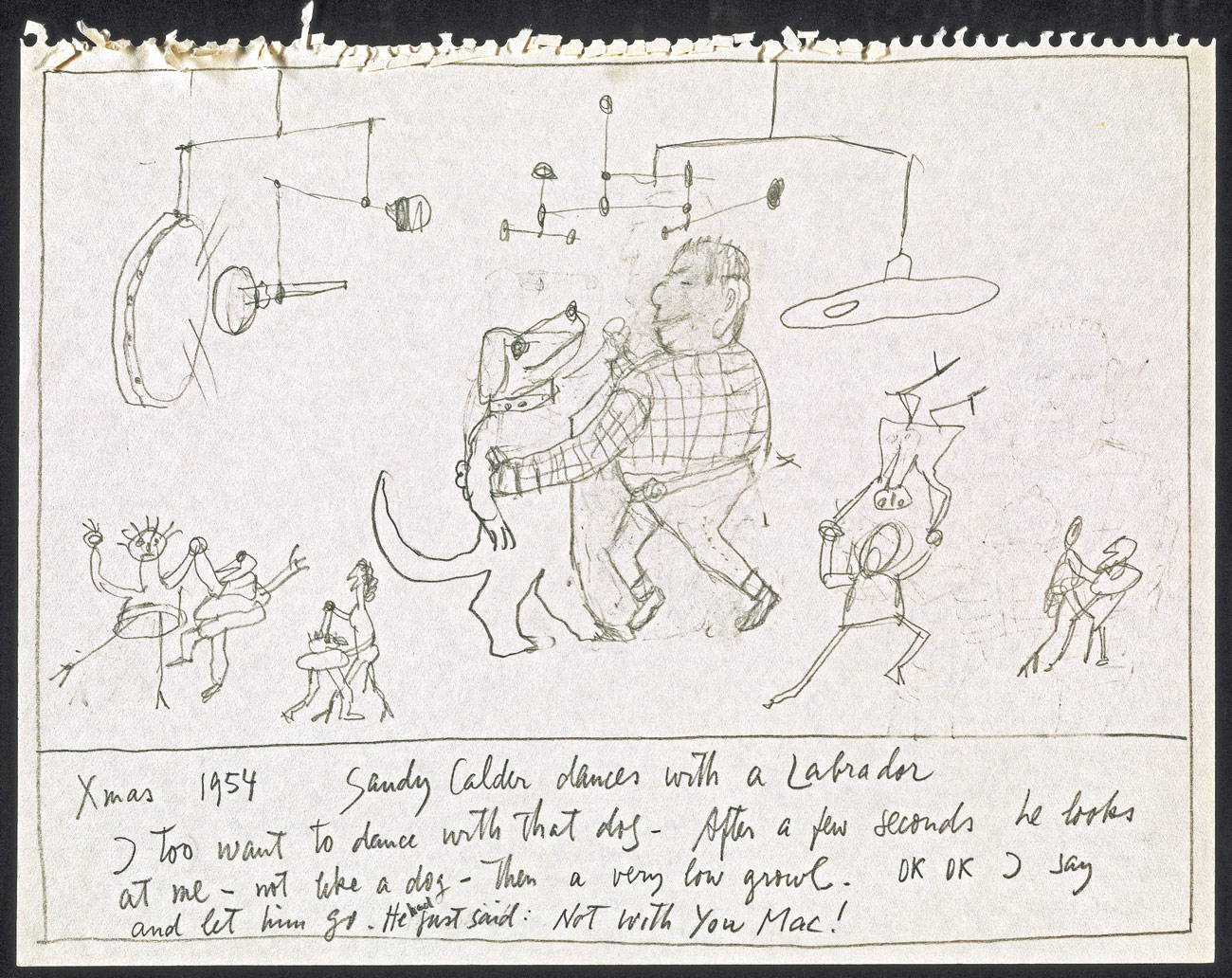
1955
January 8-13, trip to the southern US; visits Oxford and Vicksburg, Mississippi; Memphis, Tennessee; Birmingham, Alabama; St. Petersburg and Tampa, Florida.
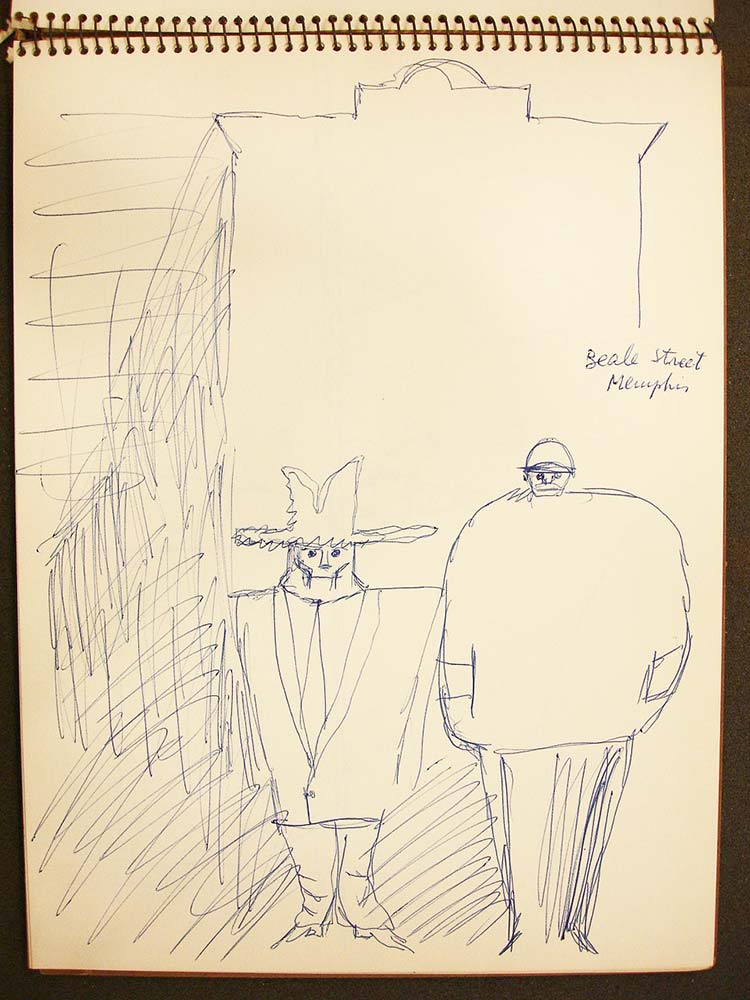
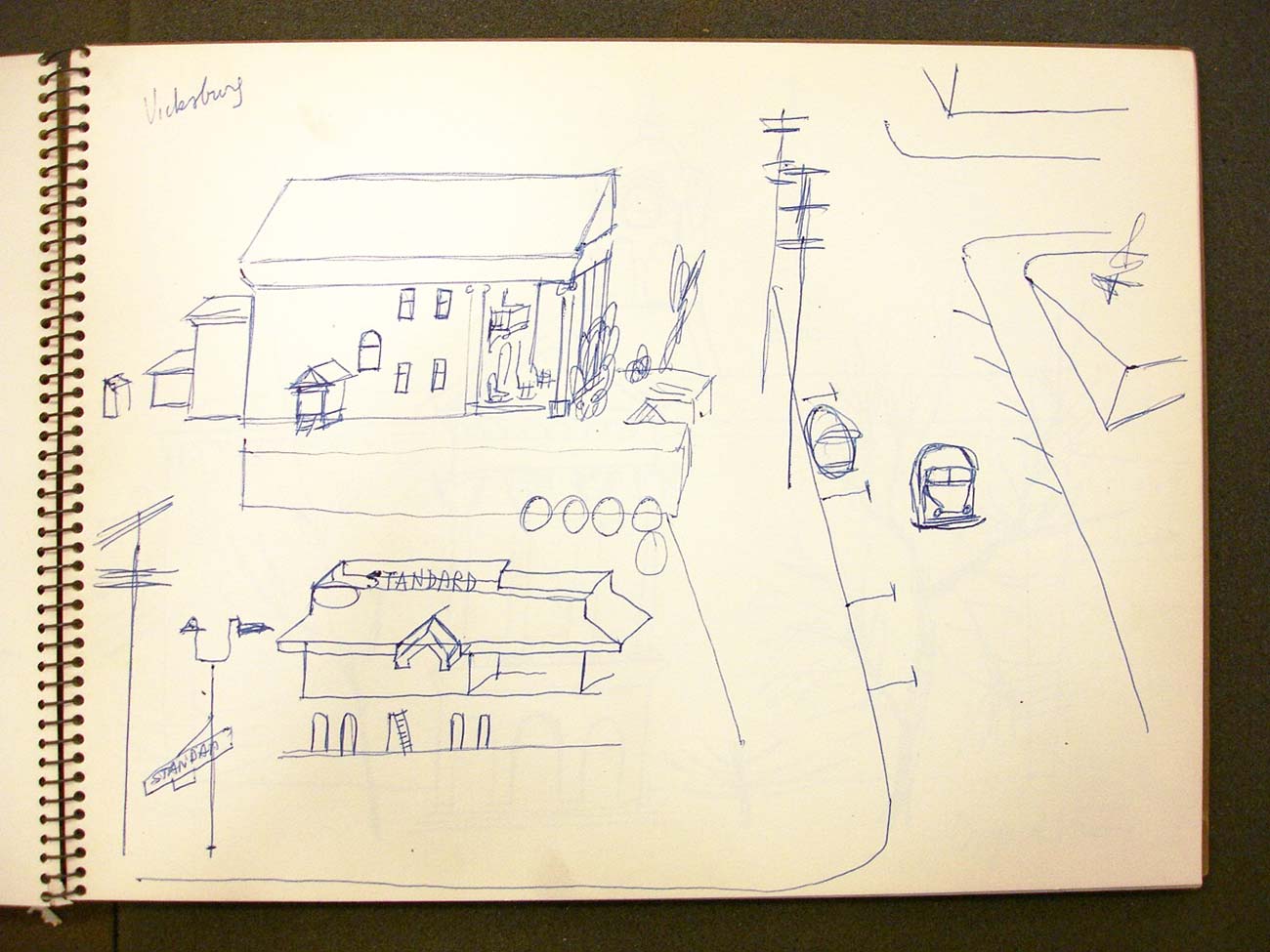
March 2, to Boston for the installation of his exhibition at Harvard’s Graduate School of Design, Robinson Hall, “Steinberg: De Architectura,” organized by José Luis Sert; first exhibition to focus on architectural themes in Steinberg’s work.
March 15, arrives in Paris; March 23, flies to Rome, then by train to Tortoreto to see the villa in which he was interned as an undesirable in 1941. “What I wanted in Tortoreto was to give myself a proof of maturity or courage… The truth is I ran away as soon as I looked at the [villa].”
For the next two weeks, travels through Italy; visits Ada Ongari, his old girlfriend in Milan, who is not in good health.
By April 7 in Nice to visit parents; back in Paris by April 11; Hedda arrives from New York on May 3.

Hedda leaves in mid-June for Wellfleet, Massachusetts, to spend the summer; ST returns to New York on July 10, then goes on to Wellfleet.
Returns to New York on September 9.
Panoramic drawing for the opening credits to Alfred Hitchcock’s film The Trouble with Harry. ST tells Aldo Buzzi that “Hitchcock showed up and begged me to make this drawing, which he considered very important: he feared that the public would be repelled by the sight of a corpse (oh, the good old days!). So I made a drawing for the opening sequence, which I’d call morto divertente”—“entertaining corpse,” a play on molto divertente, “very entertaining.”
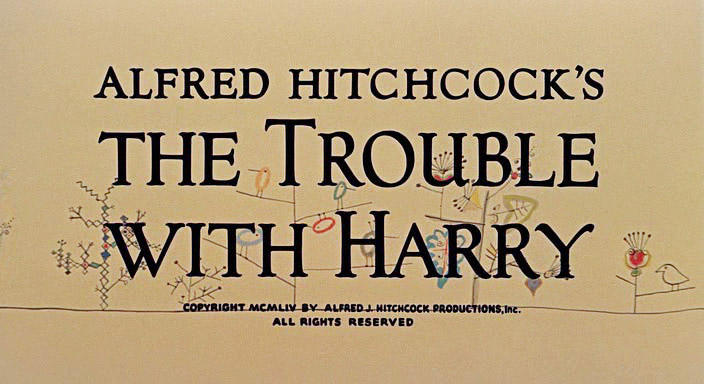
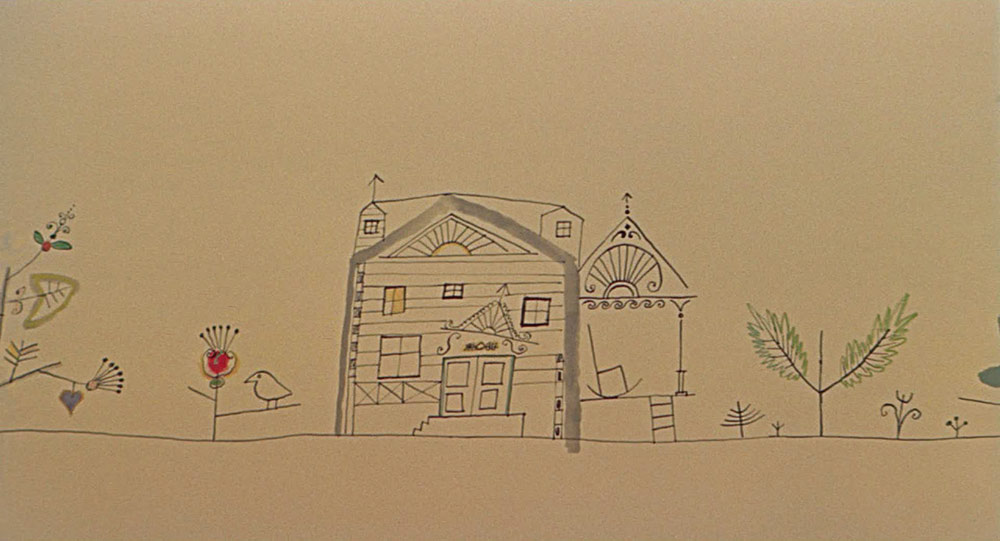
1956
February 14, flies to Russia on assignment for The New Yorker; stopovers in Paris, Stockholm, and Helsinki; arrives in Leningrad, February 18. Spends five weeks in Russia, traveling to Moscow, Kiev, Odessa, Tbilisi, Kharkov, Samarkand, Tashkent. Fills sketchbooks with drawings and also takes photographs. The trip results in two portfolios of drawings, published in The New Yorker, May 12 and June 9, 1956.
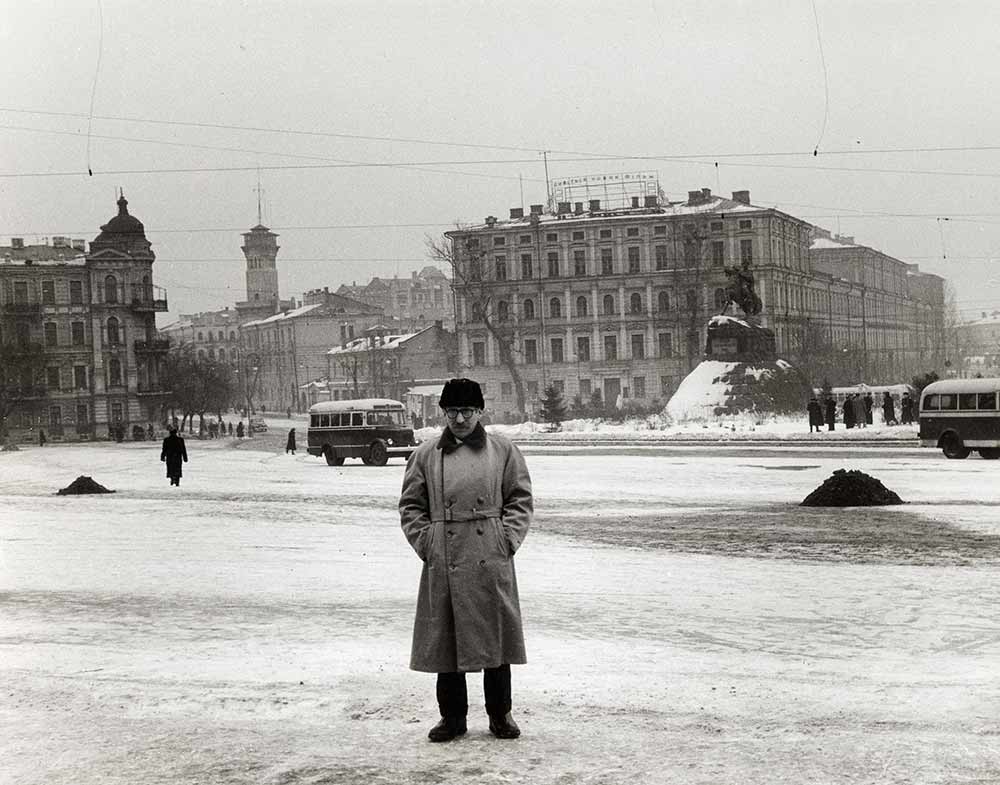
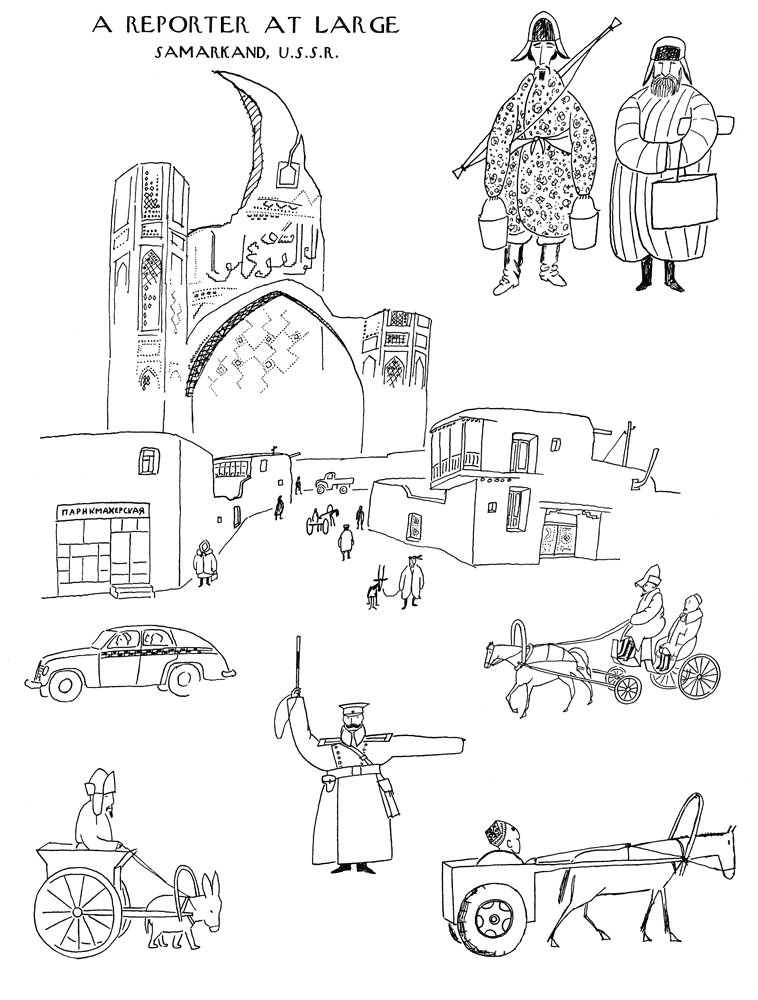
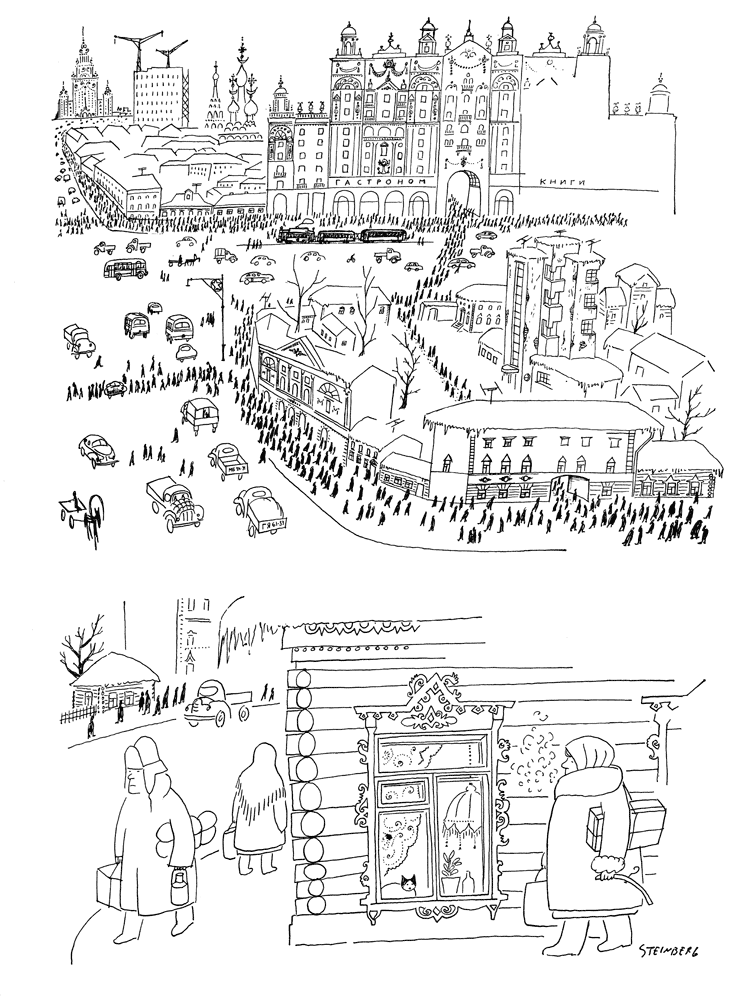
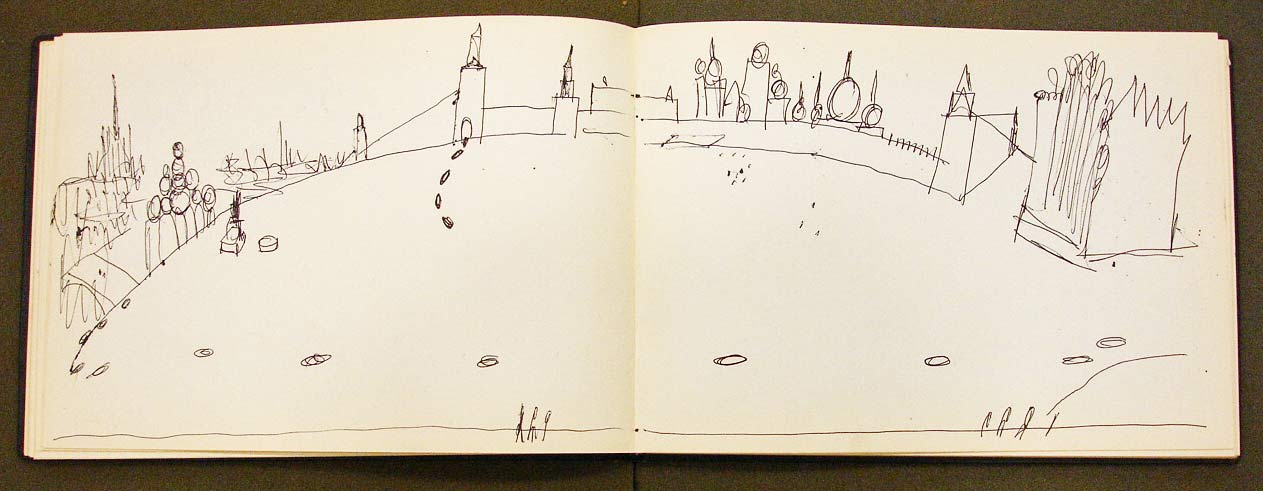

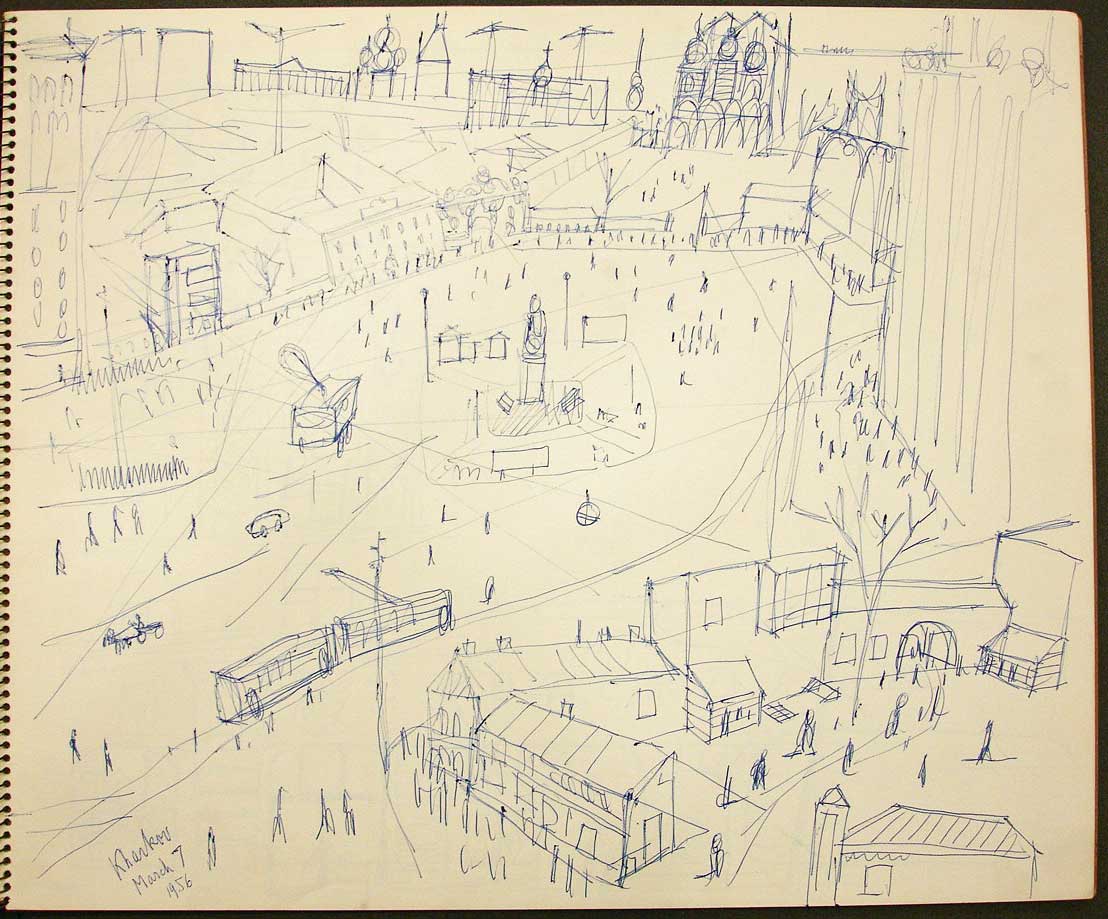
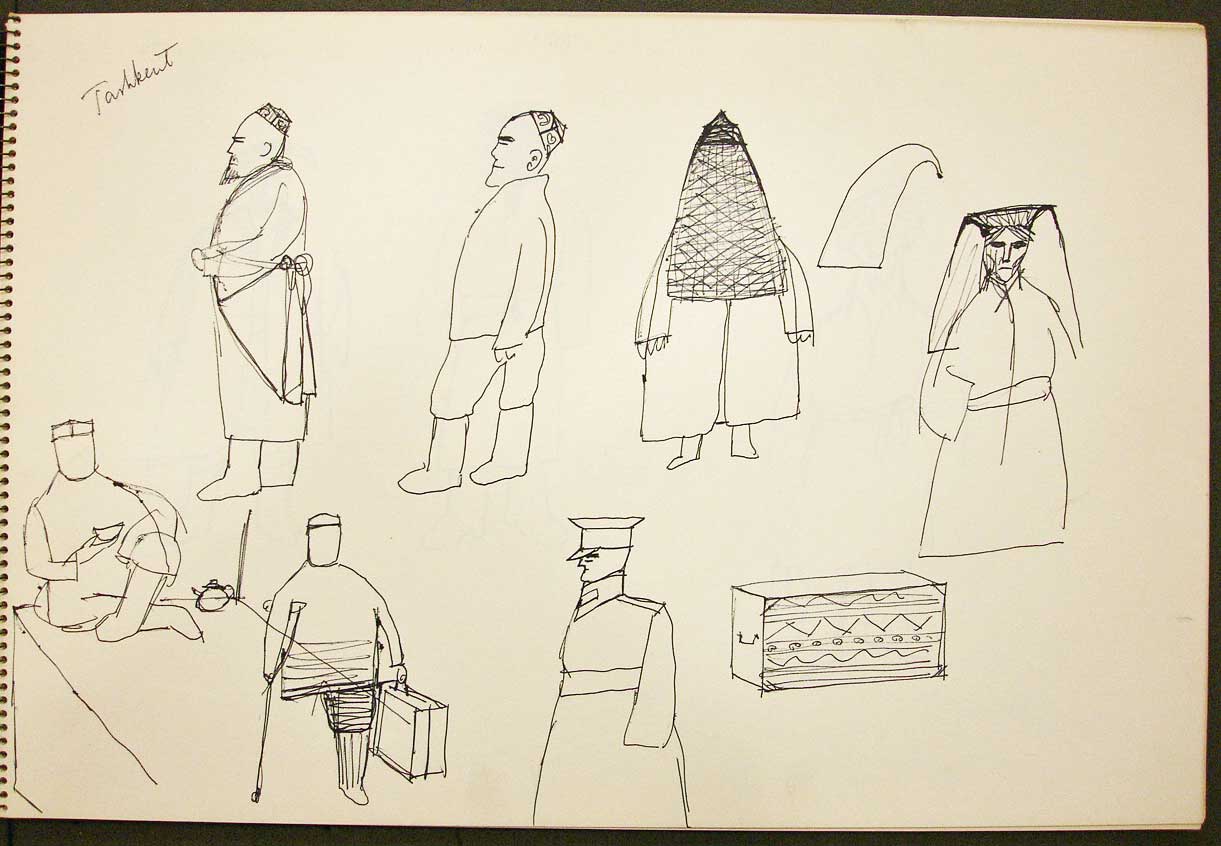
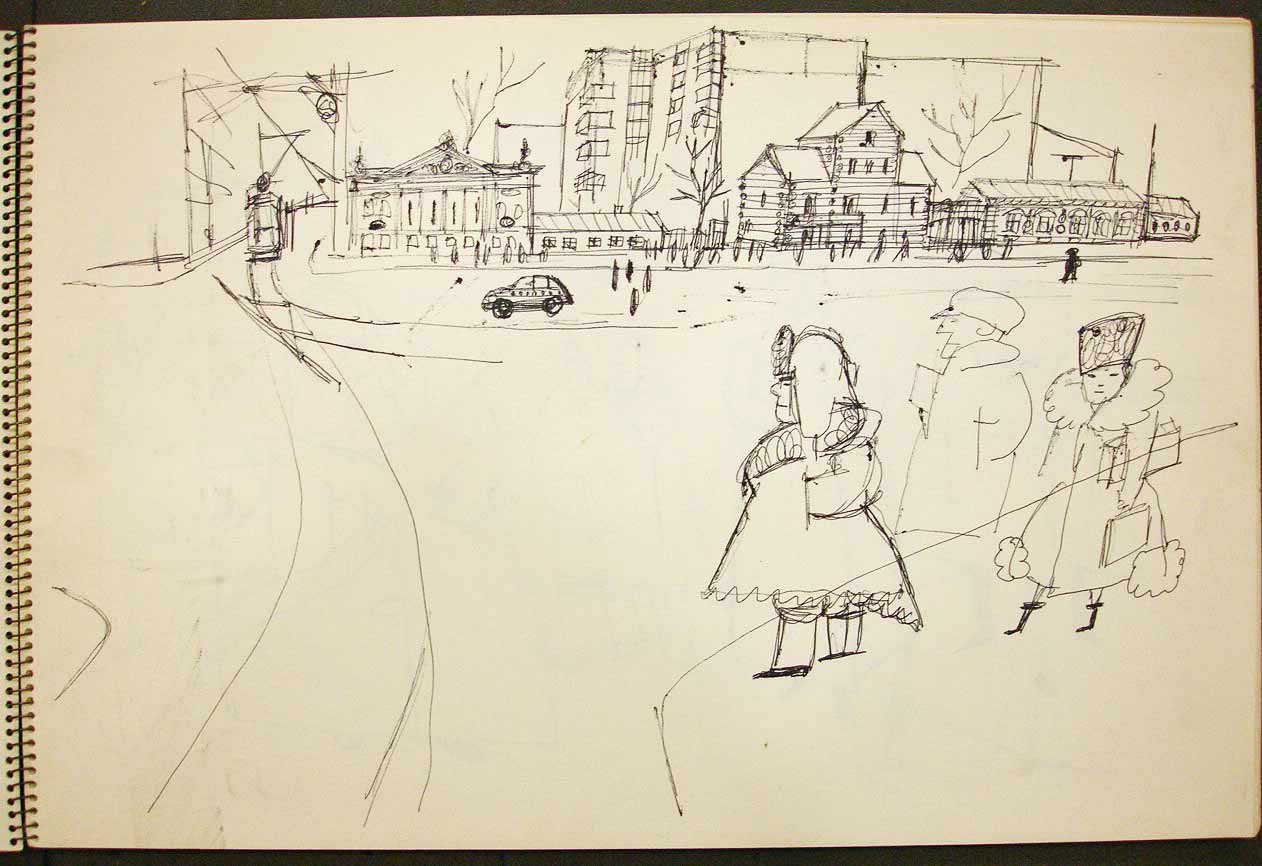
March 6, premier of Jerome Robbins’s ballet The Concert, at the New York City Ballet, with backdrop by ST; for a revision of the ballet at the Festival of Two Worlds in Spoleto, Italy, 1958, ST creates a new backdrop.
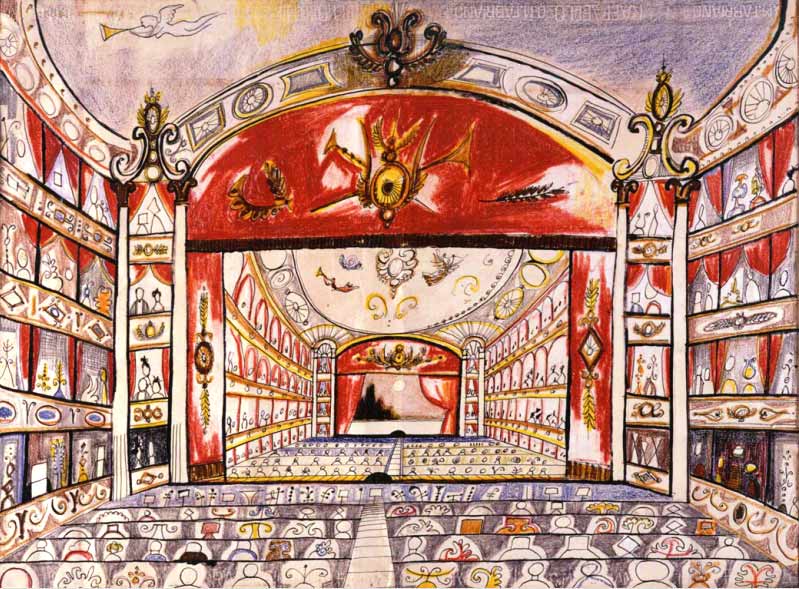
Summer, ST and Hedda make a cross-country road trip, spending time in Alaska (Anchorage, Ketchikan, Juneau, and Fairbanks); they return in mid-August and go to Wellfleet, Massachusetts, till the end of the month.
Publication of Dessins by Gallimard, a French compilation from ST’s three previous books of drawings.
1957
March, ST and Hedda leave for an extended trip to France, Italy, and Spain. After visiting his parents in Nice, they drive south through Italy, arriving in Rome in early April.
May, in Spain—Granada, Madrid, San Sebastián, and other seaside resorts. But he tires of playing the tourist, writing to Aldo Buzzi, “The big tour of Europe was a mistake. I’m still thinking of spending a year in Italy.”

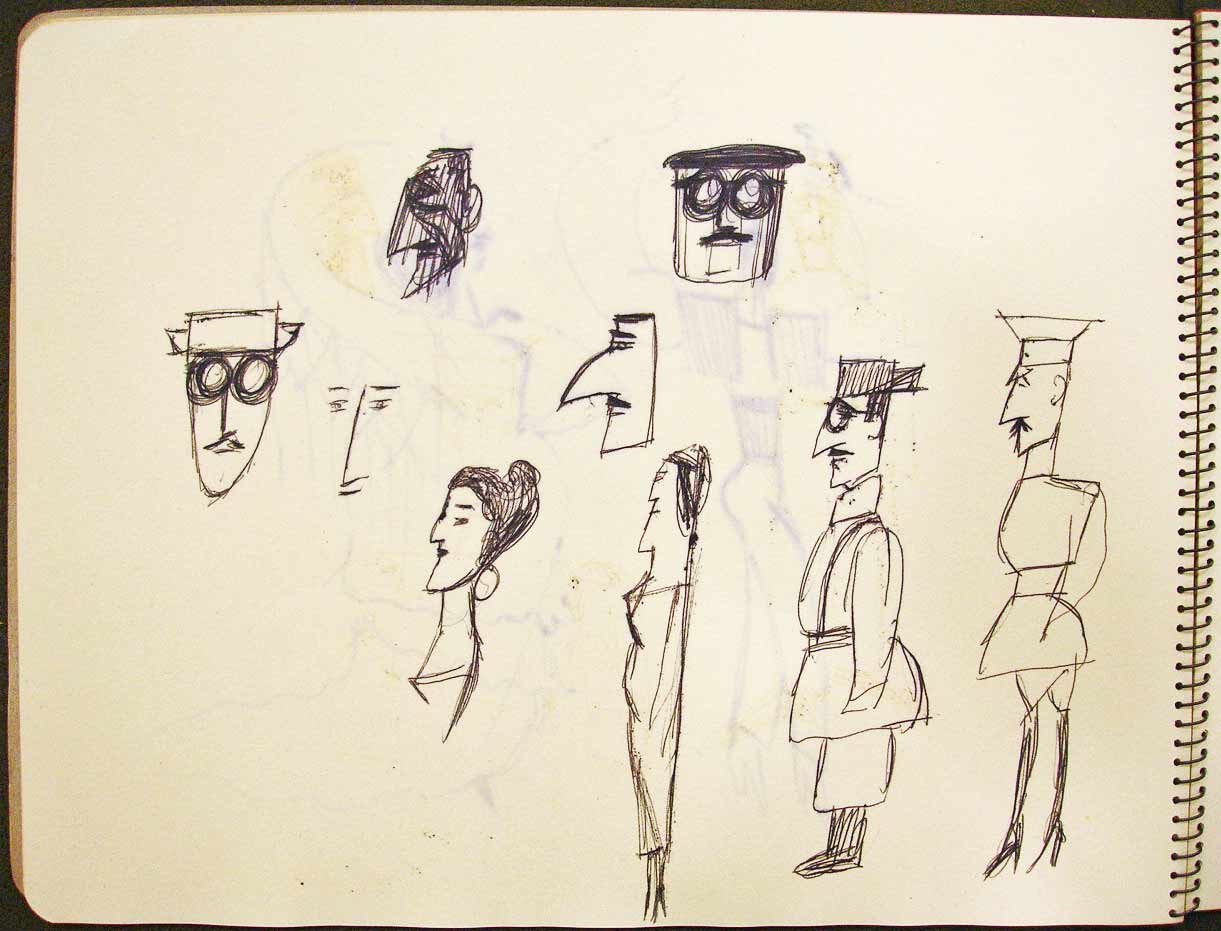
June, ST and Hedda return to New York; by August they are in Wellfleet.
August 26, receives a telegram from his mother in Nice that his sister, Lica Roman, brother-in-law, Ilie (Rica) Roman, and their two children, Stéphane and Daniela, have secured permission to leave Bucharest with visas for Israel. Around September 1, ST flies to Italy.
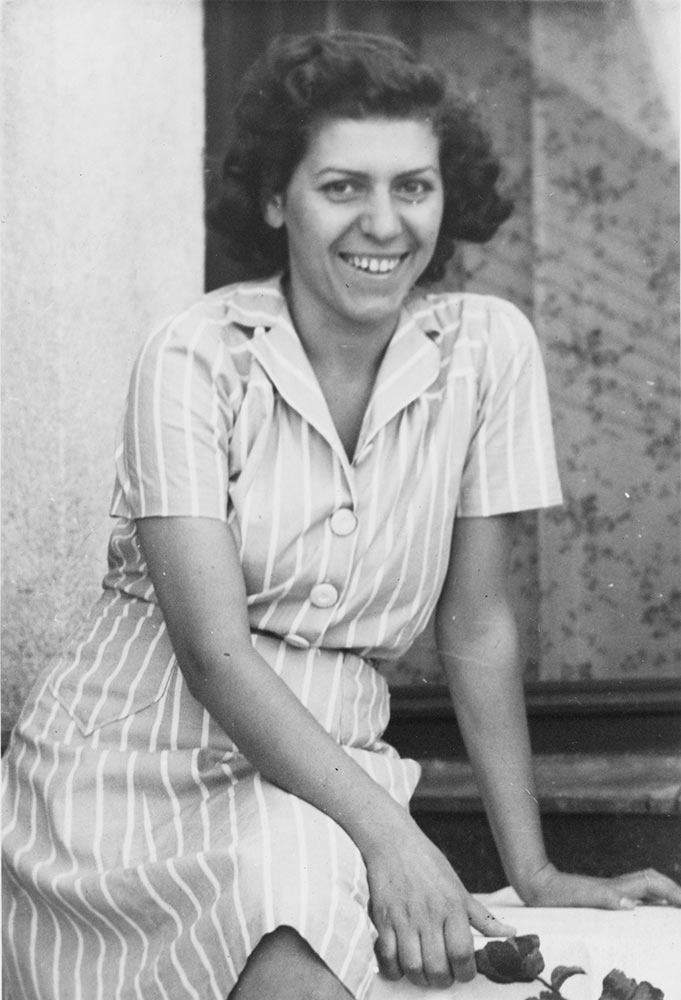
The Romans arrive in Vienna, then travel by train to Genoa, where ST meets them on September 5. He now has to secure French visas for them before September 16, when they are scheduled to leave for Israel. Through many phone calls and cables, he calls in favors and manages to get the visas in time. By September 12, they are all in Nice, reunited with the parents. ST now supports six people.
September, begins correspondence with his friend, the architect, interior designer, and author Bernard Rudofsky, about a monumental mural commission for the US Pavilion at the 1958 Brussels World’s Fair. Rudofsky, along with his partner Peter G. Harnden, are the architects for the interior exhibitions. Mid-December, accepts the commission.
1958
January, begins working on Brussels mural commission, now titled The Americans—8 themed sections, 10 feet high and 240 feet in total length.
February 27, sends the first drawings to Bernard Rudofsky.
March, buys a Jaguar with money received for the Brussels mural. It is delivered to him in Brussels and later shipped back to the US.
March 16, arrives in Brussels to work on The Americans. He has made drawings for the backgrounds, which are photographically enlarged and affixed to the 8 sections. He now has to add cutouts, collaged figures, and other elements. The project is beset by technical problems, especially with glue that doesn’t hold. Finds that he has to make 100 more figures than anticipated.
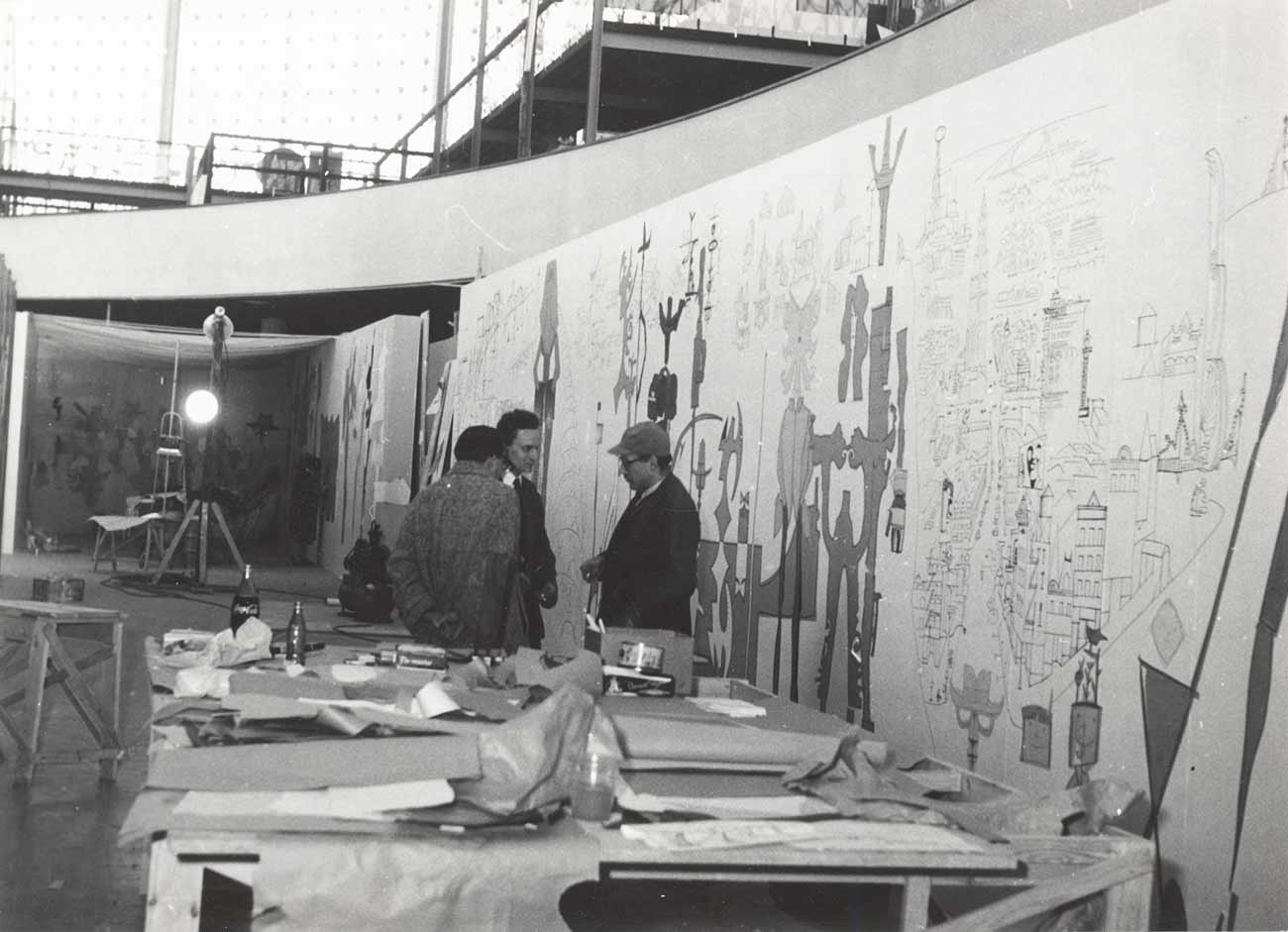
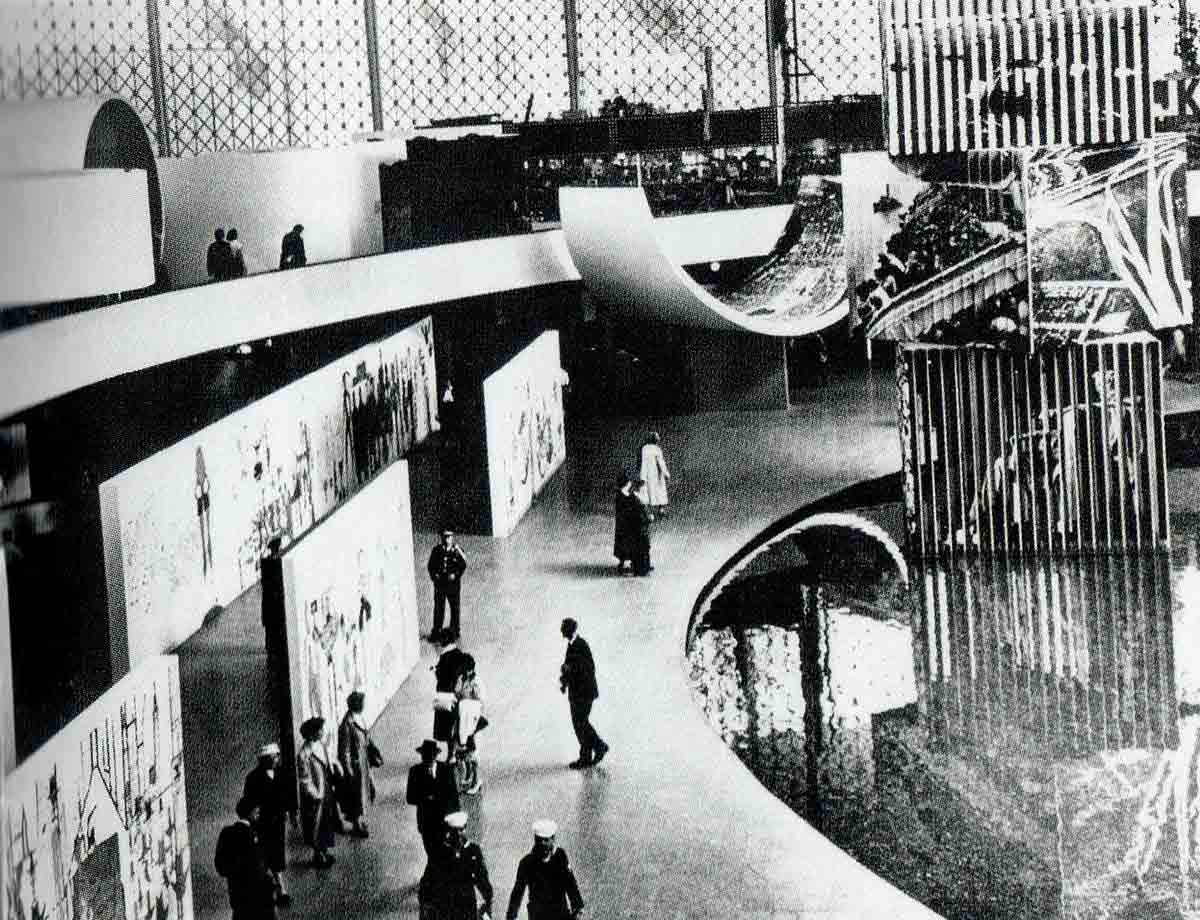
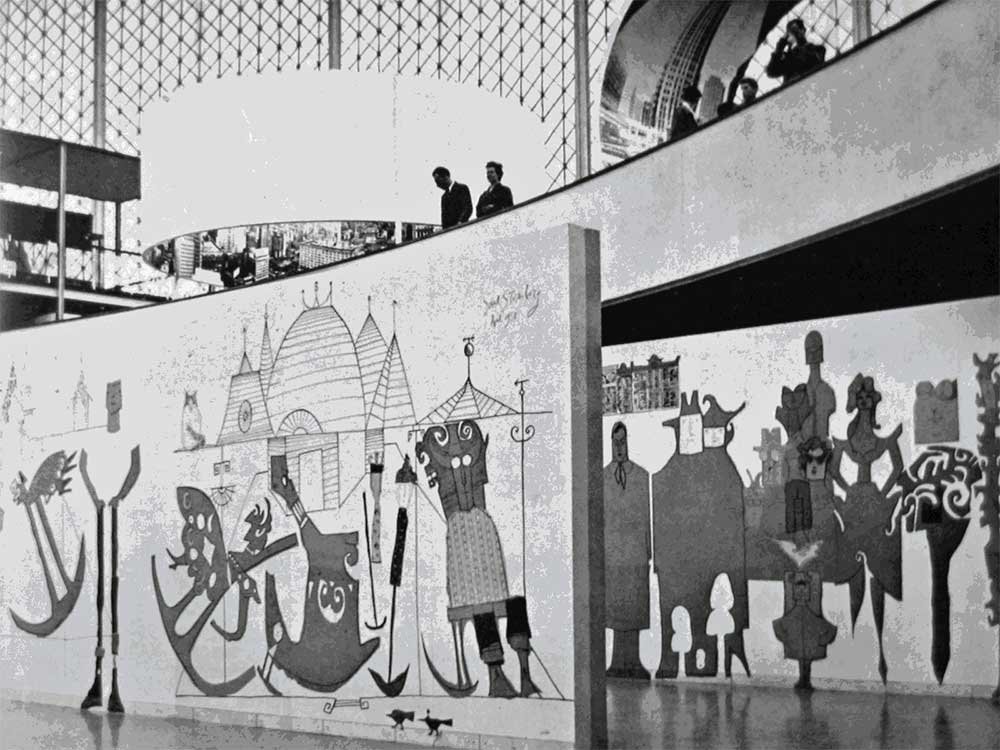
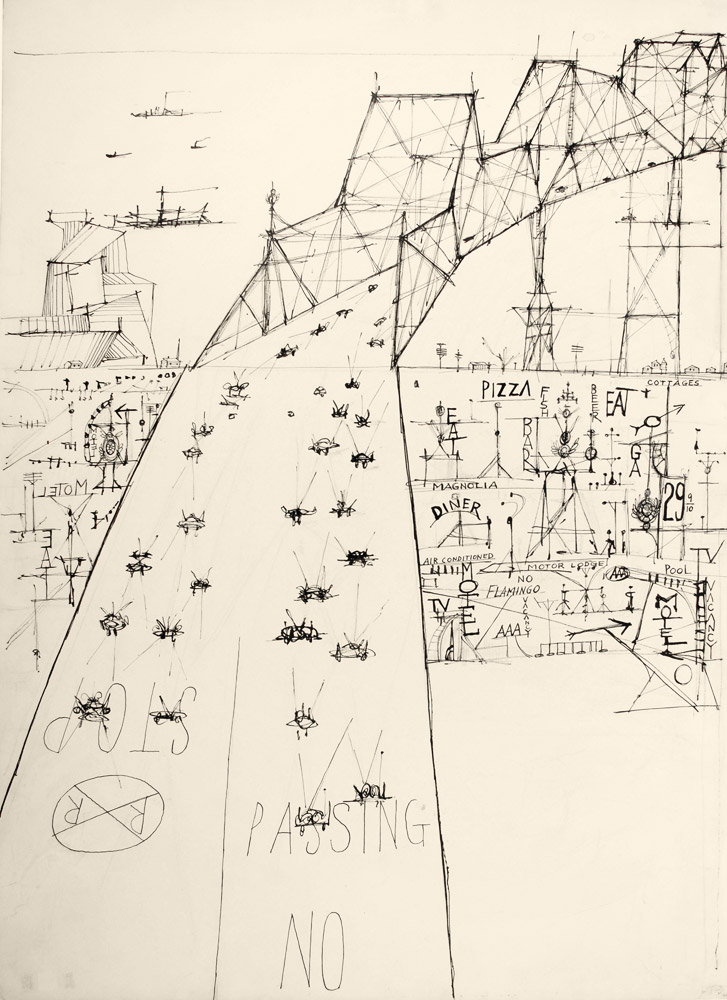
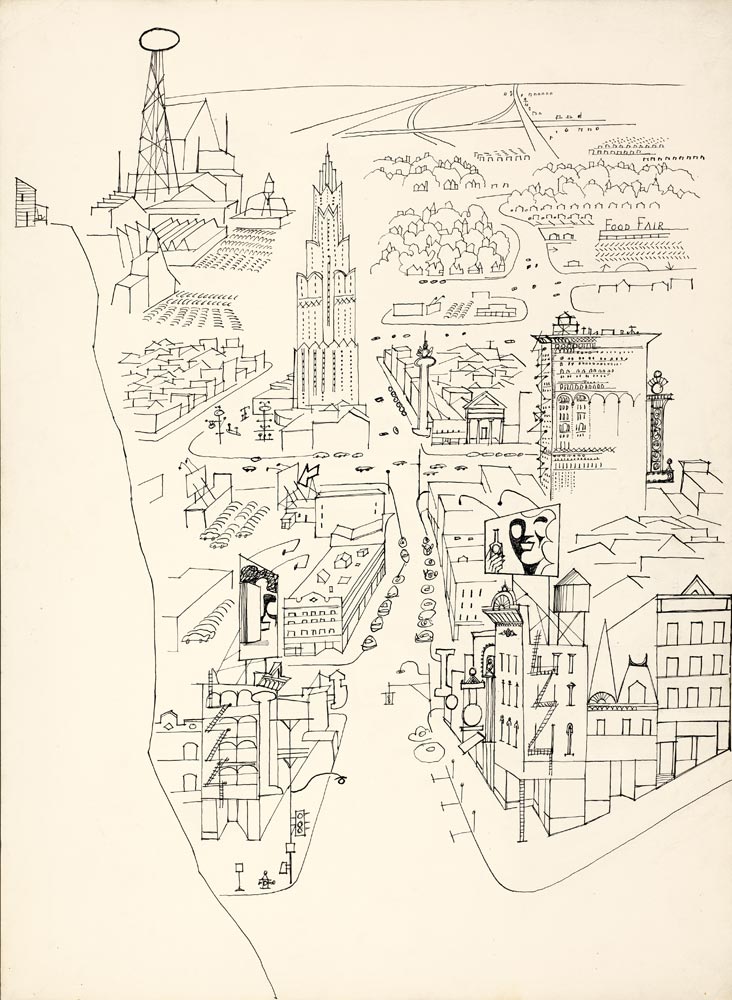

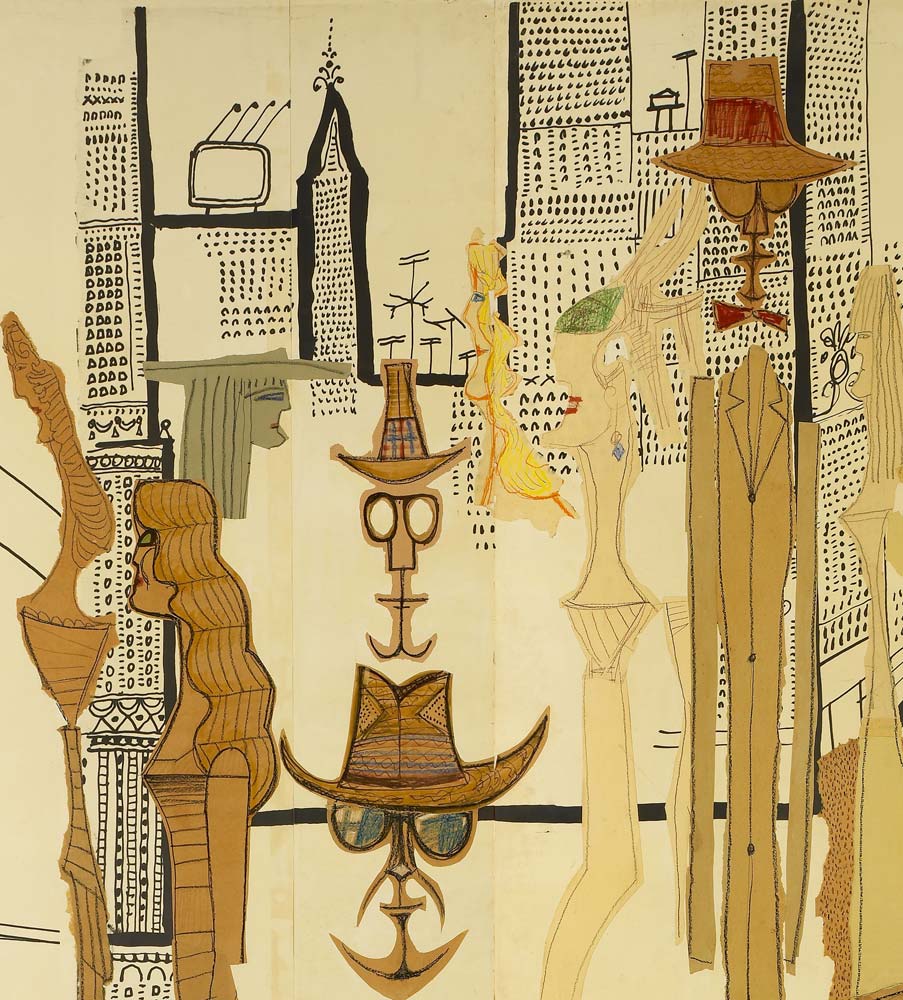
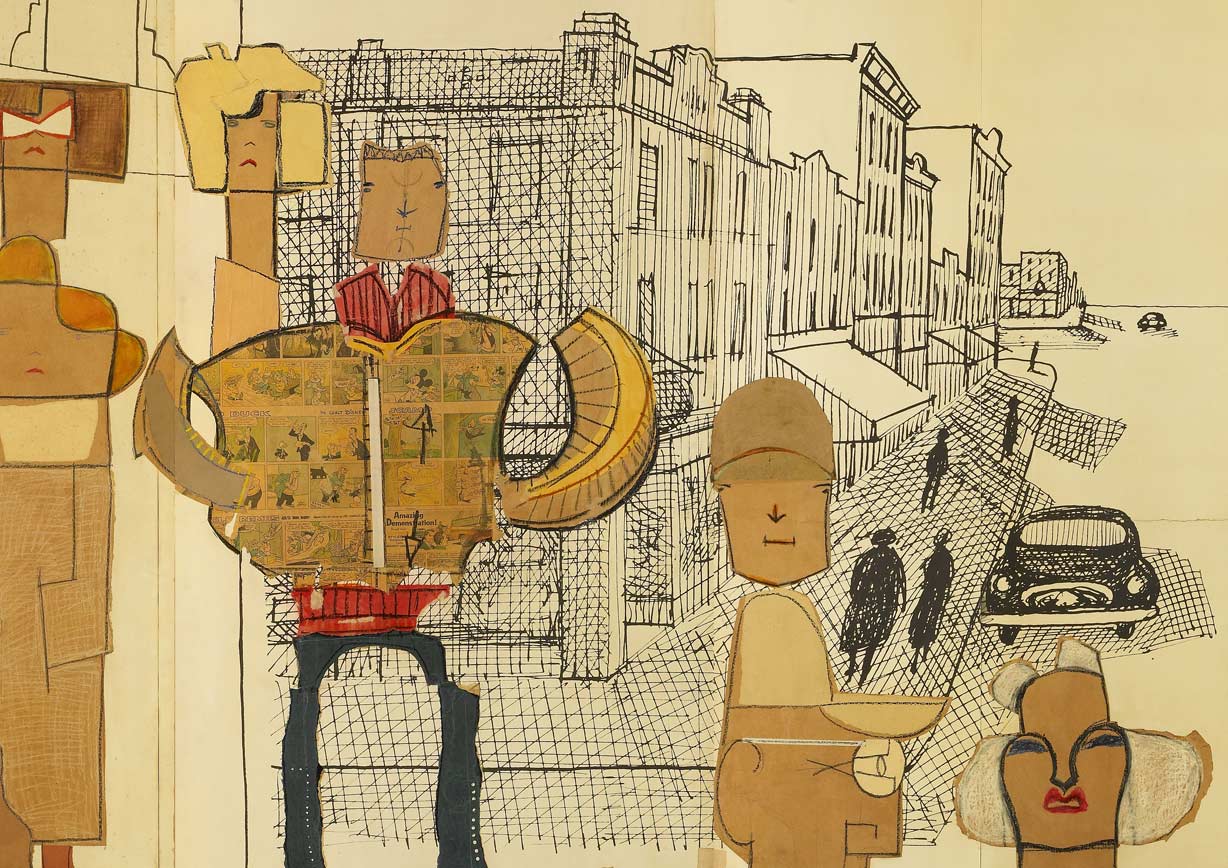
April 16, the day before the pavilion opens to the public, he drives to Paris; a week later, to Nice to visit parents. Then on to Rome and Milan; leaves on May 12 for another stay in Nice.
May 16, visits Picasso at his villa “La Californie” in Nice. Together, they do four “exquisite corpse” drawings. ST keeps two and frames them. On July 8, he sends Picasso a diploma with faux calligraphy and, in December, a Christmas card.
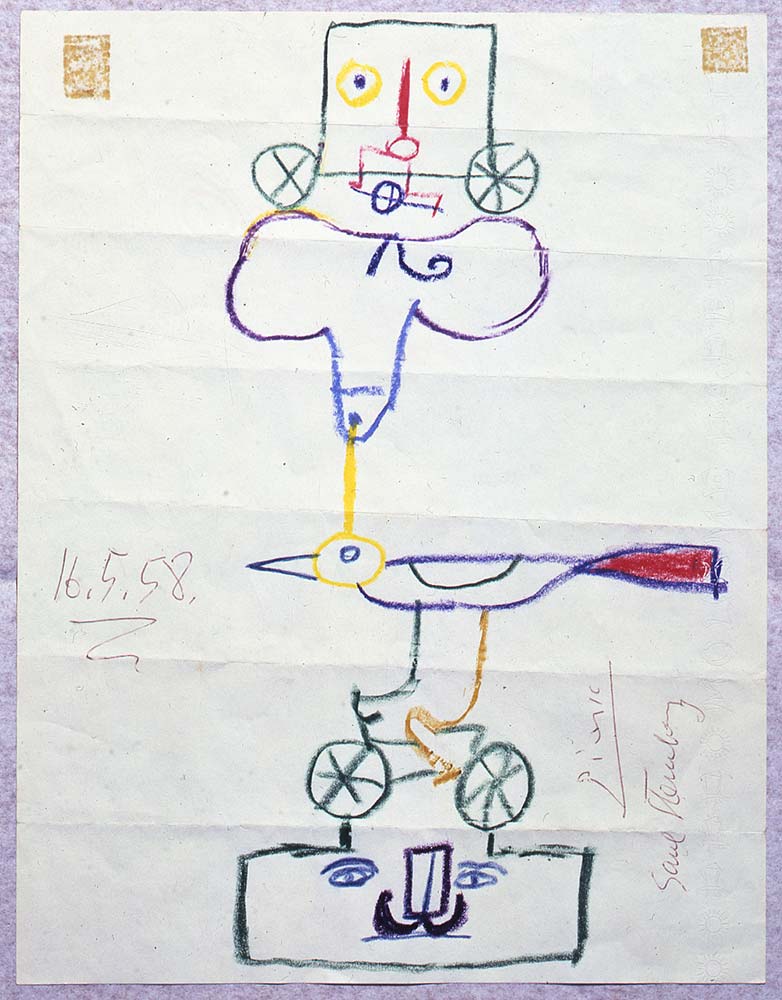
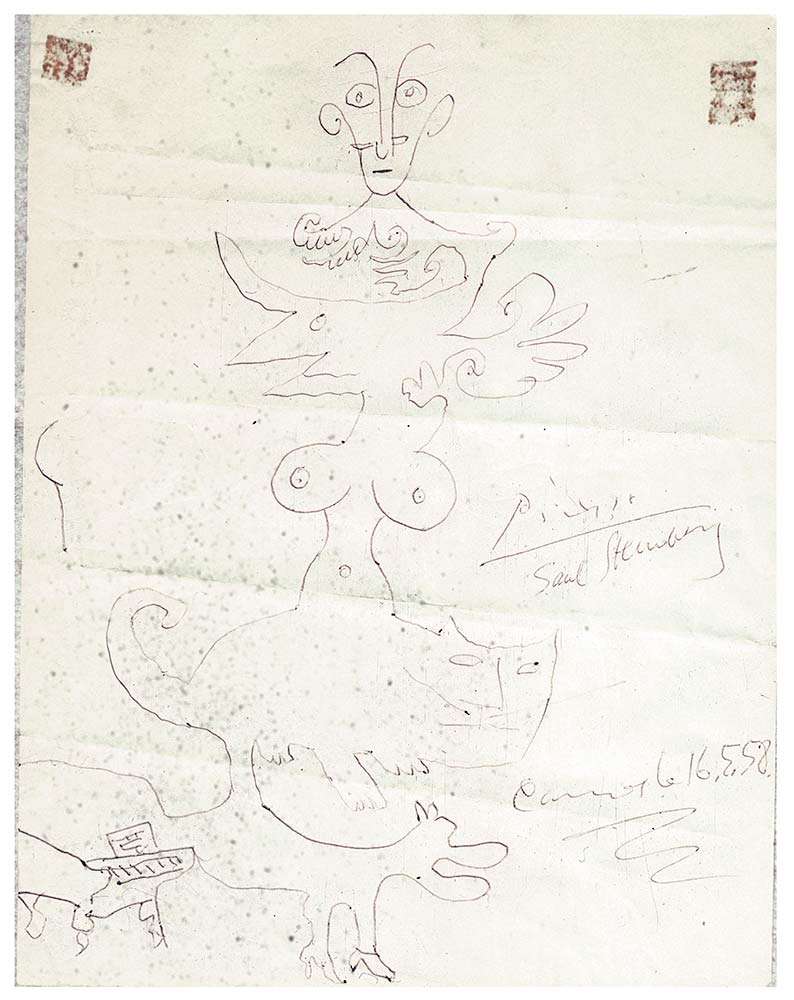
Back in New York by the end of May.
June 5, first performance of the revised version of Jerome Robbins’s The Concert with new ST backdrop at the Festival of Two Worlds, Spoleto, directed by Gian Carlo Menotti.
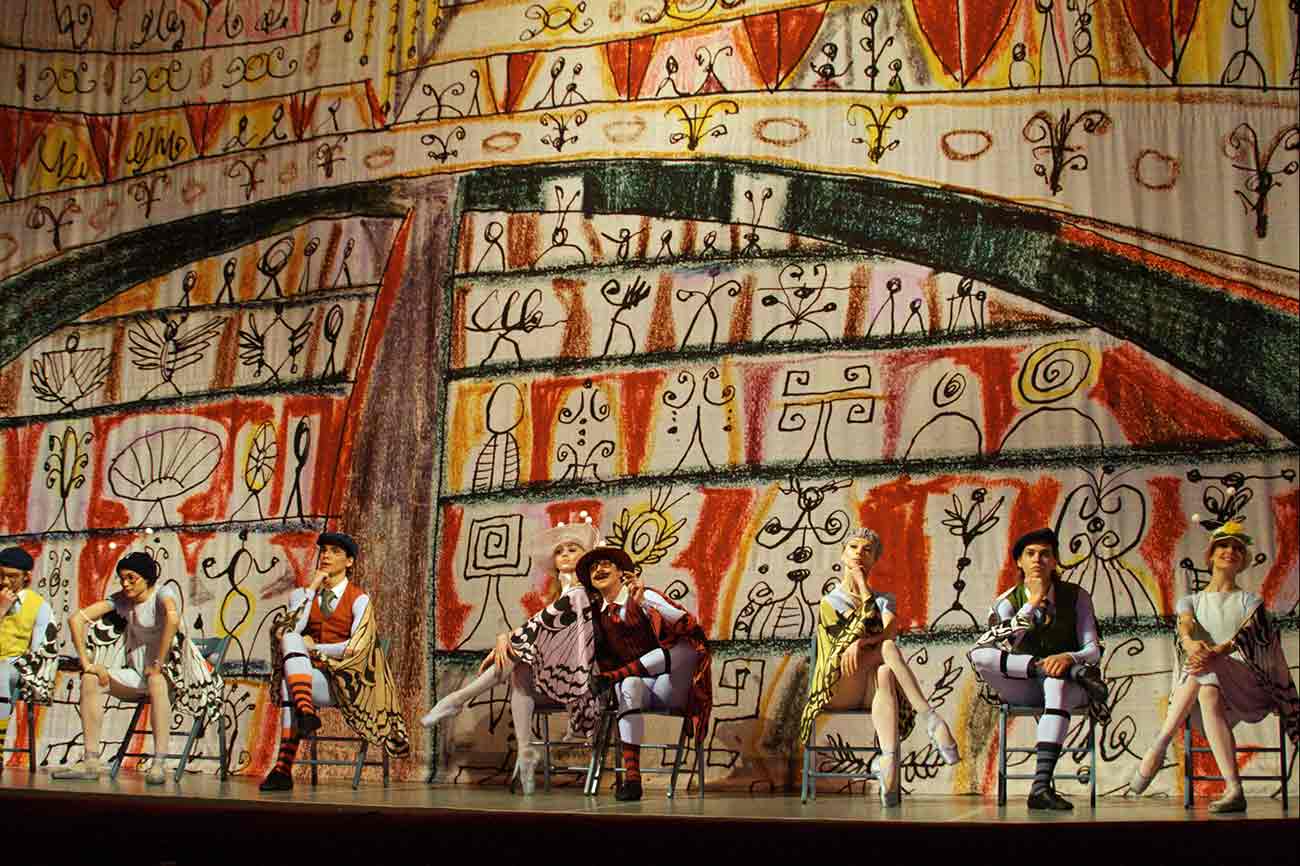
July 2, ST’s sister and her family move to Paris. His parents remain in Nice.
July, a travel sketchbook records a driving tour through the American South—“Aberdeen, MD, South Hill, VA, Greensboro, NC, Greensville, SC, Chattanooga, Ten., Athens, GA, Motel 119 Toler KY, Middlesboro KY—Belfry—near Williamstown W Va. Uniontown PA.” He writes to Buzzi, “I’ve seen poor coal-mining localities in Kentucky and West Virginia. An old America, religion, violence, horrible landscapes, miners living in African villages. Here’s where they ought to make a film.”
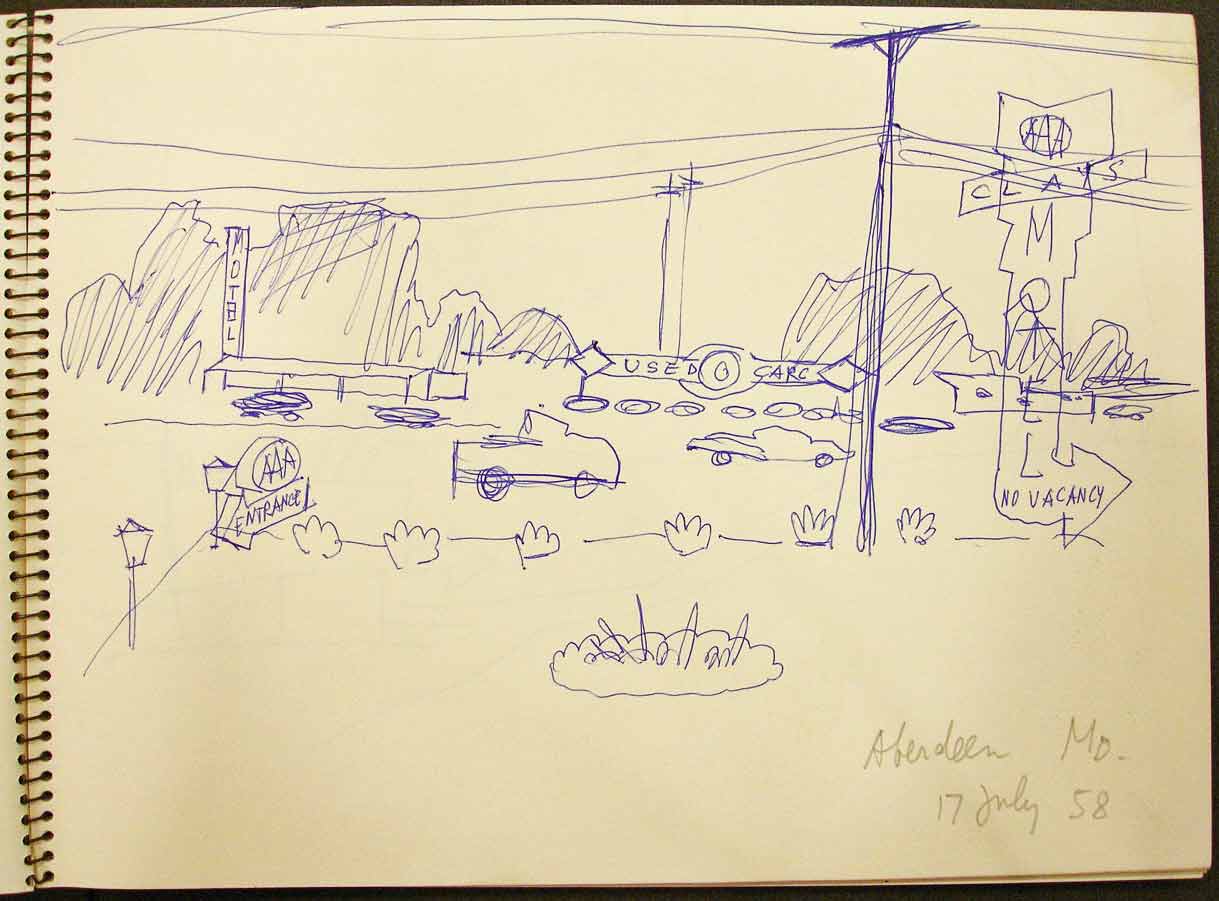

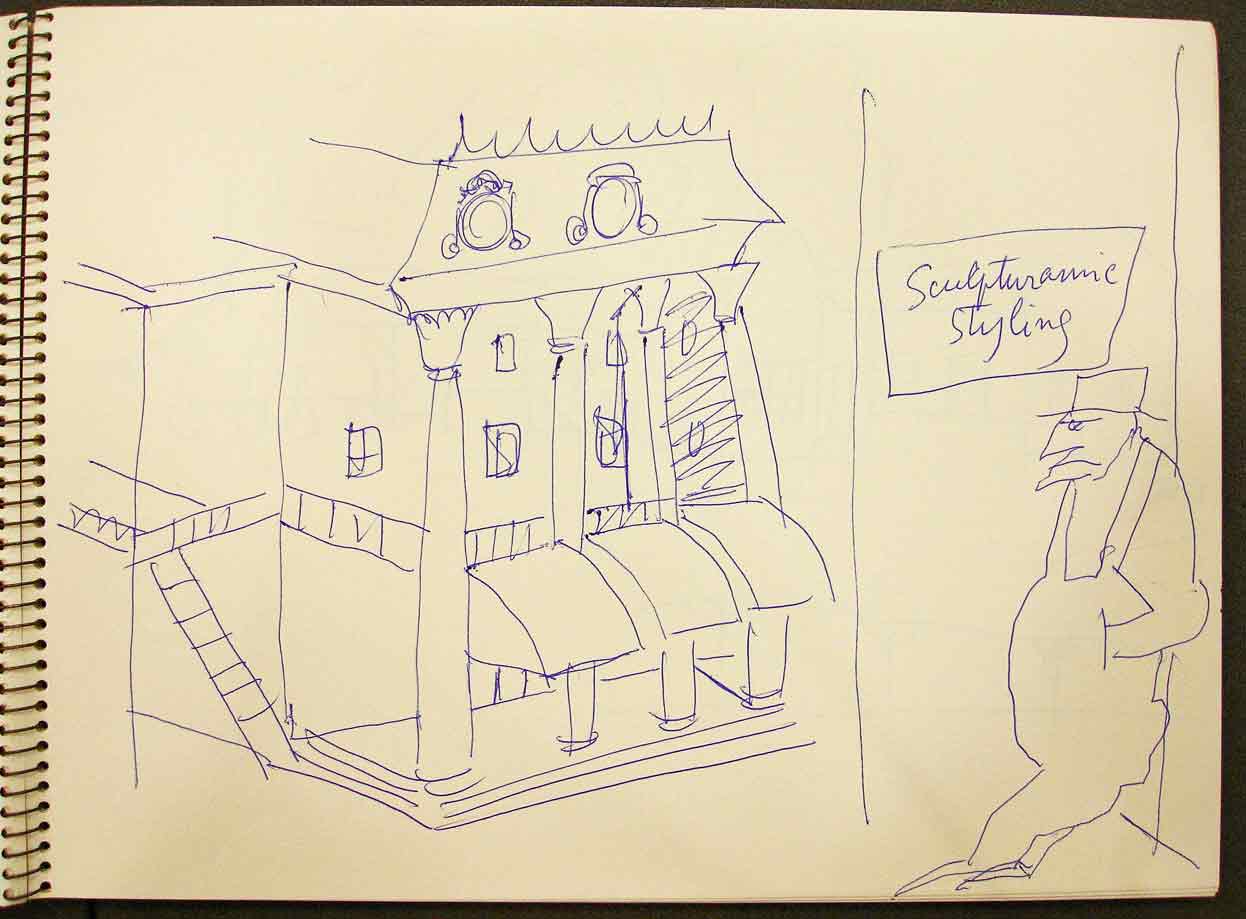
December 1, flies to Copenhagen. Mathematician Piet Hein introduces him to Danish film director Carl Theodore Dreyer. Agrees to contact William Faulkner with Dreyer’s proposal to turn several Faulkner novels into films.
December 9, flies to Hamburg, then goes to Paris by train; December 21, flies back to New York.
Publication of the first, Paris edition of Robert Frank’s photo book Les Américains by Delpire Éditeur, with a cover drawing by Steinberg. In the subsequent US edition, the drawing is replaced by a Frank photo.
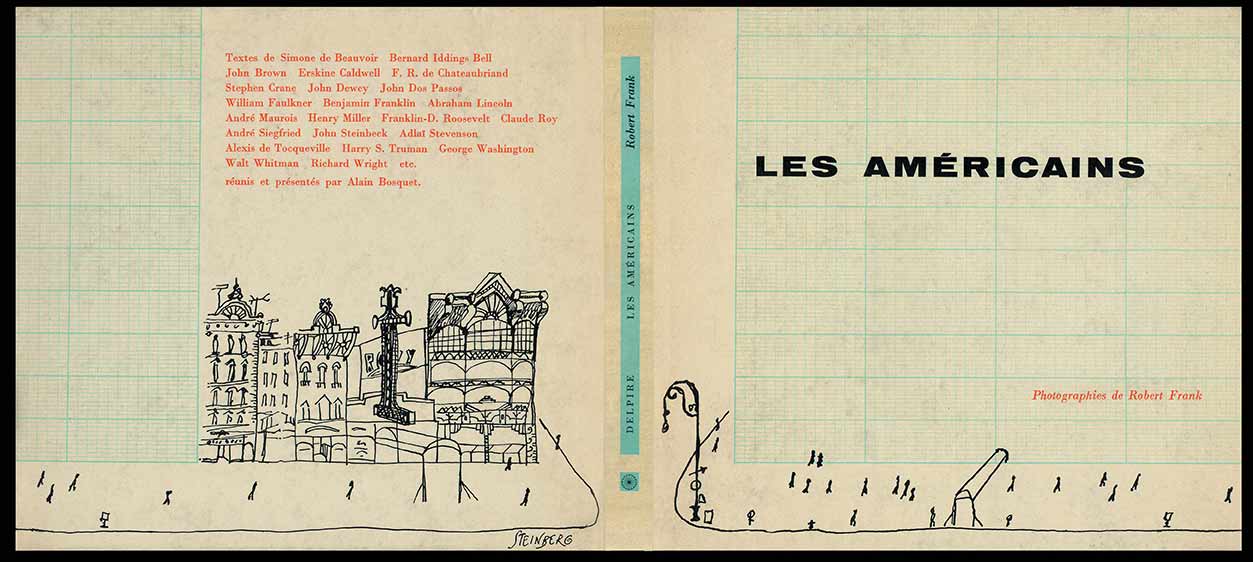
1959
January-February, through his friend, violinist Alexander Schneider, meets photographer Inge Morath, recently arrived in New York.
Makes first paper-bag masks with brown supermarket bags. These are self-portrait masks, which Morath photographs ST wearing in early 1959. In 1961-62, he creates masks of a variety of social types. He and Morath collaborate on a series of photos with people wearing other ST masks—“different people,” she said, “adapting their bodies and gestures to the Steinbergian persona they wore as a mask.”
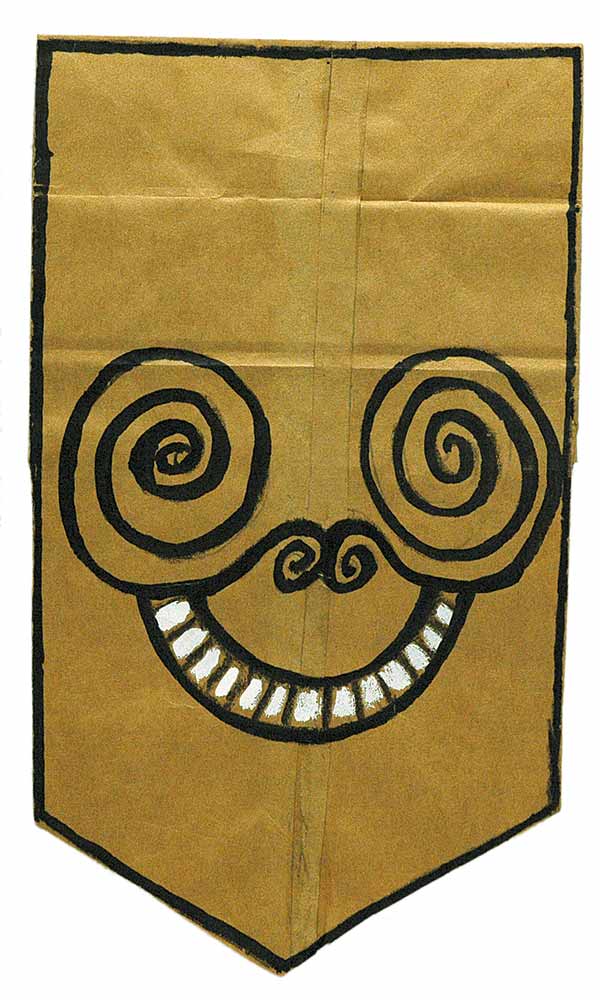
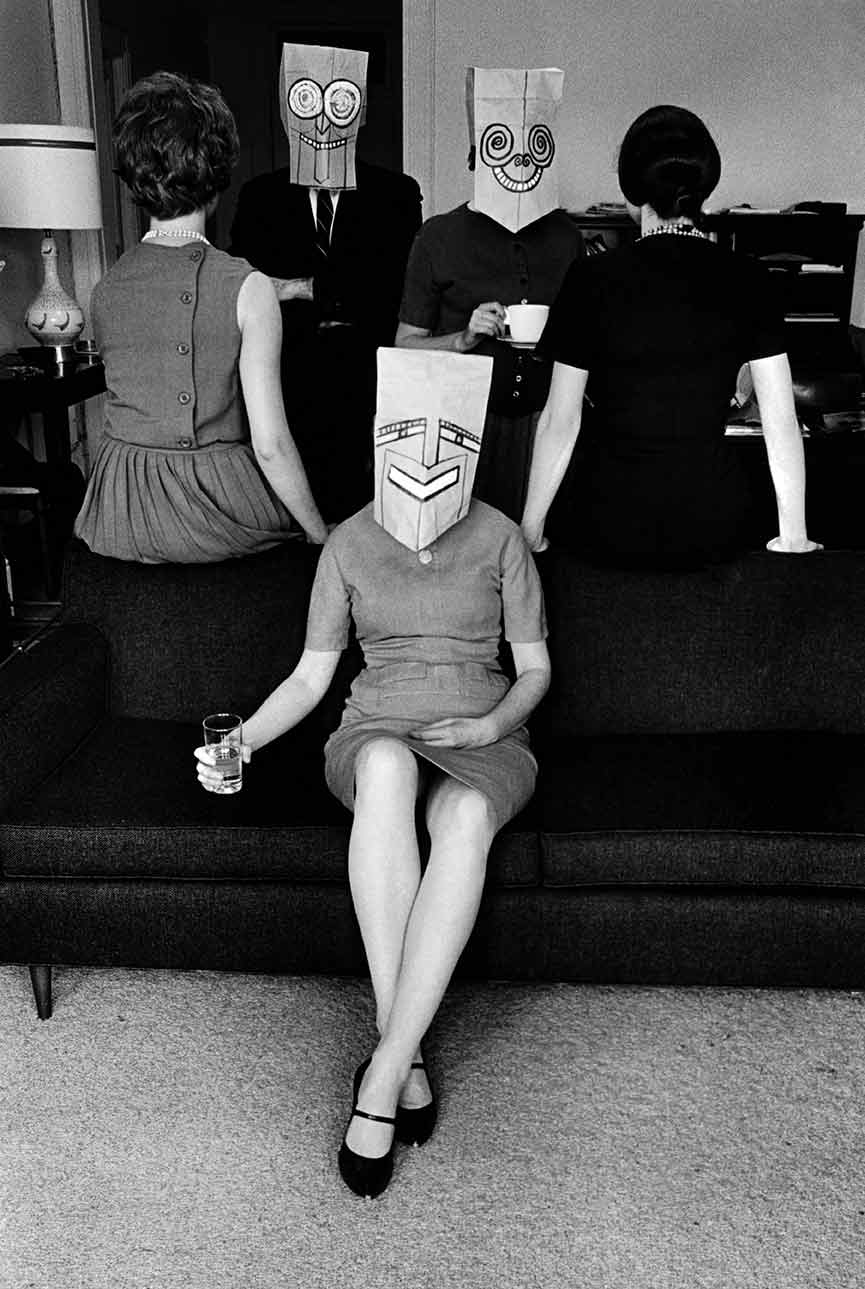
January 17, his third New Yorker cover, The Pursuit of Happiness (also known as Prosperity), marks the beginning of his years as a regular cover contributor; it is also the first of his covers with a sociopolitical theme.
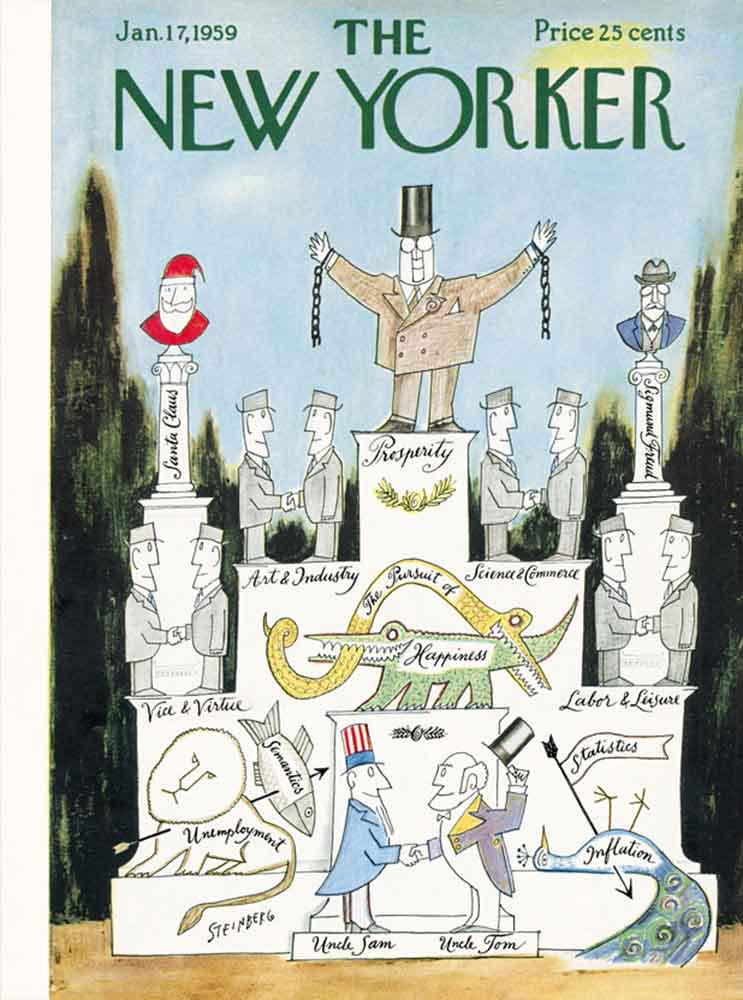
March 13, The Count Ory, a comic opera by Gioachino Rossini, opens at the Juilliard Opera Theater, New York, with backdrops by ST.
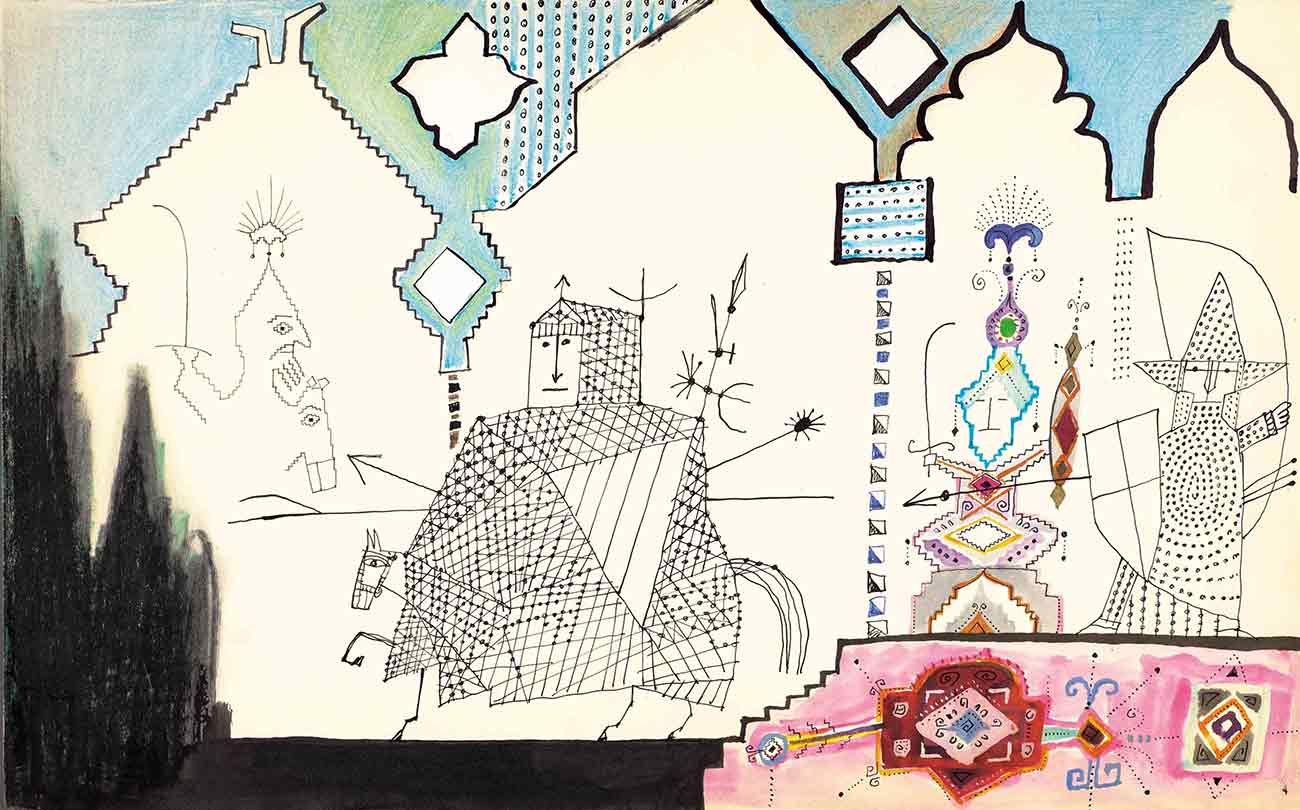
May 22, completes purchase of house on Old Stone Highway in Springs, within the district of Amagansett, on the eastern end of Long Island. The house is across the road from Costantino and Ruth Nivola, who remain among his closest friends. It will become his refuge from the busy life of New York.

August, trip to Utah, Nevada, Colorado, Arizona, and Texas by plane, car, train, and bus. Of Las Vegas, he reports: “I’m disgusted. Even the cigarette machines are crooked here. Most of the time they take money & give you nothing.” Describing a visit to cousins in Denver: “They live in a ranch-type house in a block with a ranch-type synagogue.”
Agrees to design full-color calendars for Hallmark instead of Christmas cards. The first one appears in 1960, the last in 1969.
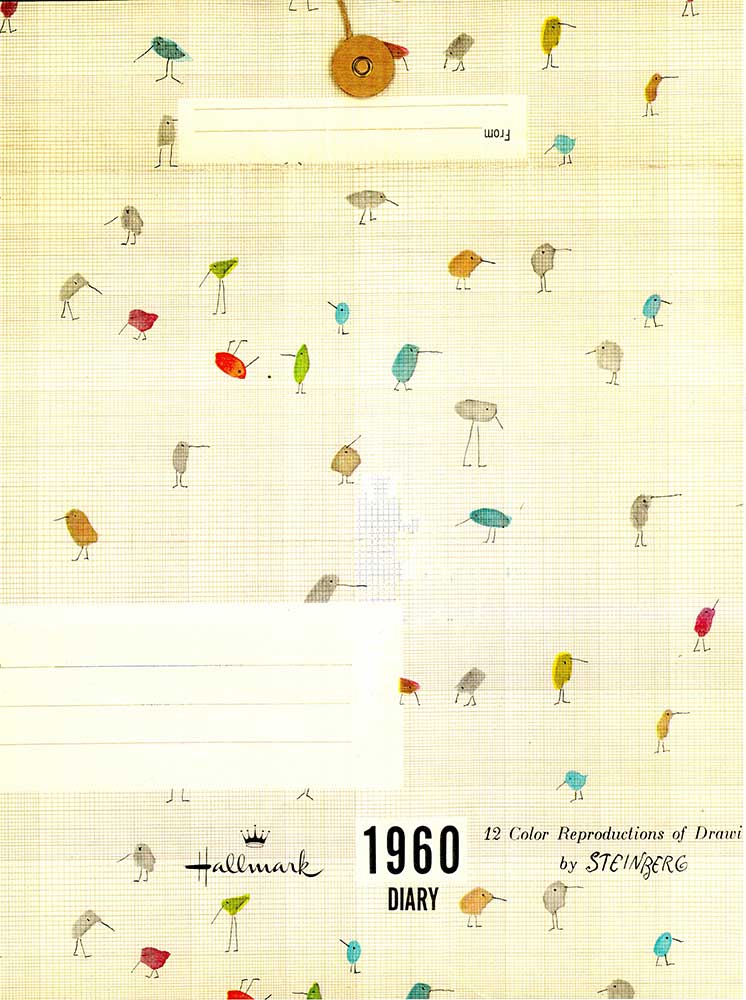
Is rereading all of James Joyce, “which now I understand—in part. A great loss of time not to have understood it years ago.”
